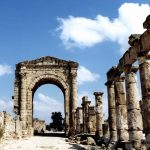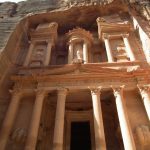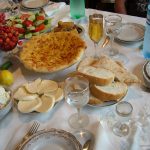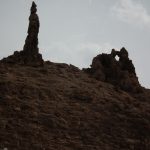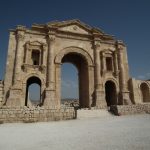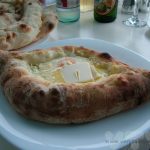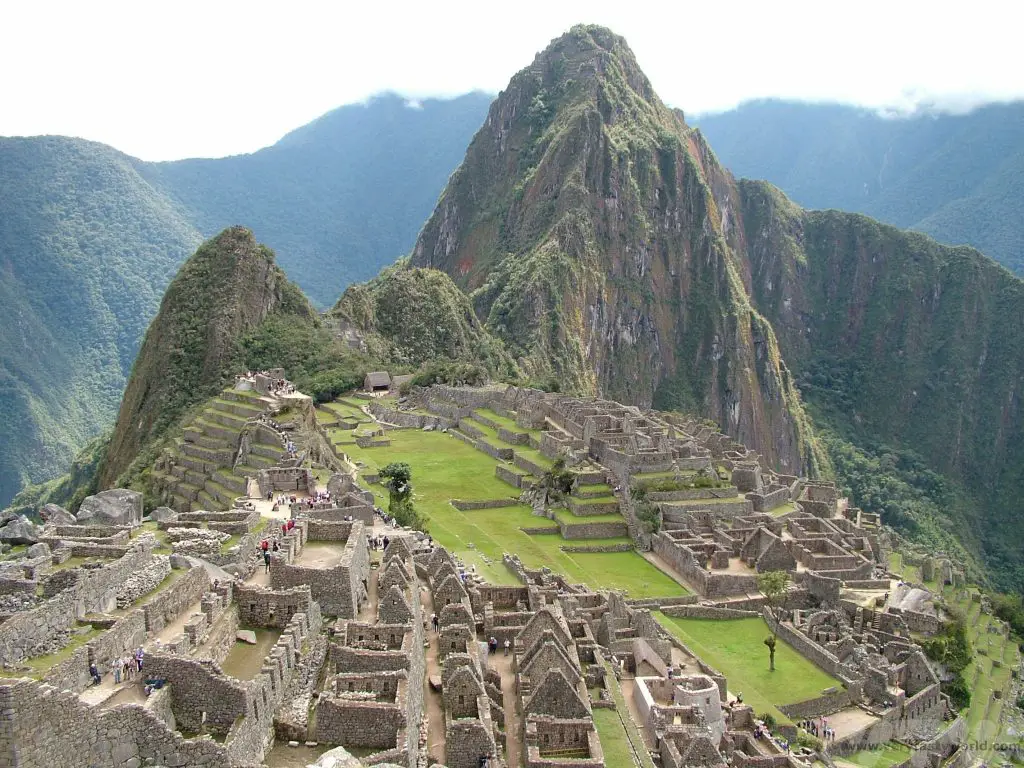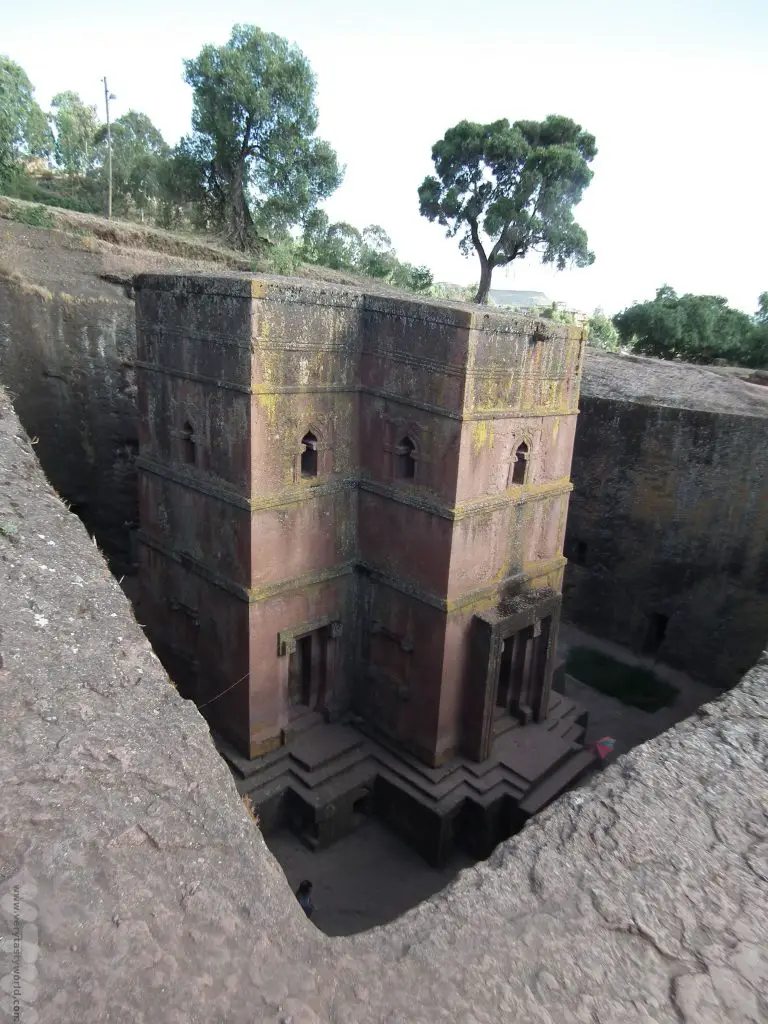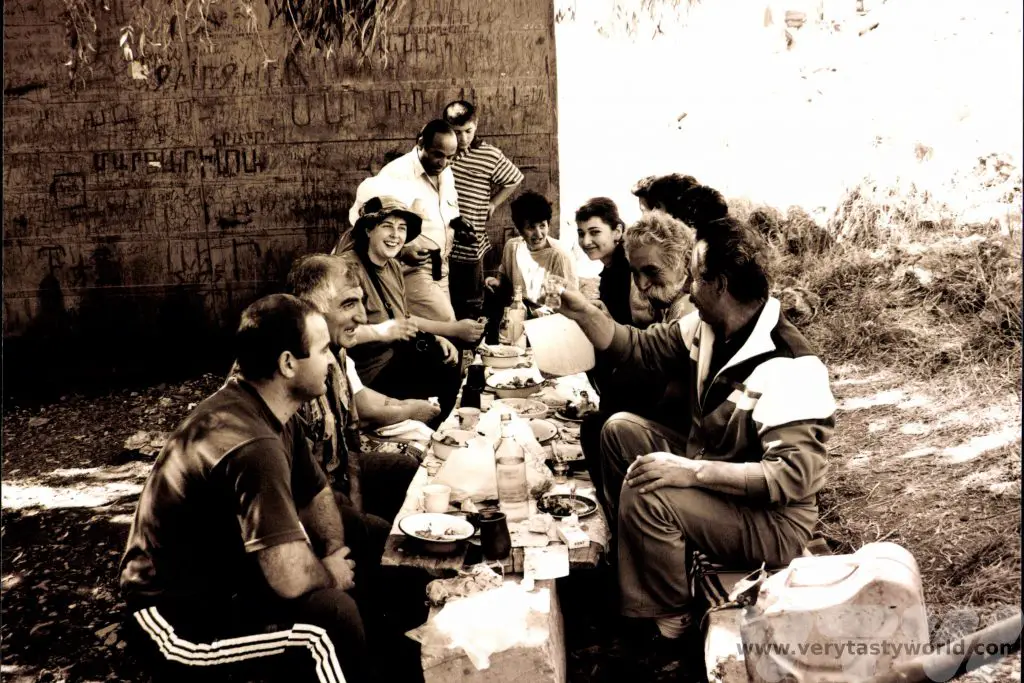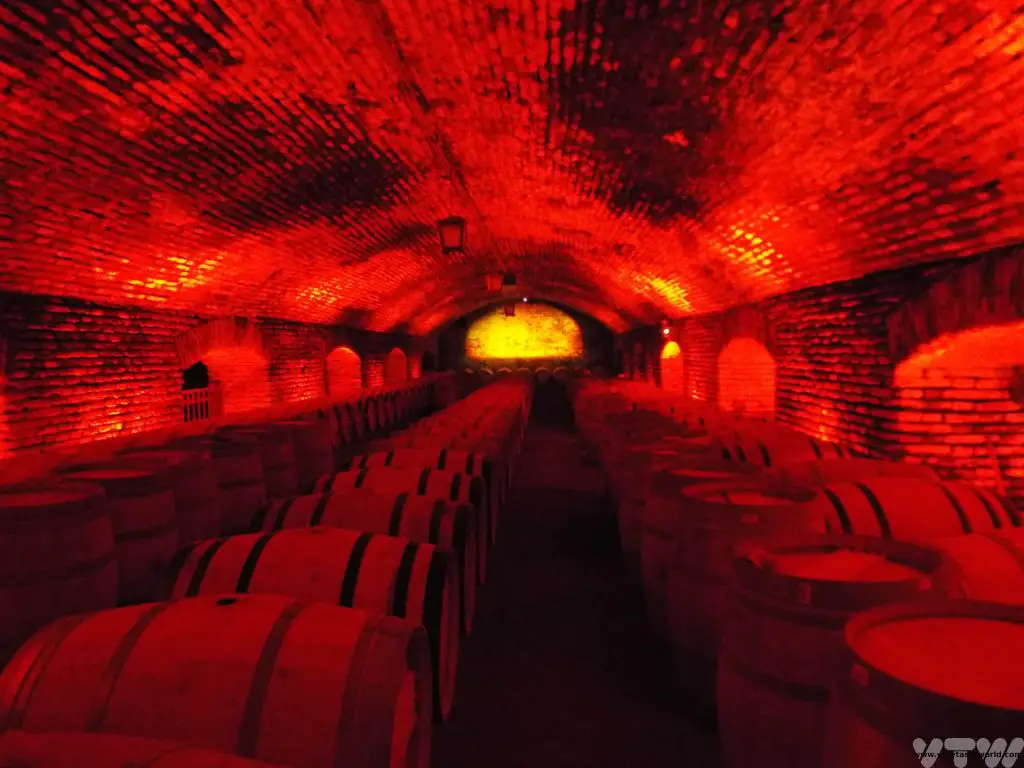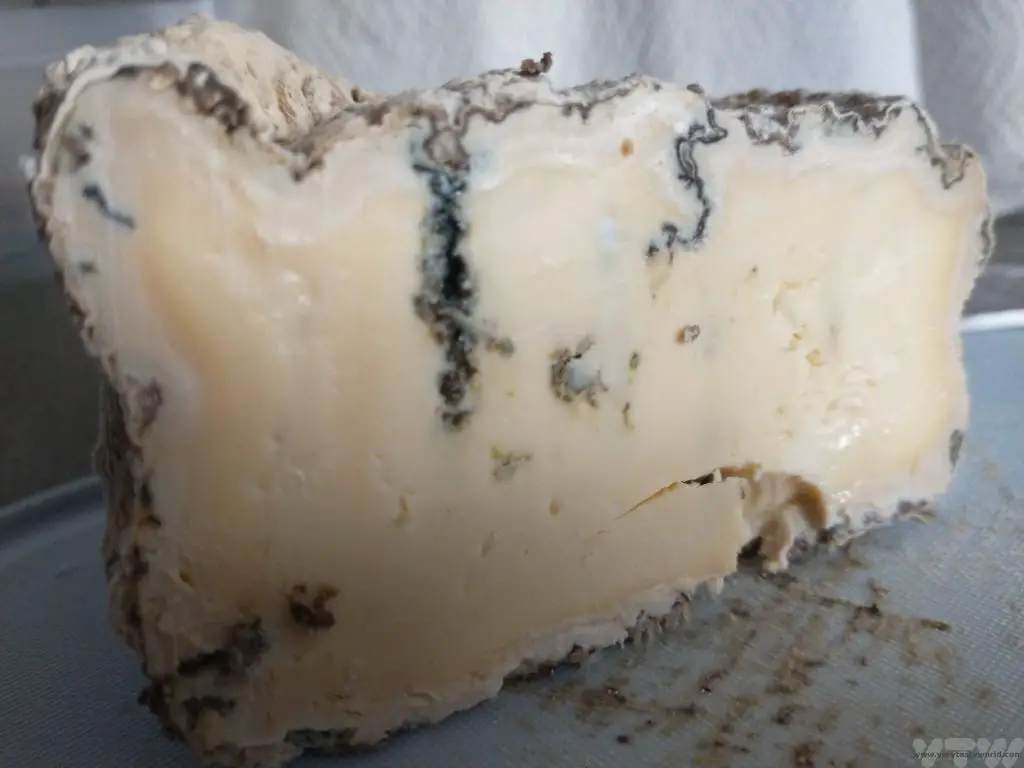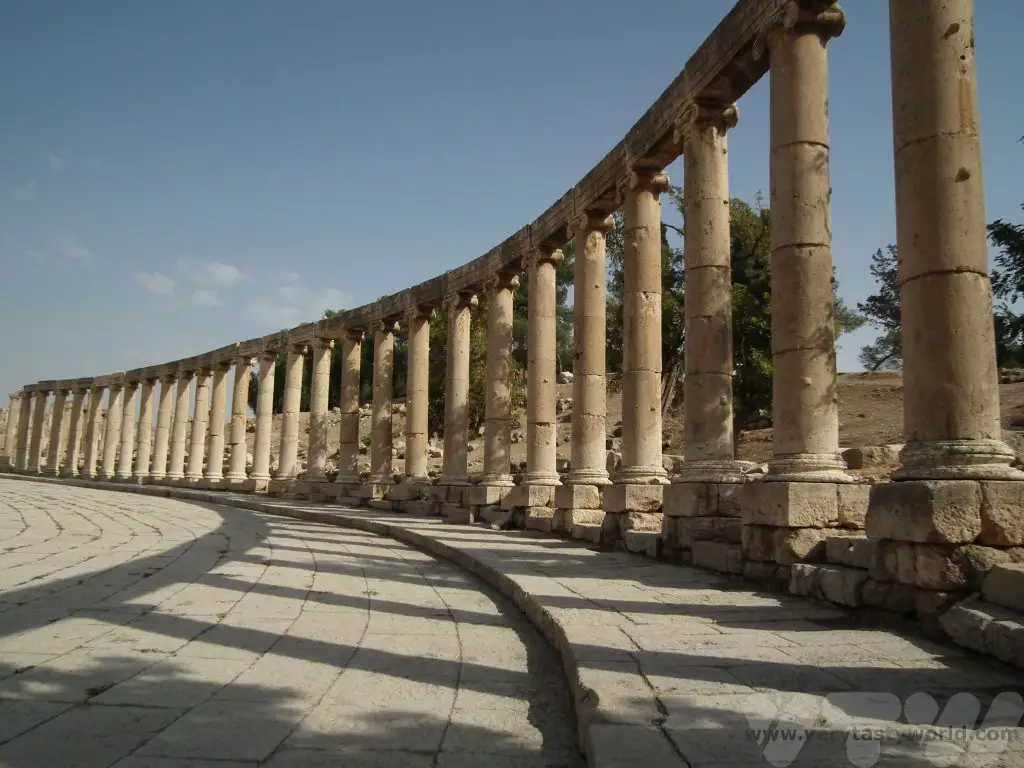Where To Go In Lebanon – A Visitor’s Guide
Lebanon is a really compact country. It’s easy to get pretty much anywhere from its capital, Beirut, within a couple of hours. Lebanon is about half the size of Wales (the standard international unit for country size), has the most fantastic Mediterranean coastline and, moving inland, also boasts wonderful mountain ranges and beautiful valleys. It has a long and fascinating history and some spectacular sites to visit. Here are some ideas for where to go in Lebanon.
The great thing about Lebanon is that it’s possible to visit most of the attractions from Beirut within a day so it is possible to stay there as a base. Another option would be to tour the country and stay in some of the locations that you visit. We would recommend the latter as some of the attractions are a couple of hours’ drive away which would leave less time to explore the sites.
There are good accommodation and restaurant options close to the popular attractions. And you can be assured of a very friendly welcome.
For full disclosure, it has been some years since we visited Lebanon. However, this post aims to show you some of the many places that visitors can enjoy.
Coastline
Many of Lebanon’s major towns and cities are located along its coastline. It has settlements dotted along it every 50km or so from north to south, or indeed from south to north; this distance apparently being about a day’s journey for sea traders in ancient times.
Beirut
Lebanon’s capital is the obvious place to start exploring this fascinating country. Beirut has a long and troubled history and is a city that is changing all the time. It was a prosperous trading city since the time of the Phoenicians and was the site of a famous law school in Roman times. Its location has ensured its position as a centre of commerce. Once dubbed the “Paris of the Middle East” in the middle of the 20th century, it gained a reputation as a place of glamour and decadence.
However, it suffered greatly during the Lebanese Civil War that took place between 1975 and 1990.
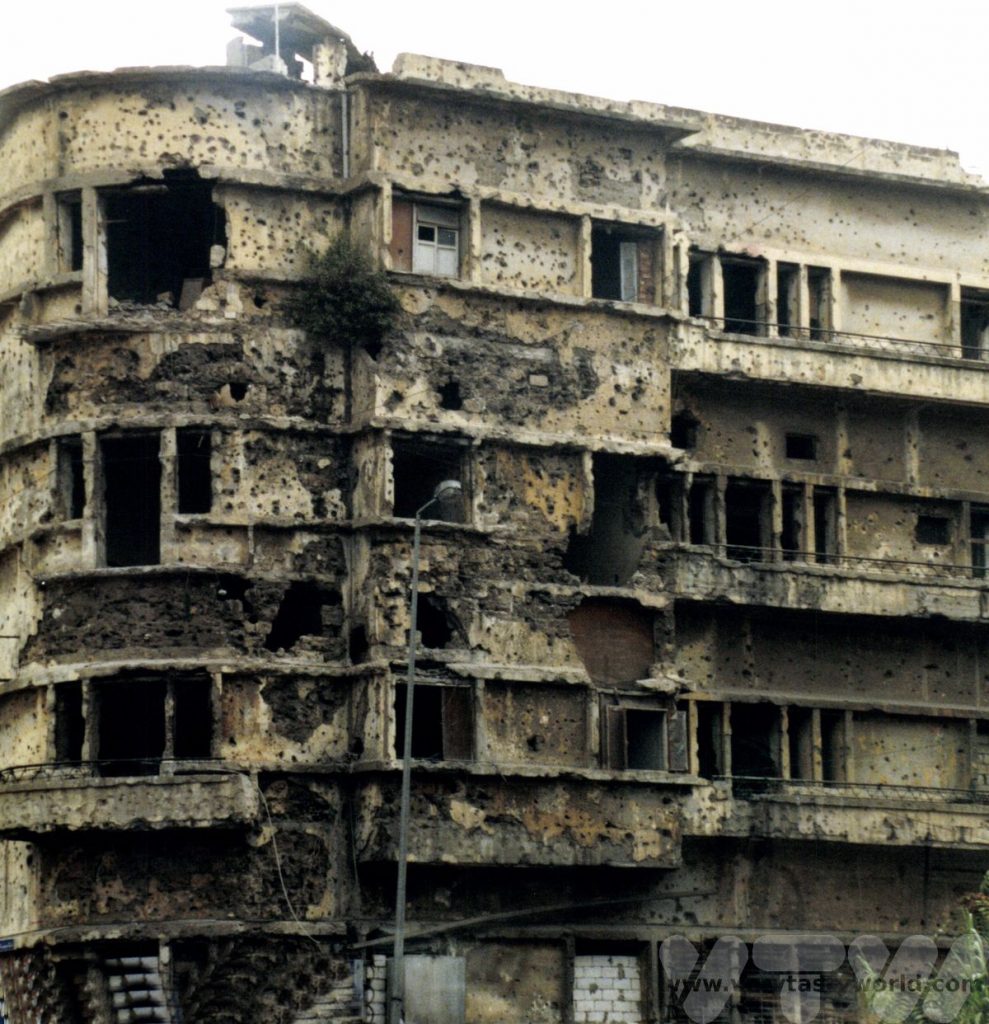
The city has a waterfront promenade called the Corniche, with two remarkable rock formations rising from the sea. They are called Pigeons’ Rock, which seems wildly inappropriate given their splendour. Rock of Raouché, for the neighbourhood they are located near, feels like a more suitable moniker.
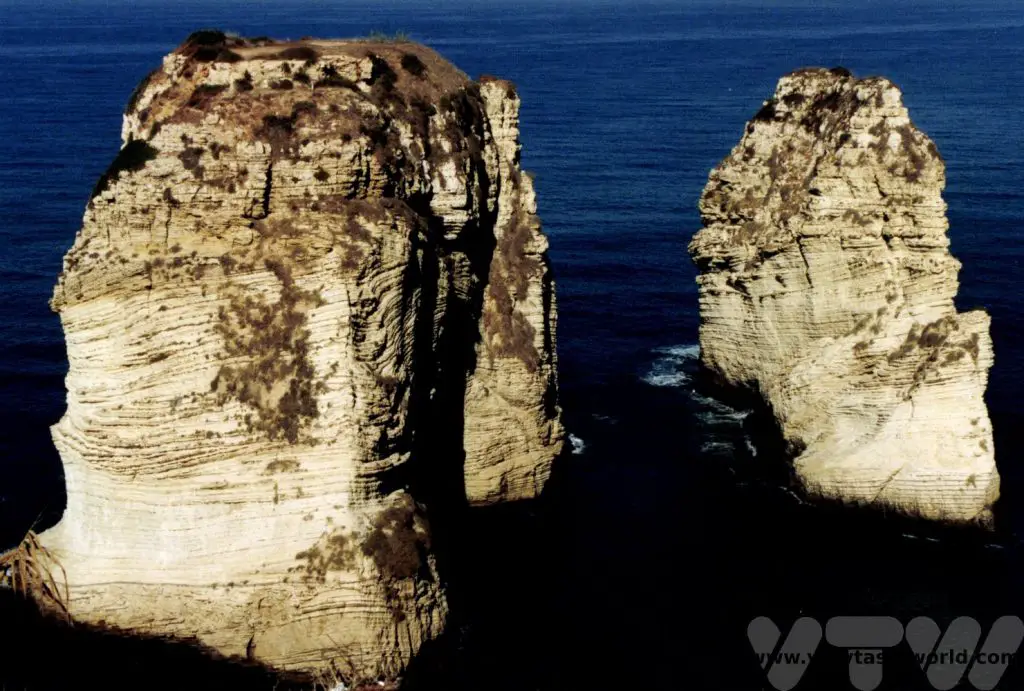
The National Museum is definitely worth setting time aside for. It is located on what was the Green Line during the Lebanese civil war and was significantly damaged as a result. However, it was renovated and restored to its former glory – a grand and imposing building. These days it hosts fascinating displays that exhibit Lebanon’s long and rich history.
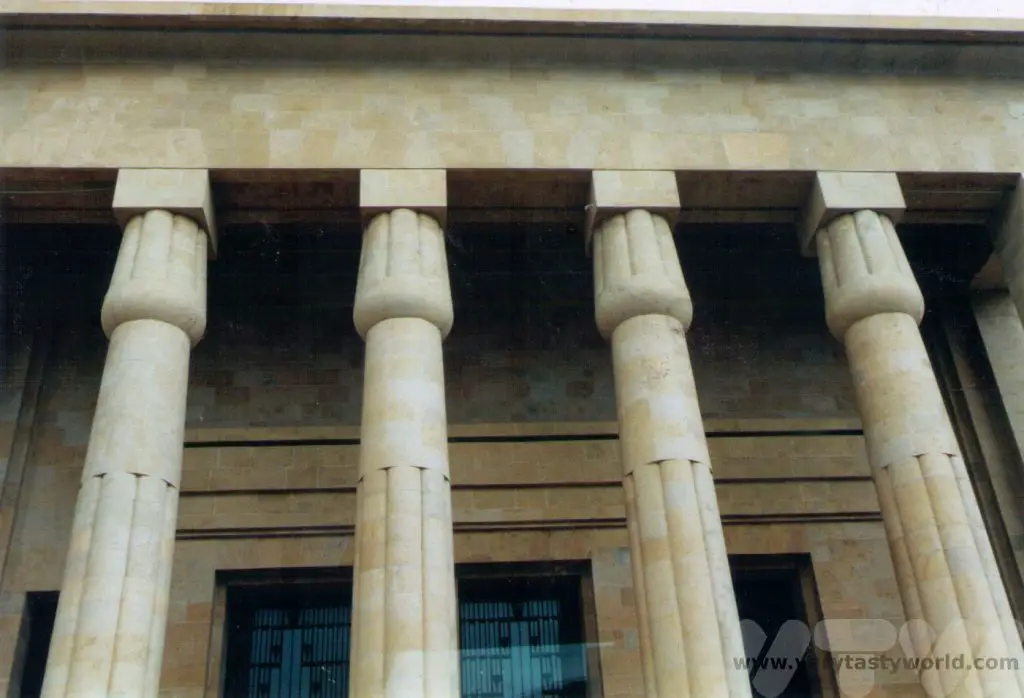
The Beirut Art Centre hosts regular exhibitions of Lebanese and international art.
Beirut has changed dramatically in the days since the war. The scarred buildings have been replaced with modern constructions. Sadly, a huge explosion at the Port of Beirut in 2020 damaged a significant part of the city. The Lebanese economy was in crisis at the time, and the blast has exacerbated this. But we have no doubt that this resilient city will rebuild once again one day.
Tyre
One of the oldest continuously inhabited cites in the world Tyre was founded in about 2750 BCE. The centre of the Phoenician civilisation, it was later conquered by the Greek, Roman, Byzantine, Muslims, Christian Crusaders and Mamluk civilisations. It is located around 85km south of Beirut, around 20km from the Lebanese border with Israel.
Many cities have thrived on their ability to produce a highly desired commodity and Tyre became famous for the Tyrian purple dye, derived from a type of mollusc, that was so expensive and exclusive that only royalty could use it. (Our own city of Coventry became famous for its blue dye – known as Coventry Blue which held fast and coined the phrase, ‘true blue’.)
There are extensive Roman ruins to explore in Tyre – the UNESCO heritage sites of Al Mina and Al Bass.
At Al Bass the hippodrome is enormous in its scale, and considered to be one of the largest and best preserved in the world. It was primarily used for chariot races – you can imagine the excitement of the crowds cheering the horse and carriages thundering round the track.
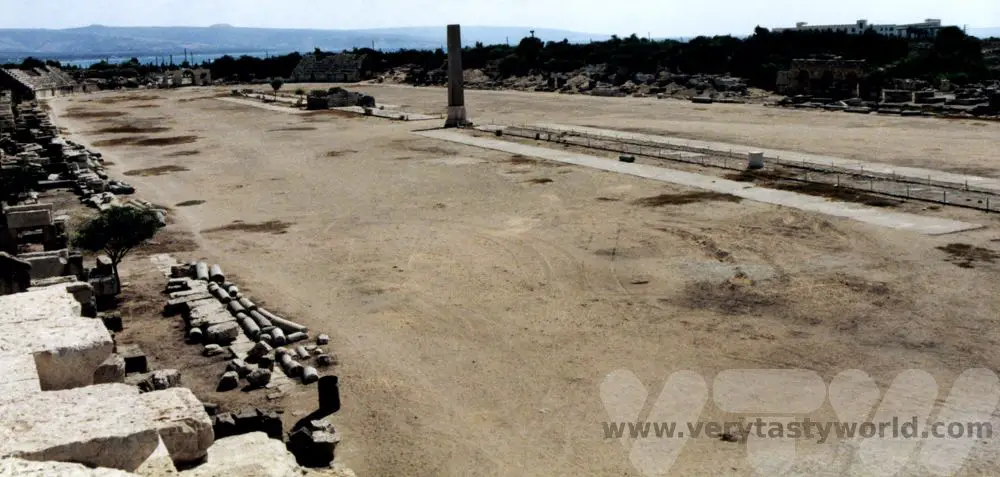
Al Bass also boasts a triumphal arch and necropolis.
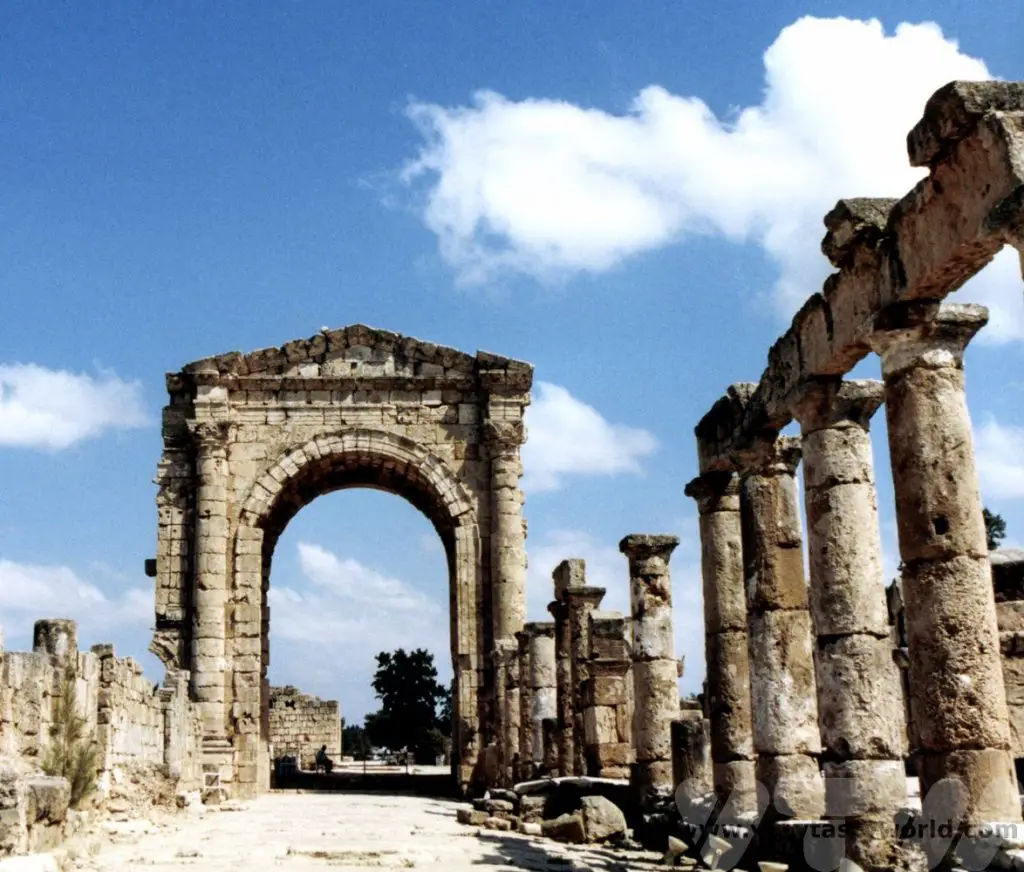
Al Mina is located close to the sea and you can walk along the colonnaded street.
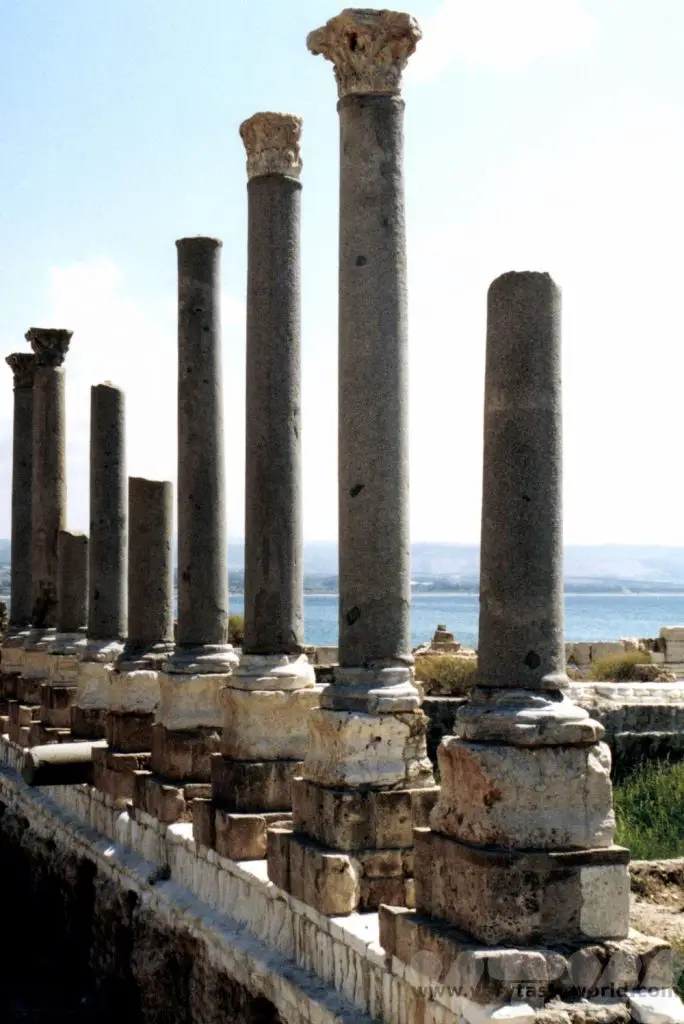
It is interesting to see the ruins continue into the Mediterranean, a legacy from when sea levels were lower.
Sidon
Another city with a long history, Sidon is located around half-way between Tyre and Beirut. It is thought to have been inhabited as early as 4000 BCE.
Its main attraction is the sea castle, built in 1228 by Christian crusaders, on a small island which is connected to the mainland via a bridge. It is thought that it was built upon a Phoenician temple – there is evidence of a Phonecian settlement under the sea nearby. It has been partially destroyed and renovated over the years. There is a small domed mosque, built during the Ottoman era, that sits atop the castle.
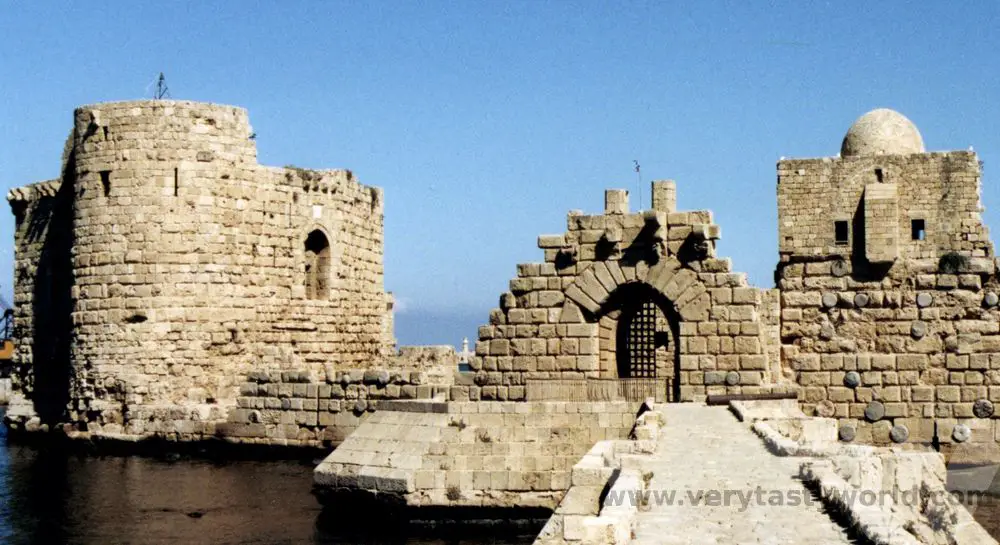
The medina is another essential place to visit – a labyrinth of alleyways in the old stone city, it’s perfect for exploring and getting lost in. There is a soap museum which was originally a factory. You can see the ingredients and understand the techniques used to make soap. And, of course, buy a bar or two.
Beiteddine
Beiteddine is located south-east of Beirut and is easy to visit as a side trip when seeing Sidon. It is an Ottoman palace built between 1788 and 1818 and set in a lovely valley close to Deir el Qamar. The palace itself is a place of very great beauty – with gorgeous architecture throughout it is adorned with mosaics and has serene courtyards and fountains.
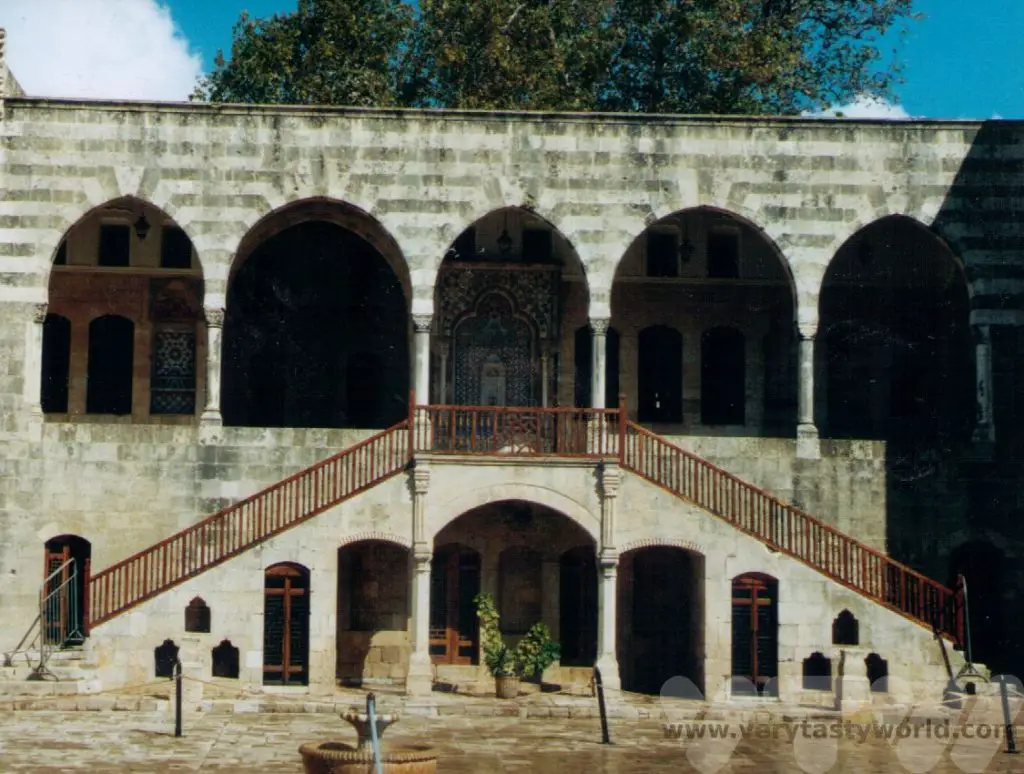
Many of the interiors are carved with cedar wood. It is also the location of the Beiteddine Art Festival which is held every year and showcases the work of local and international artists.
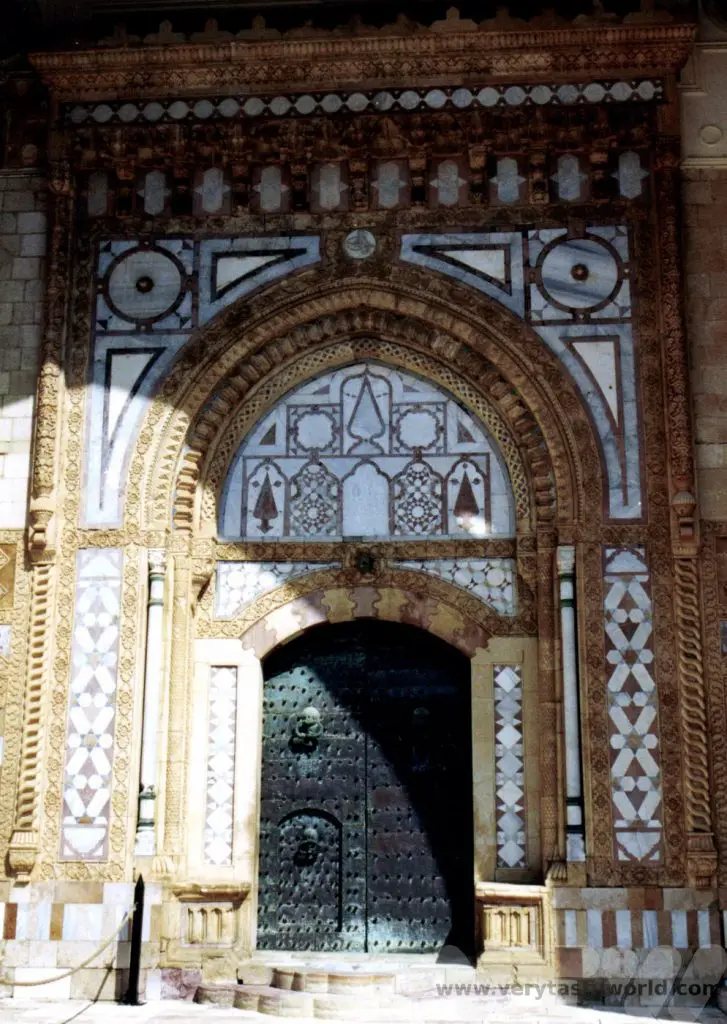
Byblos
North of Beirut, Byblos also has a claim to being the world’s oldest continuously inhabited town. The Phoenicians developed their alphabet there and it is thought that the word ‘bible’ is derived from Byblos. It is a fascinating town to explore with its castle and museums.
The Crusaders arrived in 1103. They called the town Gibelet, after the Lords of Gibelet, members of the Embriaco family from Genoa. They built a castle which was sacked when Saladin attacked the town in 1188 and parts of the walls were taken down.
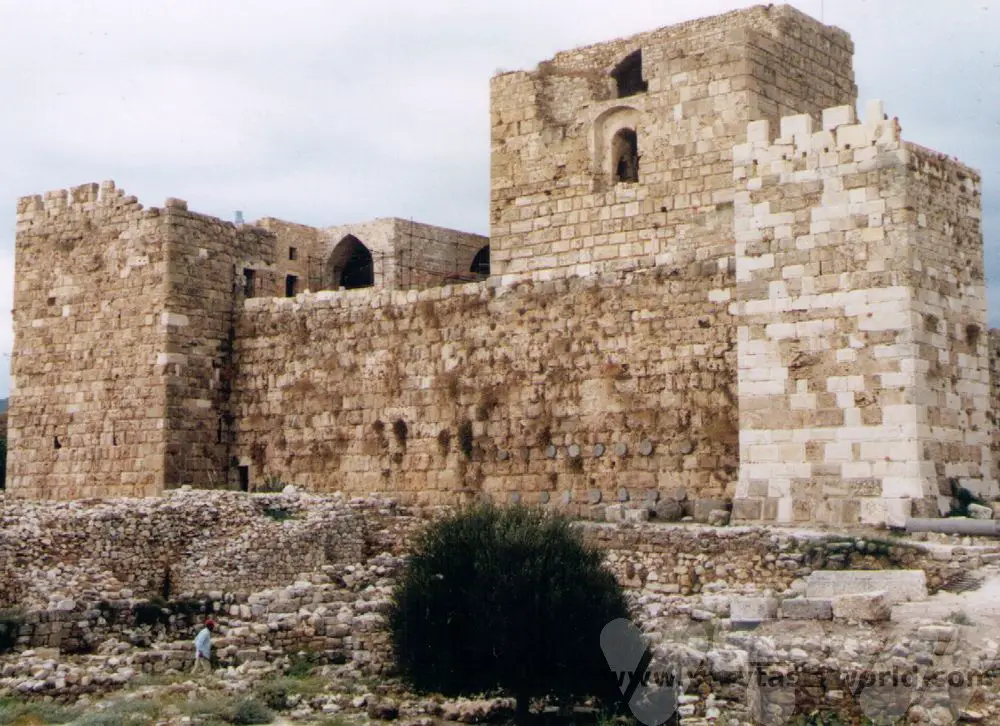
The town was then recaptured in 1197 by the Crusaders and the castle’s fortifications reinforced. They remained in power until the 13th century.
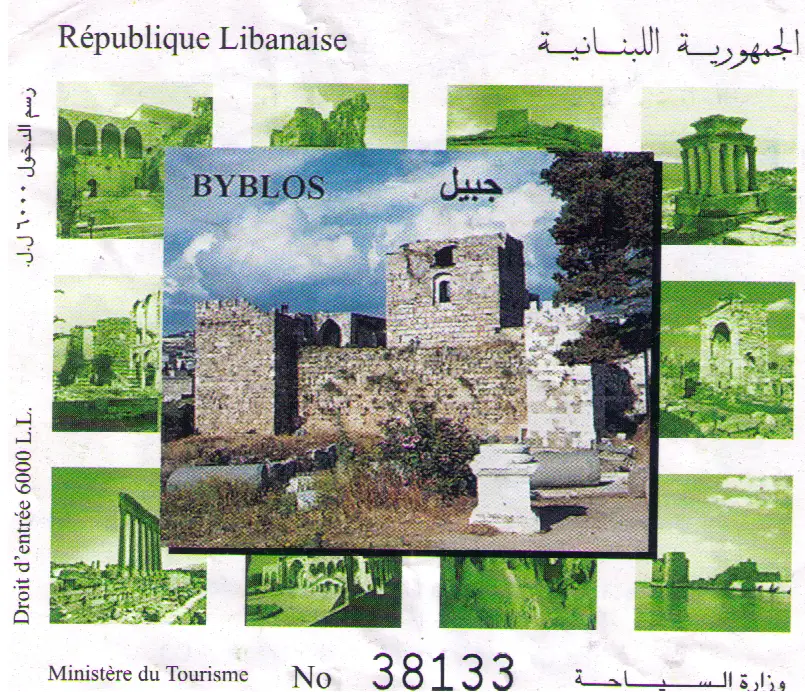
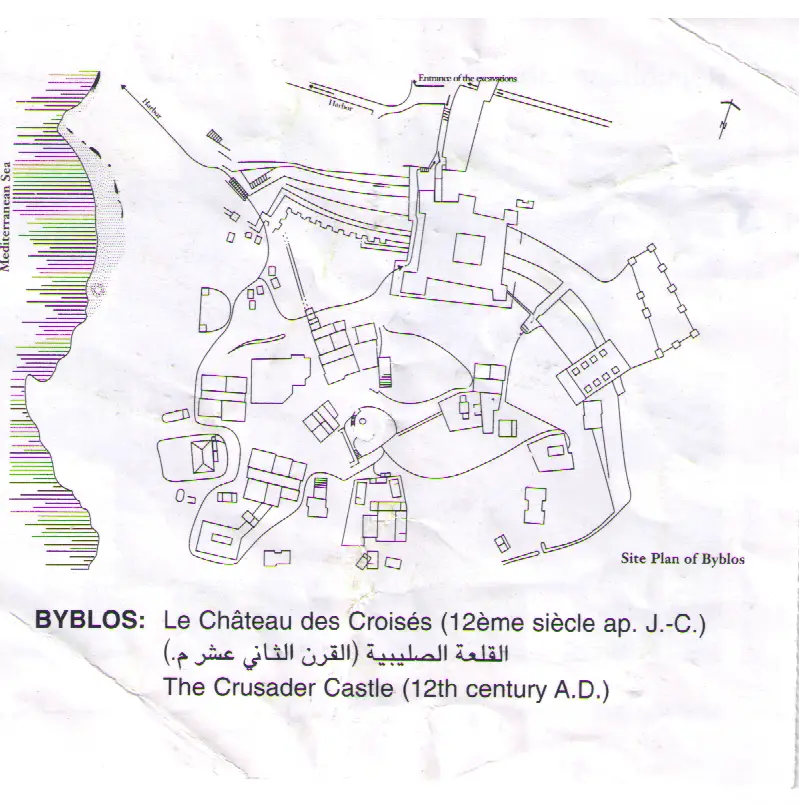
Byblos boasts an excellent beach and also has number of bars and restaurants by the harbour area where you can enjoy a drink or mezze watching the sun set over the sea.
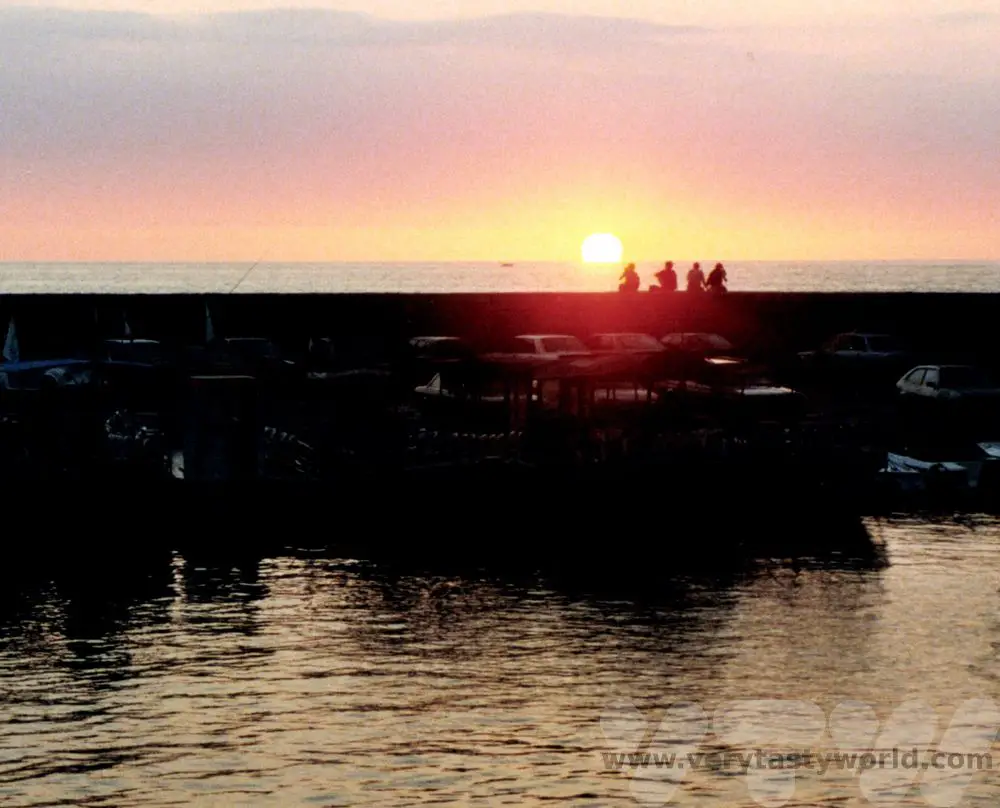
Tripoli
Further north up the coast Tripoli was a town where we particularly enjoyed exploring the souks. Everywhere we went we were welcomed warmly. One of Tripoli’s main attractions is the Citadel of Raymond de Saint-Gilles, a crusader fortress originally constructed in 1103 which has been rebuilt over the centuries.
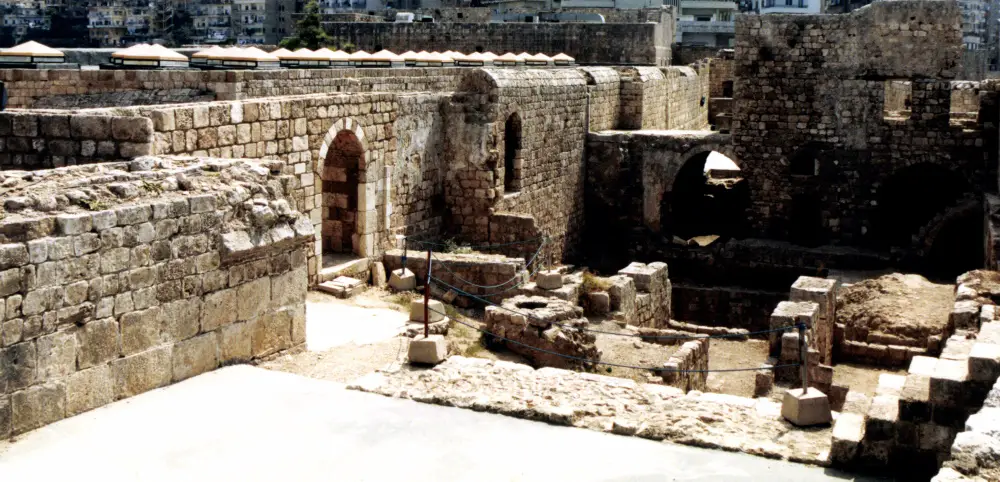
It’s a great place to explore and you can climb onto the walls to get spectacular views of the city.
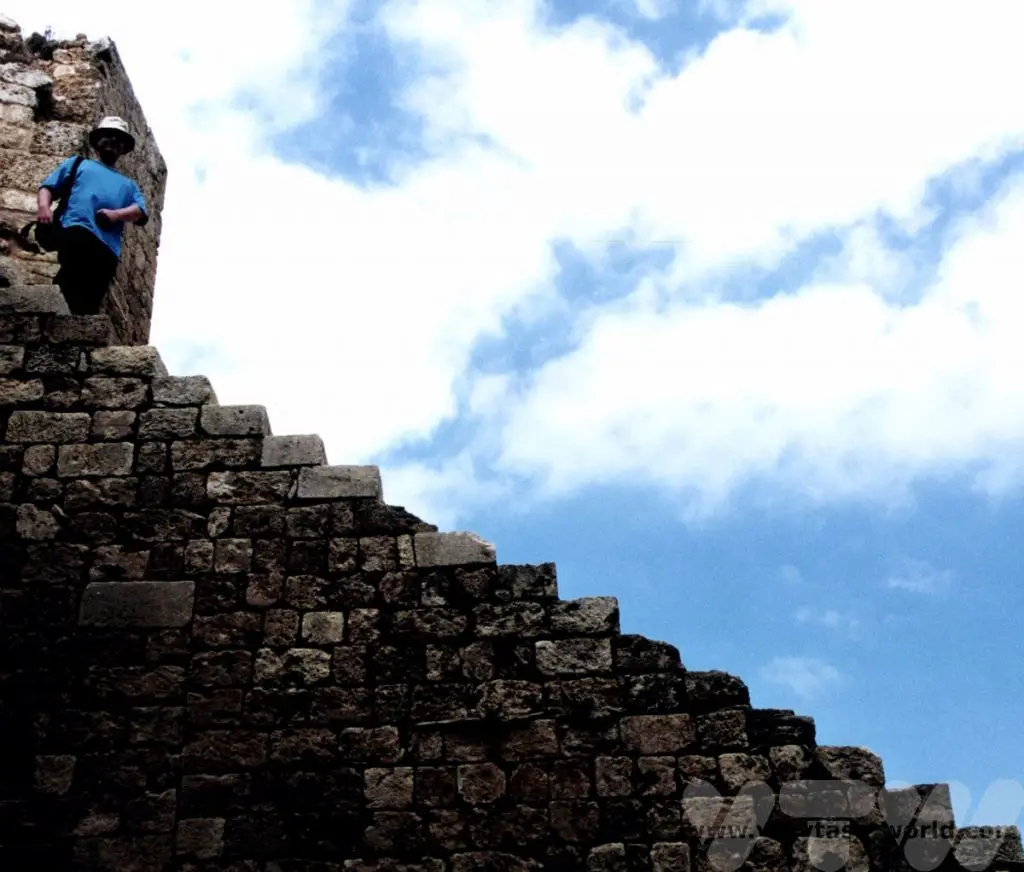
Going Inland
Qadisha Valley and Bcharre
The Qadisha valley is a beautiful area at the foot of Mount al-Makmal and is home to a number of Christian monasteries. Qadisha means ‘holy’ in Aramaic and the river, Nahr Qadisha, flows through the valley. There are some lovely walks in the area.
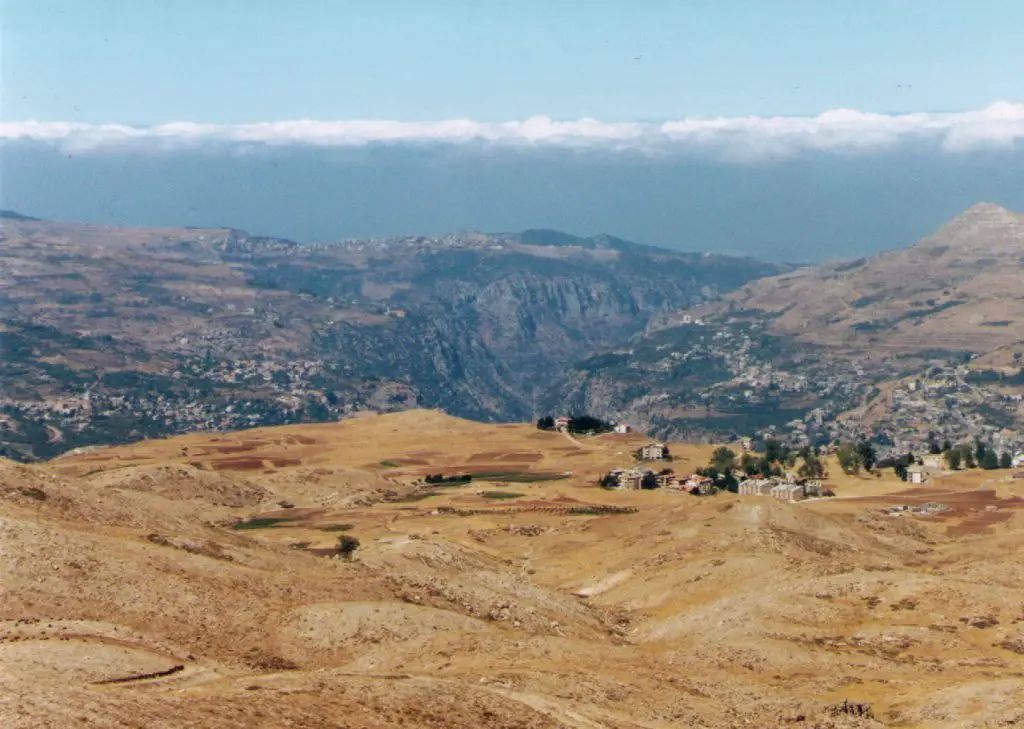
It was here that we discovered Kahlil Ghibran, a Lebanese poet, artist and philosopher, who was born in Bcharre. There is a fascinating museum dedicated to his life and works in the former monastery of Mar Sarkis. His book, The Prophet, a series of 26 fables in the form of poems, is one of the most translated books in history and has never been out of print since its publication in 1923.
The source of the Nahr Qadisha lies in a cave and is located very close to the Cedars of Lebanon. These are known as the Cedars of God and comprise hundreds of trees, some of which are thought to be over 1000 years old.
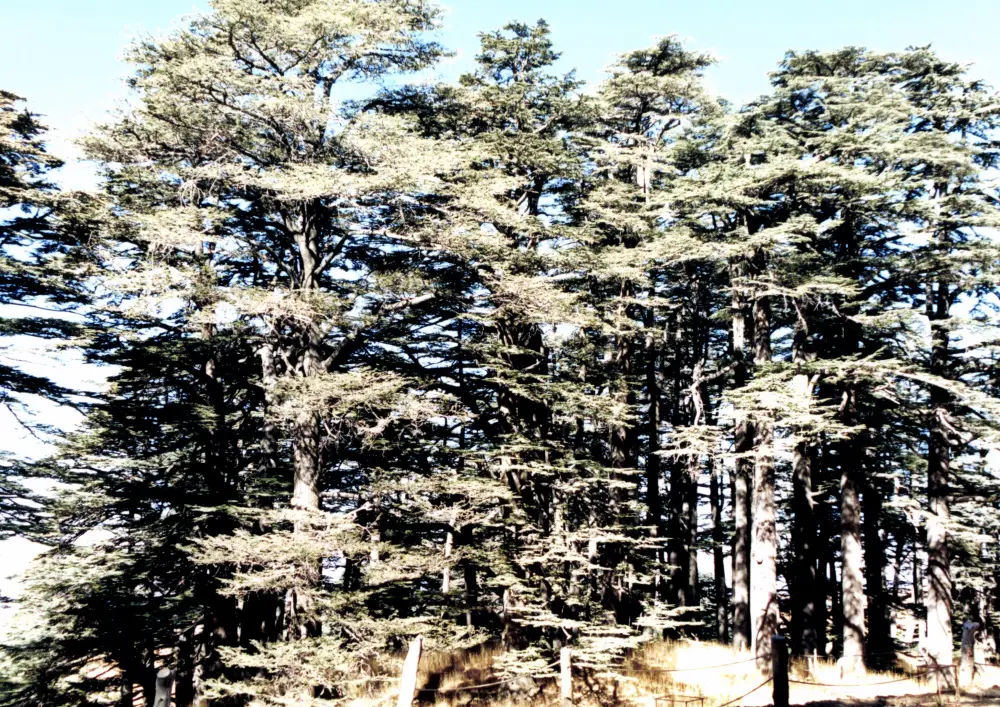
These trees are so important to the country’s heritage and culture, Lebanon’s flag features the cedar at its emblem.
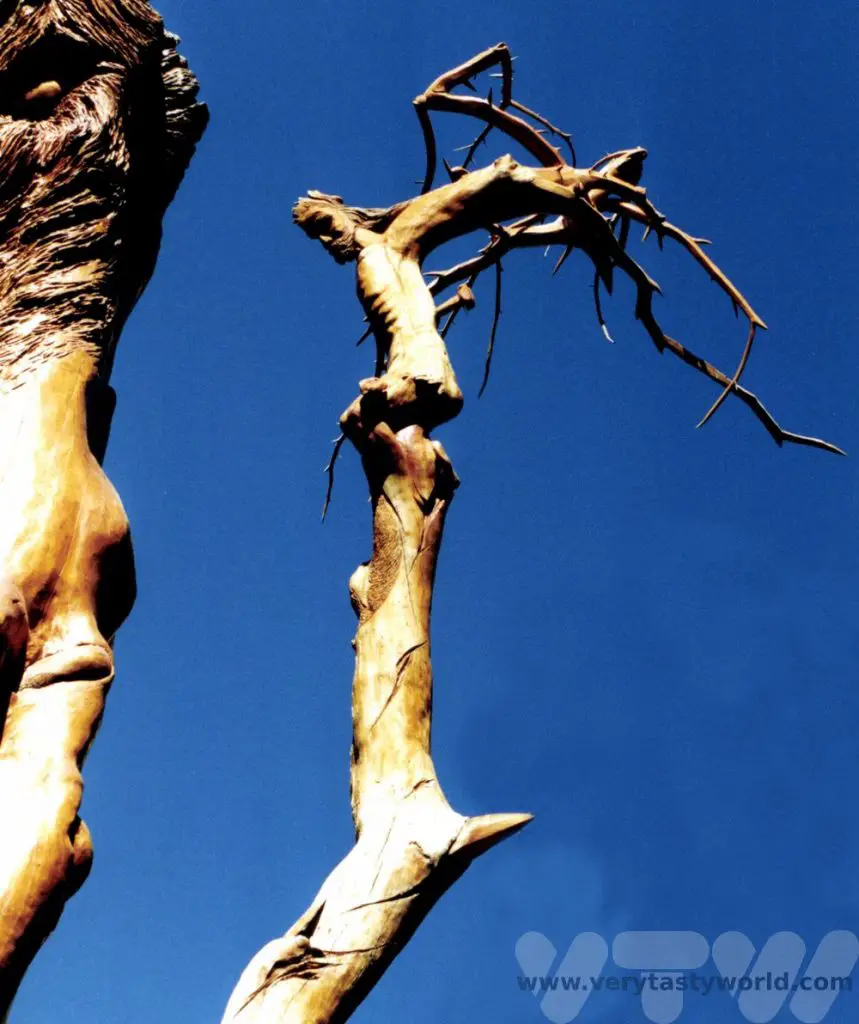
Crossing the Lebanon mountain range into the Beqaa Valley we arrived at Baalbek.
Baalbek
There are many spectacular ruins throughout the Middle East, including in Lebanon and also the Roman city of Jerash in Jordan. But the ruins at Baalbek, a UNESCO site, are astonishing in their scale.
Baalbek was known by the Greeks as Heliopolis, which means ‘Sun City’, and was the place where the Phoenicians worshipped the sun god Baal.
The Temple of Jupiter is the largest complex and, even though it has suffered extensive damage over the years, is still hugely impressive. It is thought that construction started in around 16 BCE.
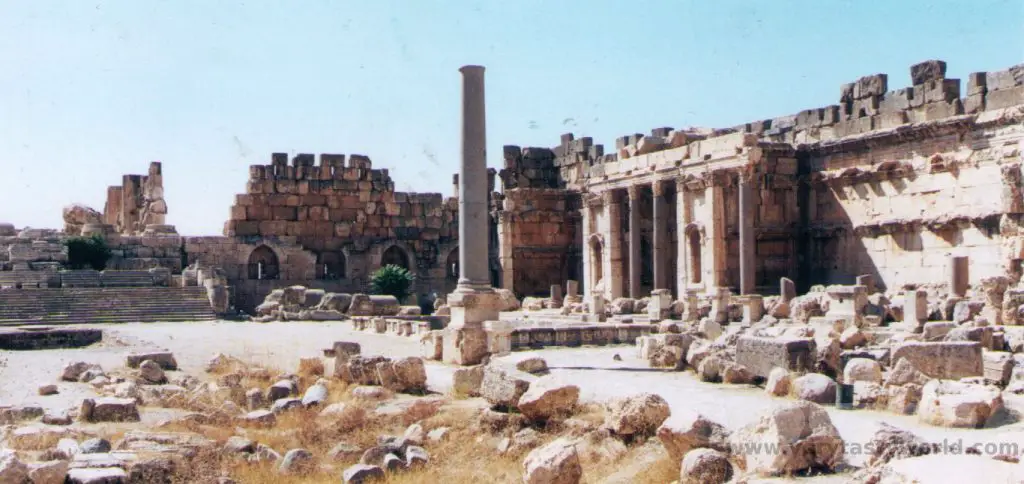
The temple comprises a main plaza set upon a large base comprising foundation walls and a podium. It holds many archaeological mysteries, notably the enormous monoliths from which the walls were constructed – they weigh between 300 and 1200 tonnes. The stones came from a nearby quarry but it is not fully understood how they were placed as it is believed that known Roman construction equipment of the time would not have had the capacity to move them. It’s possible that a bespoke crane was constructed for the purpose or the stones may have been rolled downhill from the quarry.
Originally the temple was encircled by 54 columns, but only 6 remain intact.
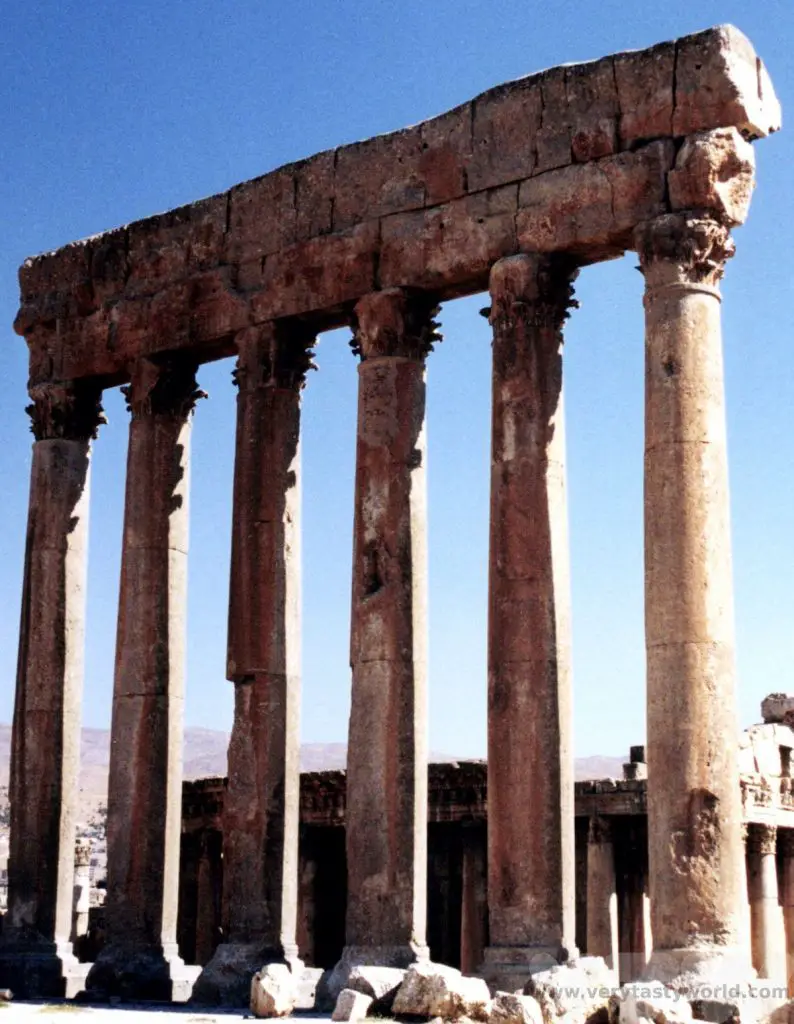
The Temple of Bacchus is the best preserved of all the temples as it had been partially buried and hence was protected from multiple earthquakes over the centuries. It was thought to have been completed in 190 CE by Septimius Severus.
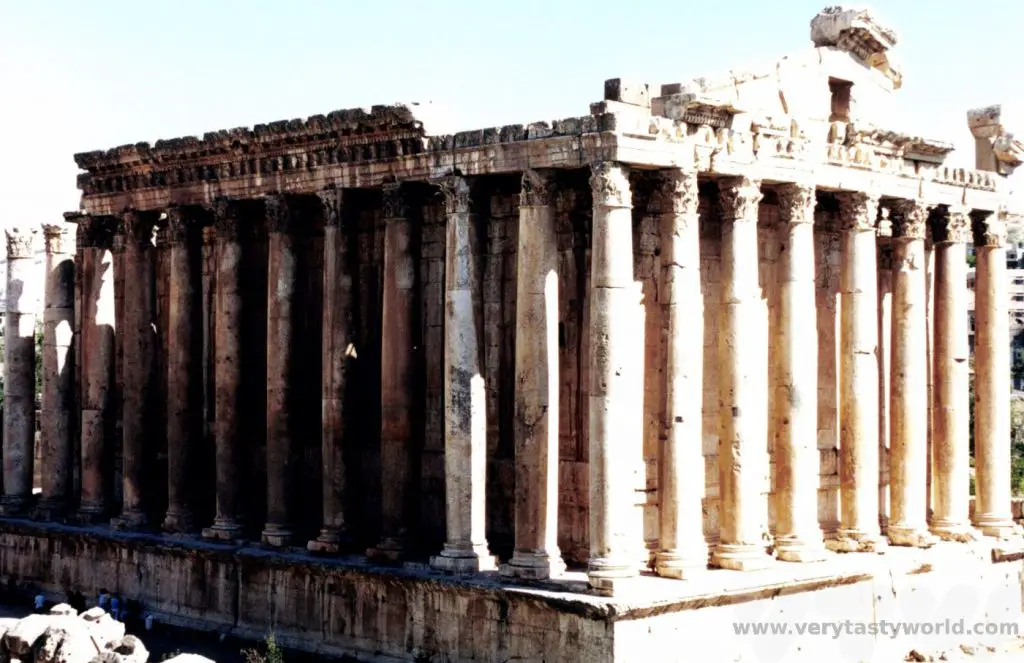
It’s a splendid structure with remarkable details in the stonework showing vines, poppies and wheat, symbols of Bacchus and highly appropriate for the god of wine and festivities. Sometimes you can get lucky and have the whole place to yourself!
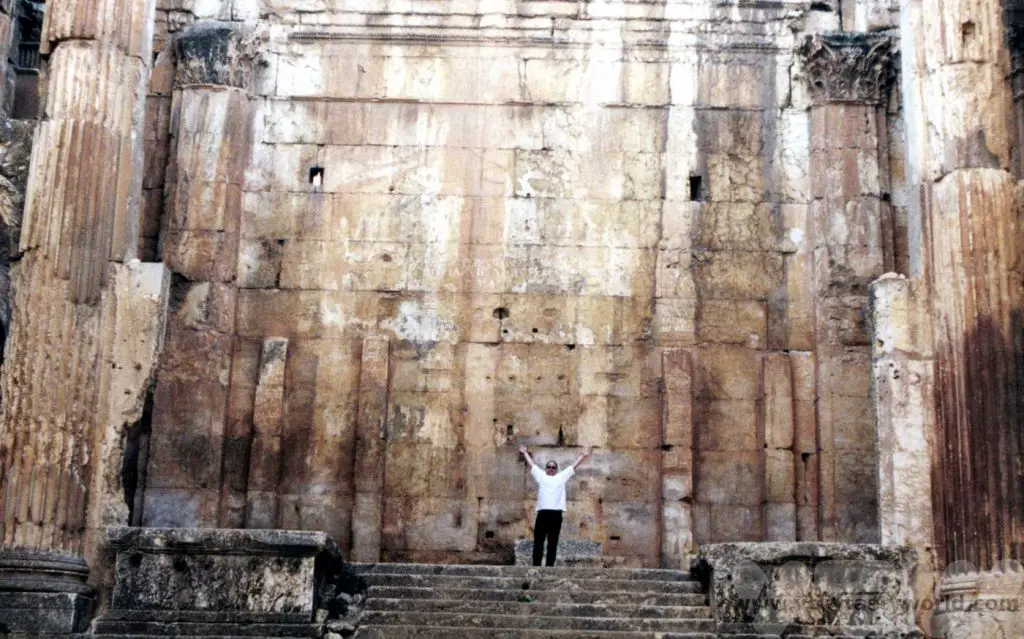
The final temple is the Temple of Venus, also known as Nymphaeum.
A special mention has to go to the Palmyra Hotel in Baalbek, a glorious, decadent building that was built in 1874 and has remained open ever since. Filled with original Jean Cocteau paintings it has hosted artists, musicians, writers, celebrities and even royalty over the decades. It has most definitely seen better days but was a fabulous place to stay.
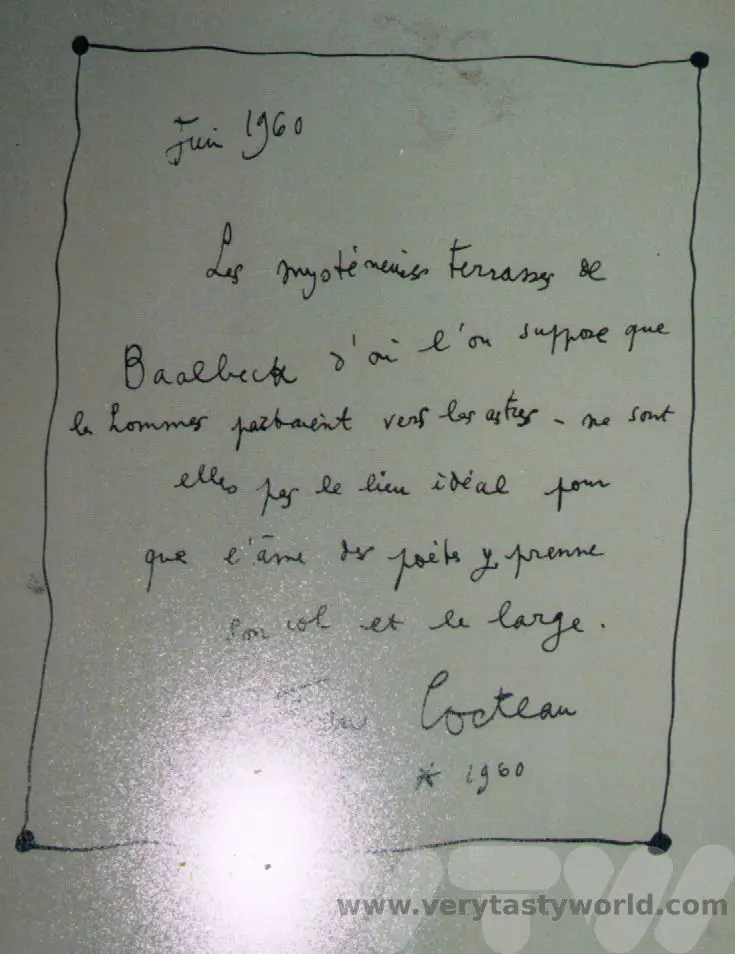
Anjar
Anjar is a fortified town that is completely different to other sites in the country. It was a city developed during the early 8th century CE and is the best example of an inland centre of commerce in the region. The Umayyads, the first hereditary dynasty of Islam, created an empire from around 660 to 750 CE. They were highly skilled in planning and development and the empire prospered until they were defeated by the Abbasids.
It’s a fascinating site to explore. Umayyad Caliph Walid I commenced construction in 714. Based on a Roman layout , Anjar had over multiple shops, a Grand Palace, a mosque and thermal baths. However, the site was later abandoned.
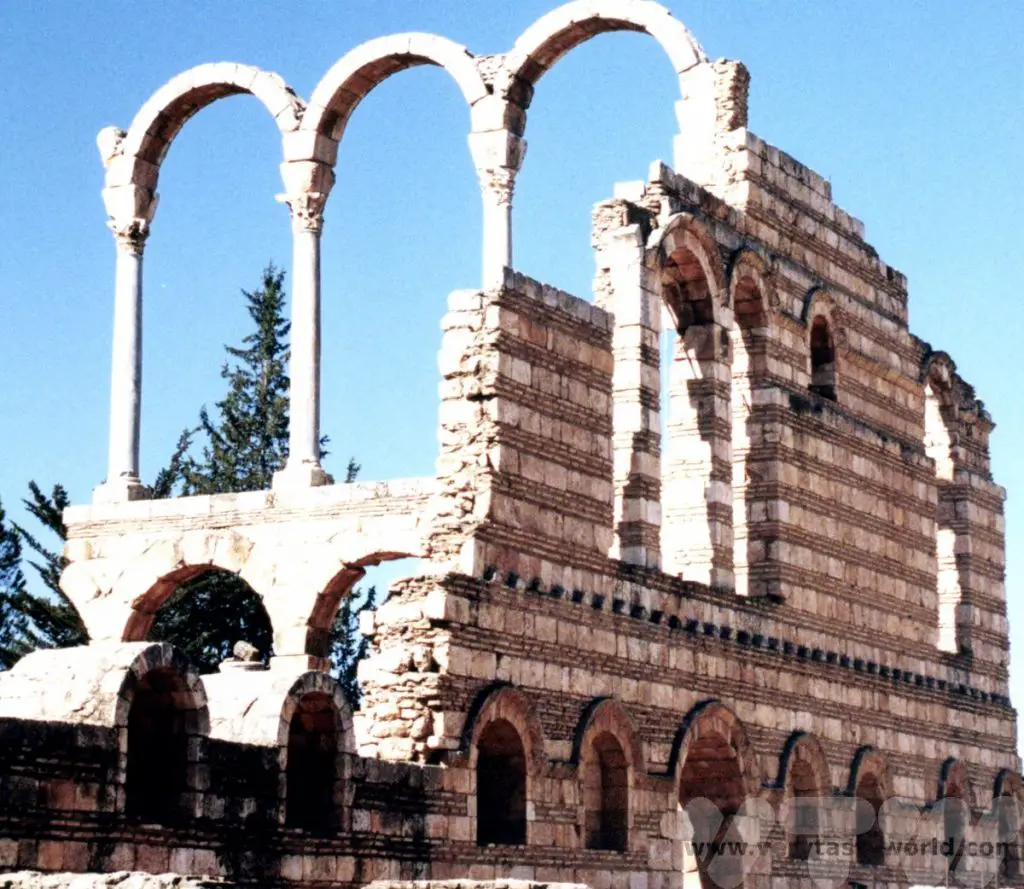
The Grand Palace is one of the best preserved ruins. It has an impressive courtyard that is heralded by magnificent arches.
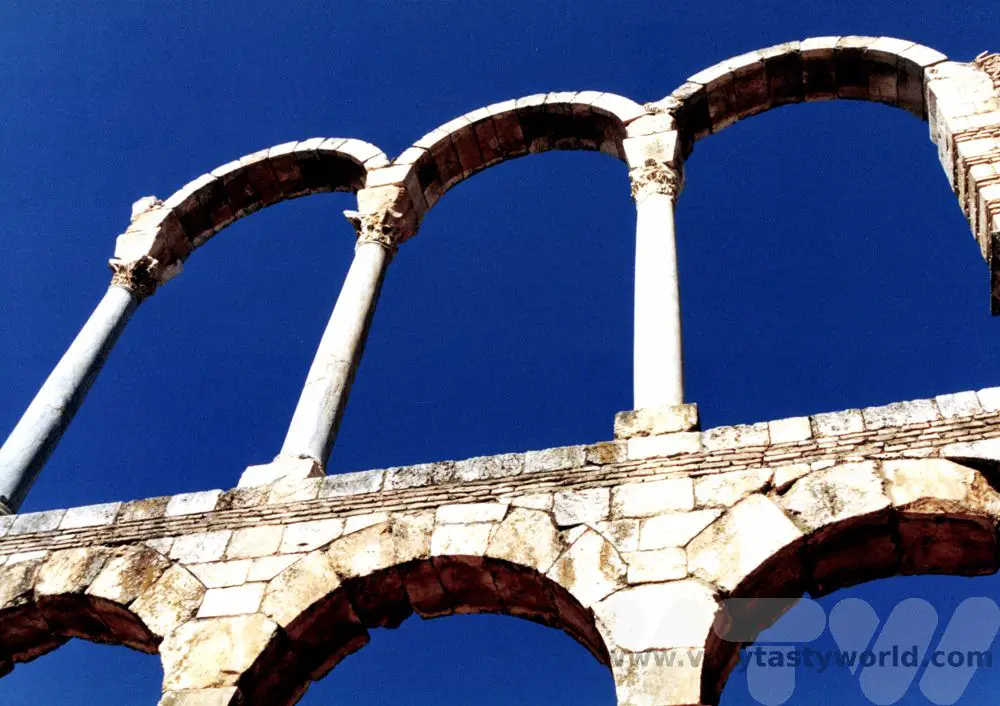
Lebanese Food and Drink
A trip to the Middle East wouldn’t be complete without a mezze. Mezze is often described as middle-eastern tapas – a selection of small dishes shared by everyone at the table. It’s a lovely, sociable way of eating and you can get to try a variety of dishes.
Amongst the many dishes on offer we had creamy hummus heavily laced with tahini and drizzled with olive oil, smoky baba ganoush (aubergine dip), crispy falafel (deep fried chickpea fritters), foul (bean stew, pronounced ‘full’, not ‘fowl’!), spicy, herby kibbe (small meatballs of lamb mince and cracked wheat), cauliflower tarata (a sauce of tahini sesame paste, lemon juice, garlic, and parsley), multiple salads, including fattoush, which has lots of bread to soak up the lemony olive oil dressing. All enjoyed with delicious flatbreads and sometimes chips.
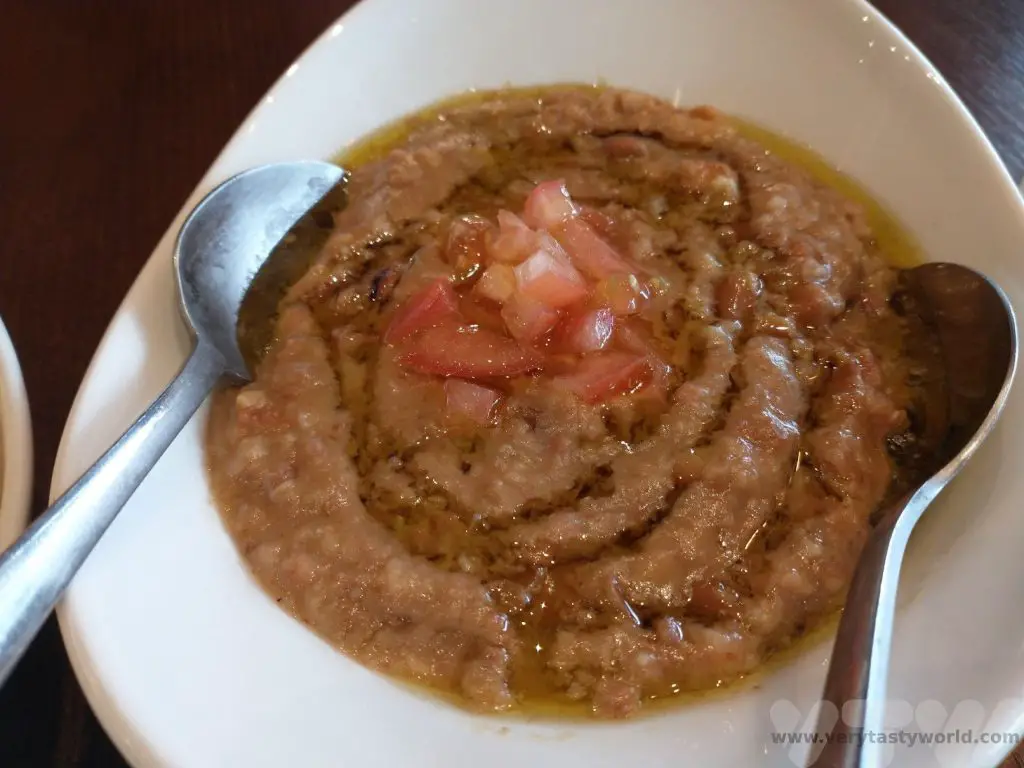
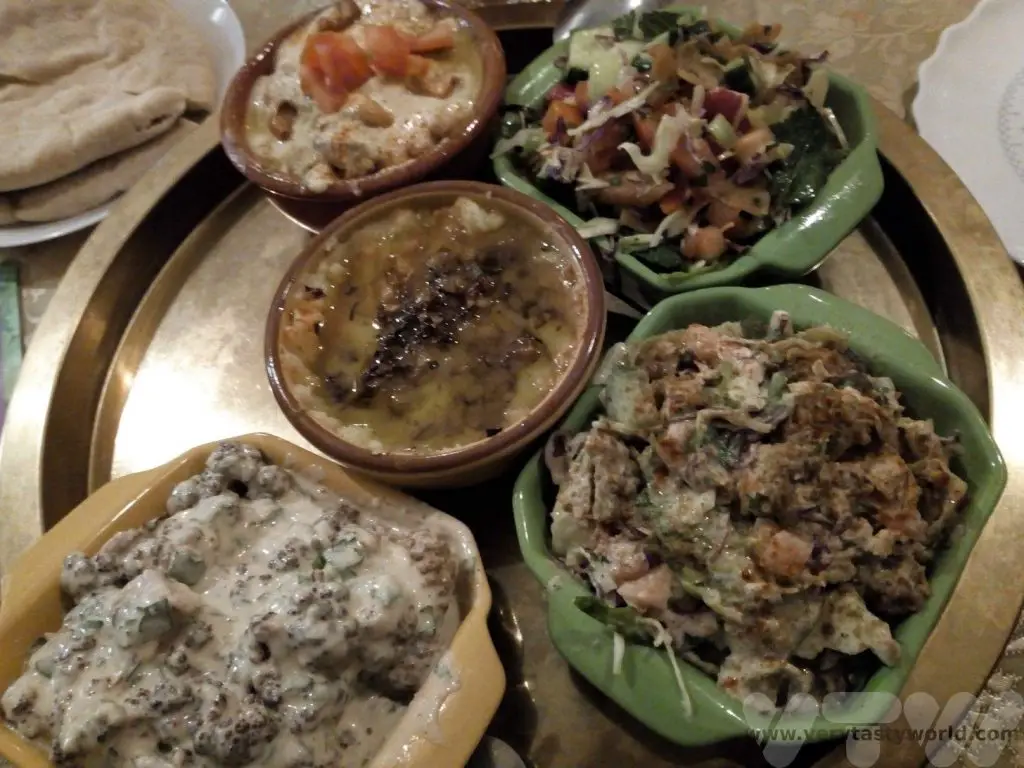
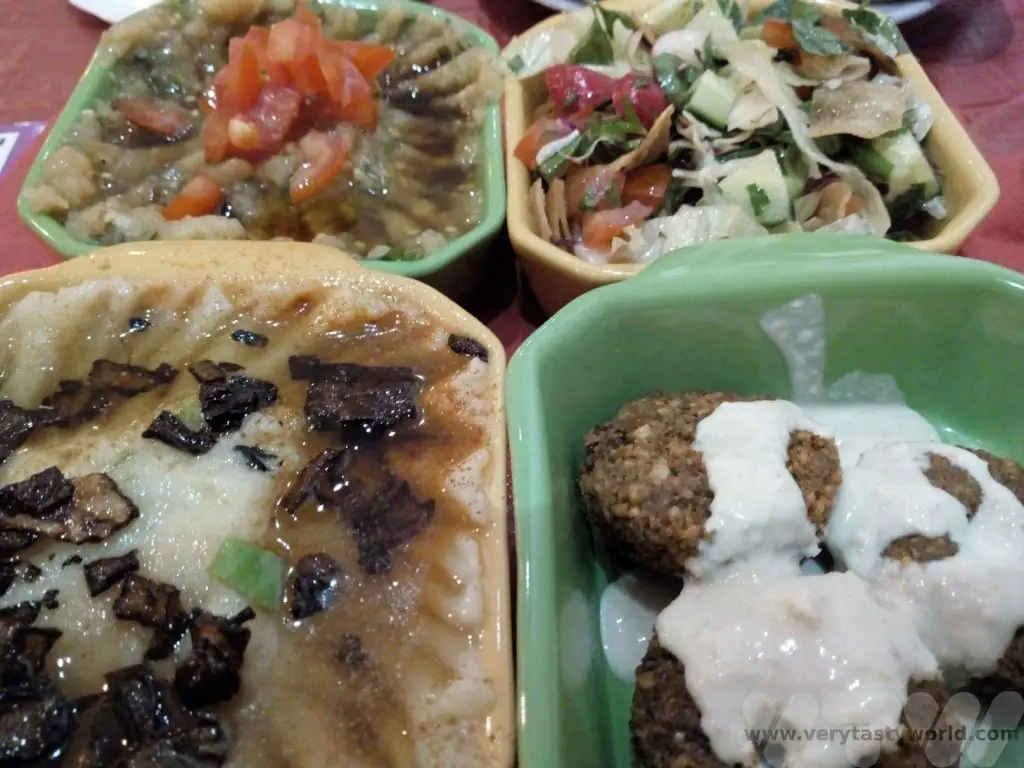
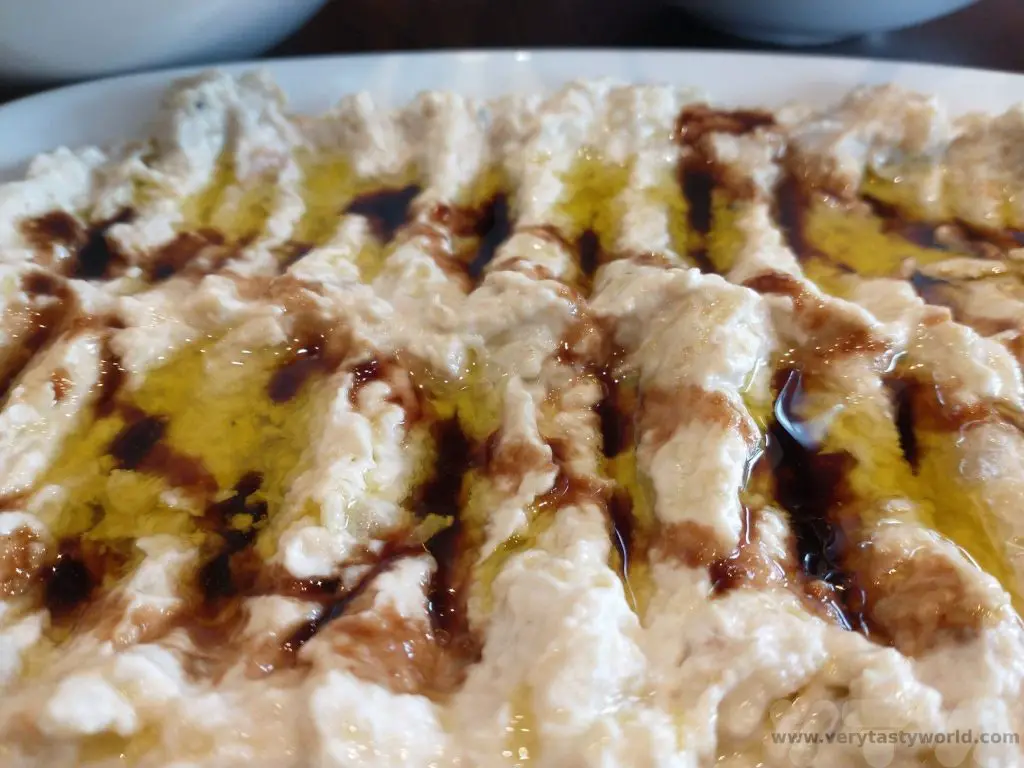
Grilled meats are popular for main courses – they are delicately spiced and very juicy. Lamb and chicken are likely to be the meats on offer.
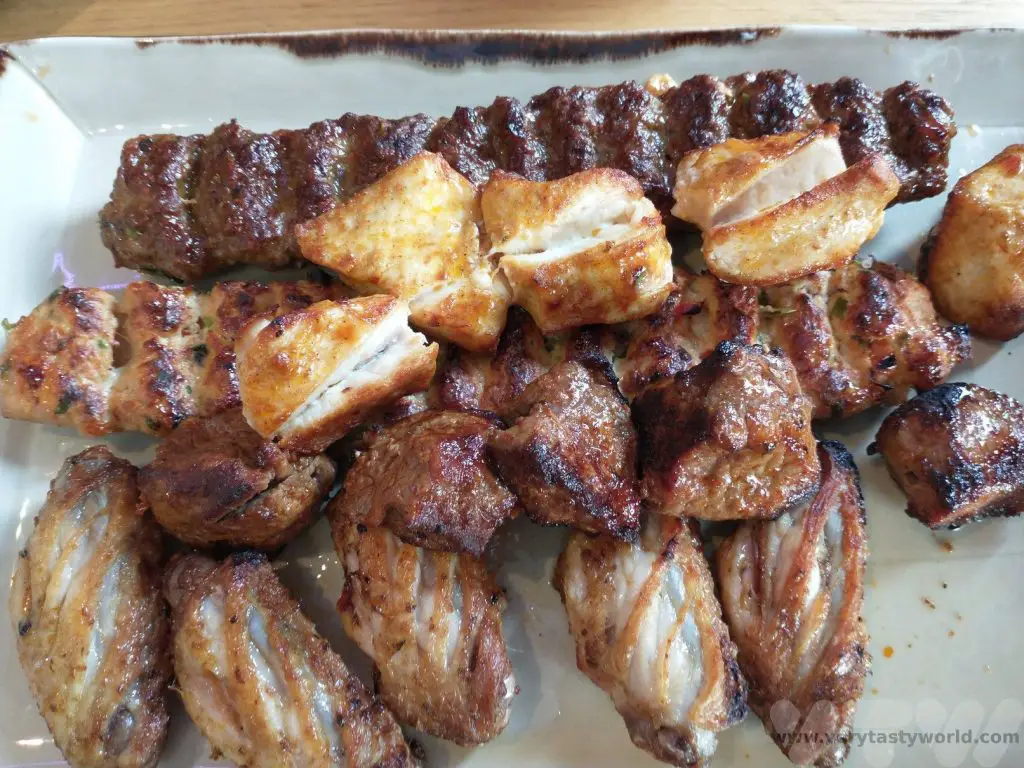
And you can’t go to Lebanon and not try the street food. Shawarma is a flat bread filled with grilled meats and chips!
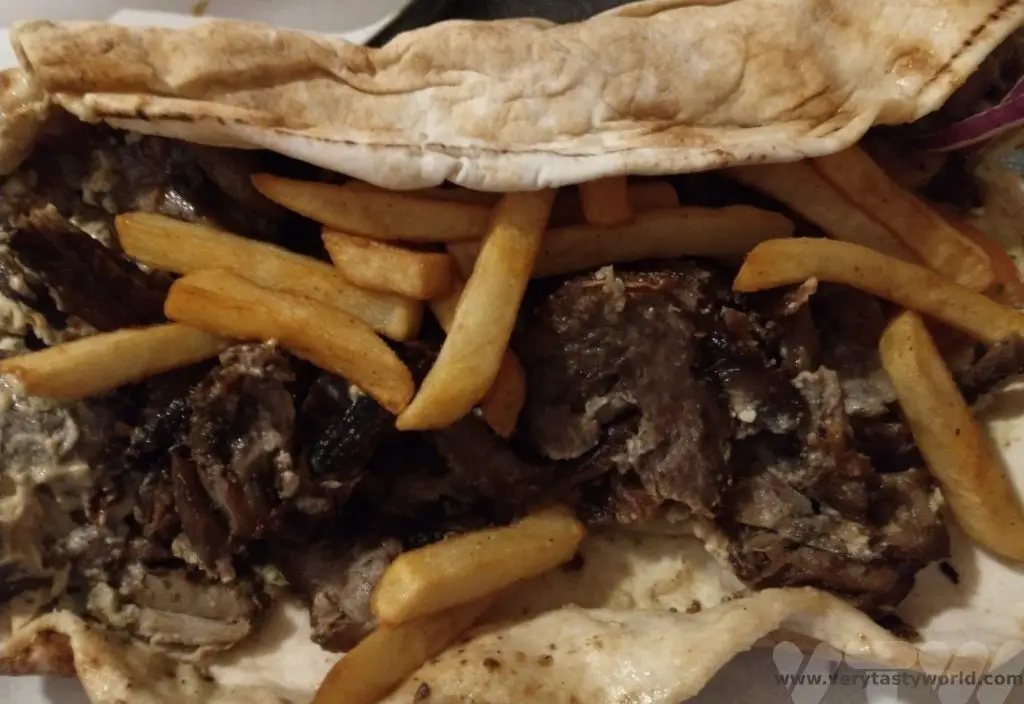
Alcohol is freely available in Lebanon. The spirit of choice is Arak – a distilled aniseed flavoured drink. It’s a bit of a love-hate thing, Colin loves the flavour and could easily drink it all day, Mitch really can’t bear aniseed and shivers at the thought of it.
It’s a little known fact that Lebanese wine is absolutely awesome. Lebanon is one of the oldest wine-producing countries in the world (along with Georgia and the Caucasus region in general). Vineyards are mainly located in the southern part of the Beqaa Valley and they produce delicious and very quaffable fruity reds. Chateau Musar is one of the most famous wine producers.
Chateau Ksara is Lebanon’s oldest and largest winery and it is possible to visit the vineyards and winery. Dating from 1857, Jesuit monks planted French vines and stored their wine in local caves. Their wine is absolutely delicious. They do export it so try to get hold of a bottle or three if you can.
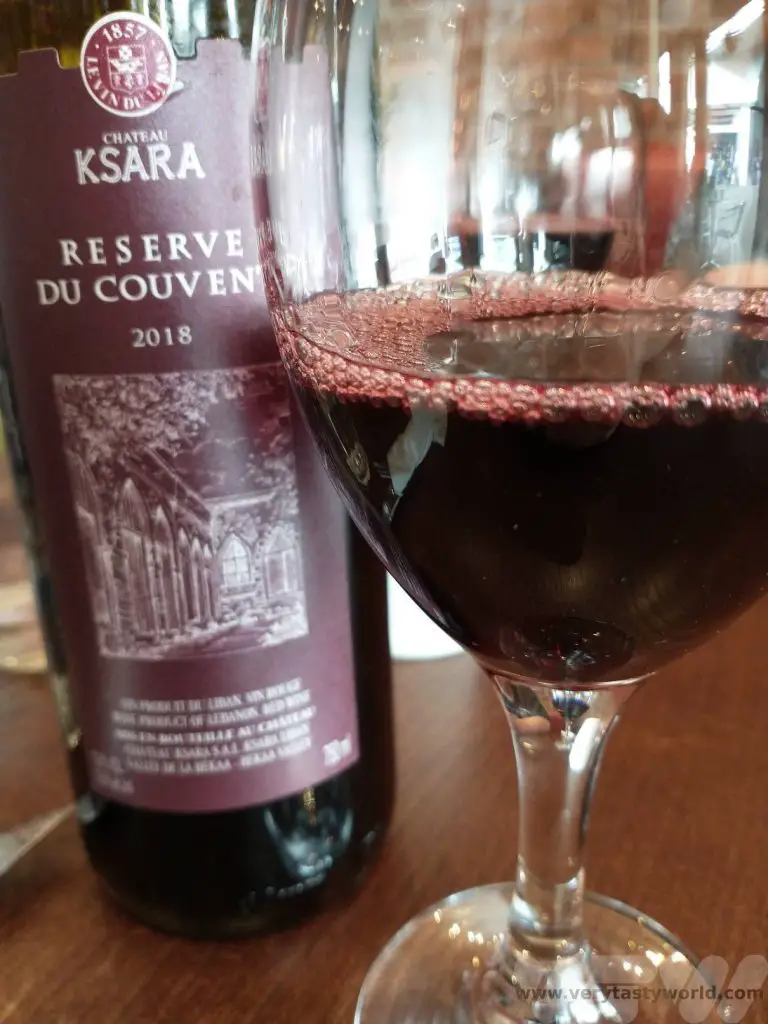
Related Posts You May Enjoy
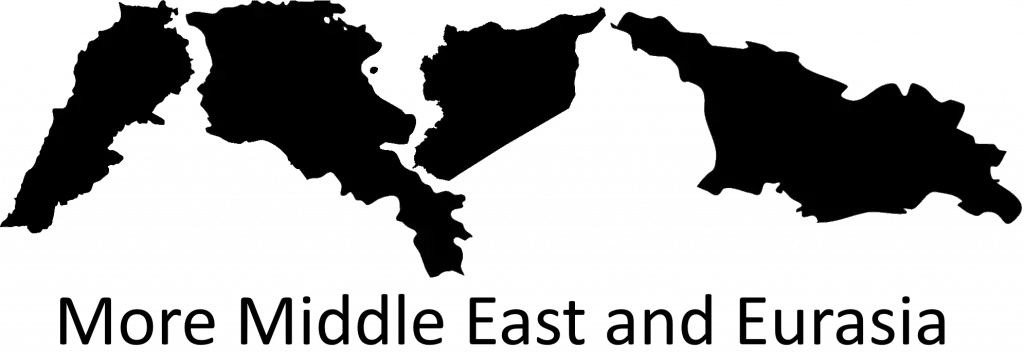
- Where To Go In Lebanon – A Visitor’s Guide
- Visit Petra in Jordan
- Toasting Tradition in Georgia
- Visiting The Dead Sea In Jordan
- The Roman Ruins in Jerash, Jordan
- Who Ate All the Pies (Including the Georgian Cheese Boat)?

- RECIPE Oyakodon Donburi
- Zero Waste Recipes Before Your Holiday
- RECIPE: Vegetable Biryani Tamil Nadu Style
- RECIPE: Vegan Wild Garlic Pesto
- Recipe: Venetian Pasta Sauce
- RECIPE: Biryani Raita Recipe
- RECIPE: How to Make Costa Rica’s Gallo Pinto
- Recipe: Japanese Simmered Pork Belly – Buta no Kakuni
- RECIPE: How to Make Umeboshi
Visit Petra in Jordan
The Rose Red City
There are many magnificent archaeological sites in the world and the Rose Red City of Petra is undoubtedly one of the greatest. It had long been an ambition to visit and it was top of our list when exploring Jordan. Here is a guide to a visit to Petra.
The most famous image of Petra that of Al-Khazneh, The Treasury (the one you see in the film Indiana Jones and the Last Crusade) and we knew that we would walk through a dramatic canyon, known as As-Siq, to reach it. What we didn’t realise was quite how extensive the site is.
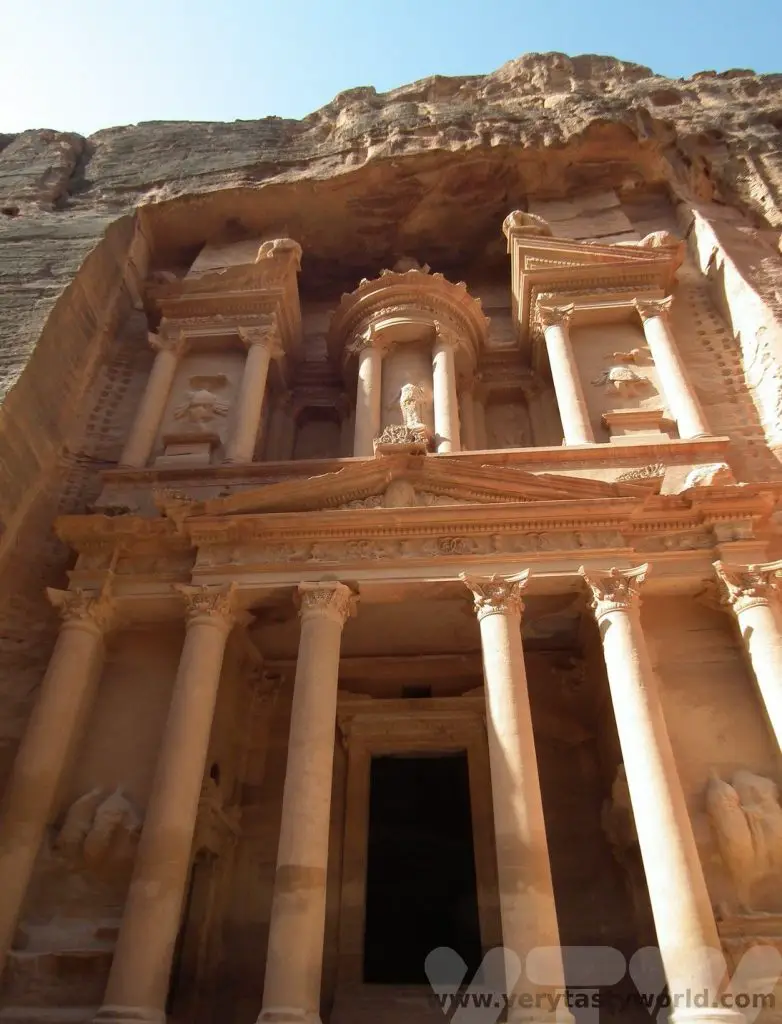
The History Of Petra
Petra was built by the Nabateans, an ancient Arab tribe, around the 1st Century BCE. The Nabateans were involved with caravaneering, trading in goods from all over the Middle East and Far East, and they became very wealthy protecting the region’s trade routes. Goods came from as far as China and India. What was fascinating about the Nabateans was that they were a clever, enlightened people. They believed in cultural inclusivity and appropriated technology from all over the world, absorbing influences from the places they traded with. You can see many different architectural styles throughout Petra.
In 106 CE the city was overtaken by the Romans who renamed it Arabia Petraea. The city did thrive under Roman rule for many years but its importance as a trade route declined as sea trading routes developed and became more important for transporting goods. It was significantly damaged by an earthquake in the 4th Century CE. It declined further during the Byzantine era and the city eventually was abandoned became ‘lost’ for centuries. It was re-discovered by explorer Johann Ludwig Burckhardt in 1812.
Visit Petra In Jordan – Practicalities
The site is located around 240km from Jordan’s capital city, Amman. The time it takes to reach the area does vary depending on the traffic, especially in Amman, which can be quite congested, but also the route you take. It’s around three hours by car on the modern desert highway or five hours on the King’s Highway. It is possible to do a day trip to Petra from Amman by bus, leaving early in the morning and returning in the evening, but the visit would be very rushed. It is also possible to reach the site using a hire car (the driving would be easy except in Amman where the roads are quite chaotic) or via a private tour – there are many options available.
We had travelled to Petra via Mount Nebo and the Dead Sea having spent some time in Amman, and after visiting the Roman city of Jerash.
You can’t stay in Petra itself (edit – that is, there are no hotels in Petra), but there is a town called Wadi Musa nearby. Our hotel was about a ten minute walk from the site entrance at Wadi Musa, which was a further kilometre away from the start of the Siq. Included in the ticket price is a horse ride to the Siq, which we declined. We don’t feel comfortable using animals when we are travelling as we can never be sure how they are treated, so avoided these. We prefer to walk anyway. Since we visited, an initiative has been established to use electric vehicles that will replace the horse-drawn carriages.
We had two full days to explore. We needed them. You cannot enter the site without purchasing a ticket at the visitor’s centre at Wadi Musa and we recommend finding a guide for at least part of your visit. We found the most delightful guide at the visitor’s centre who was with us the first morning; he showed us Petra’s main features and explained a lot of the history. We spent the rest of the time there exploring the site for ourselves. (This link will take you to current entrance fees and costs for guides.)
The Siq
Just before the entrance to the Siq you can see the Obelisk Tomb and the Bab as-Siq Triclinium.
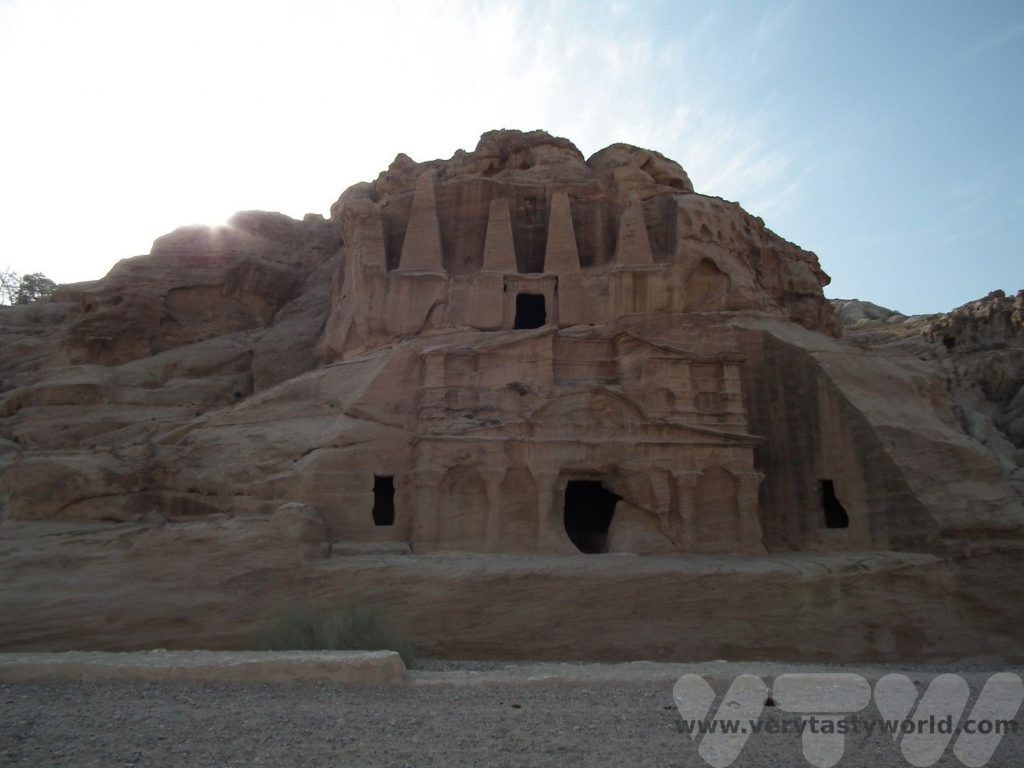
Then you enter the gorge itself. The Siq is about 1200 m long. It is deep (up to 80m in places), at times narrow, and stunningly beautiful. You can see all sorts of natural features, rock formations and fossils, as well as the remains of carvings showing caravans and camels.
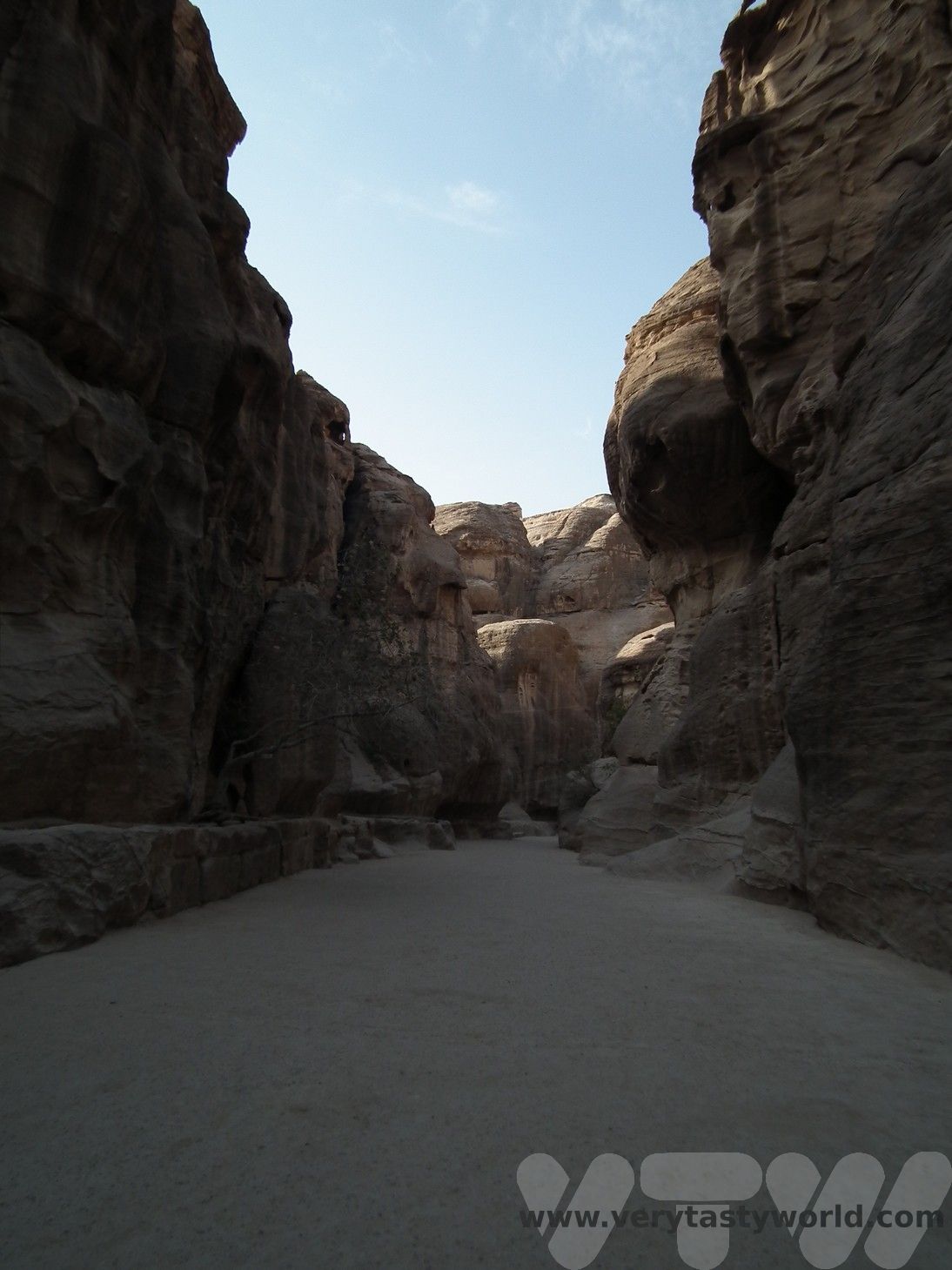
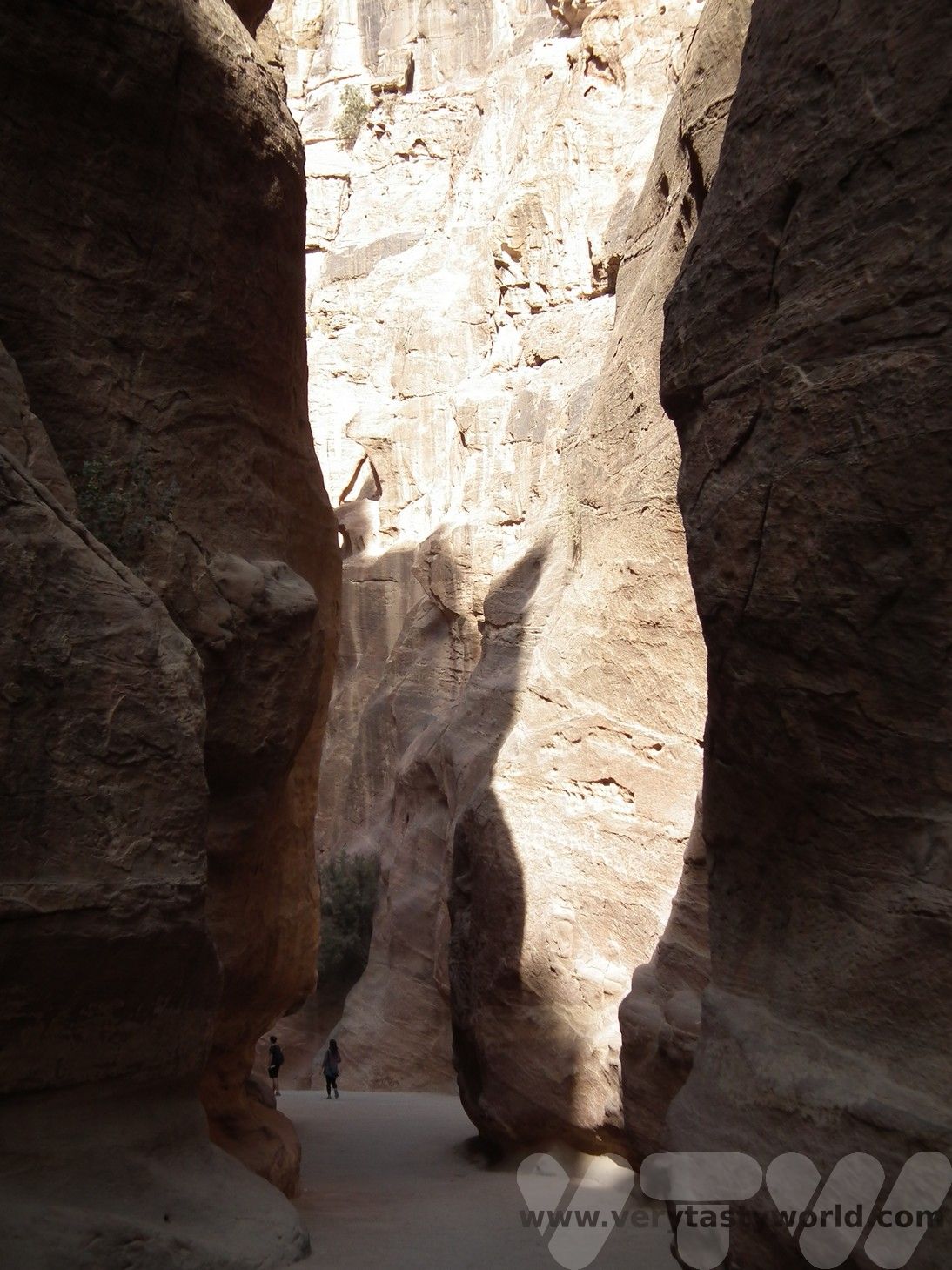
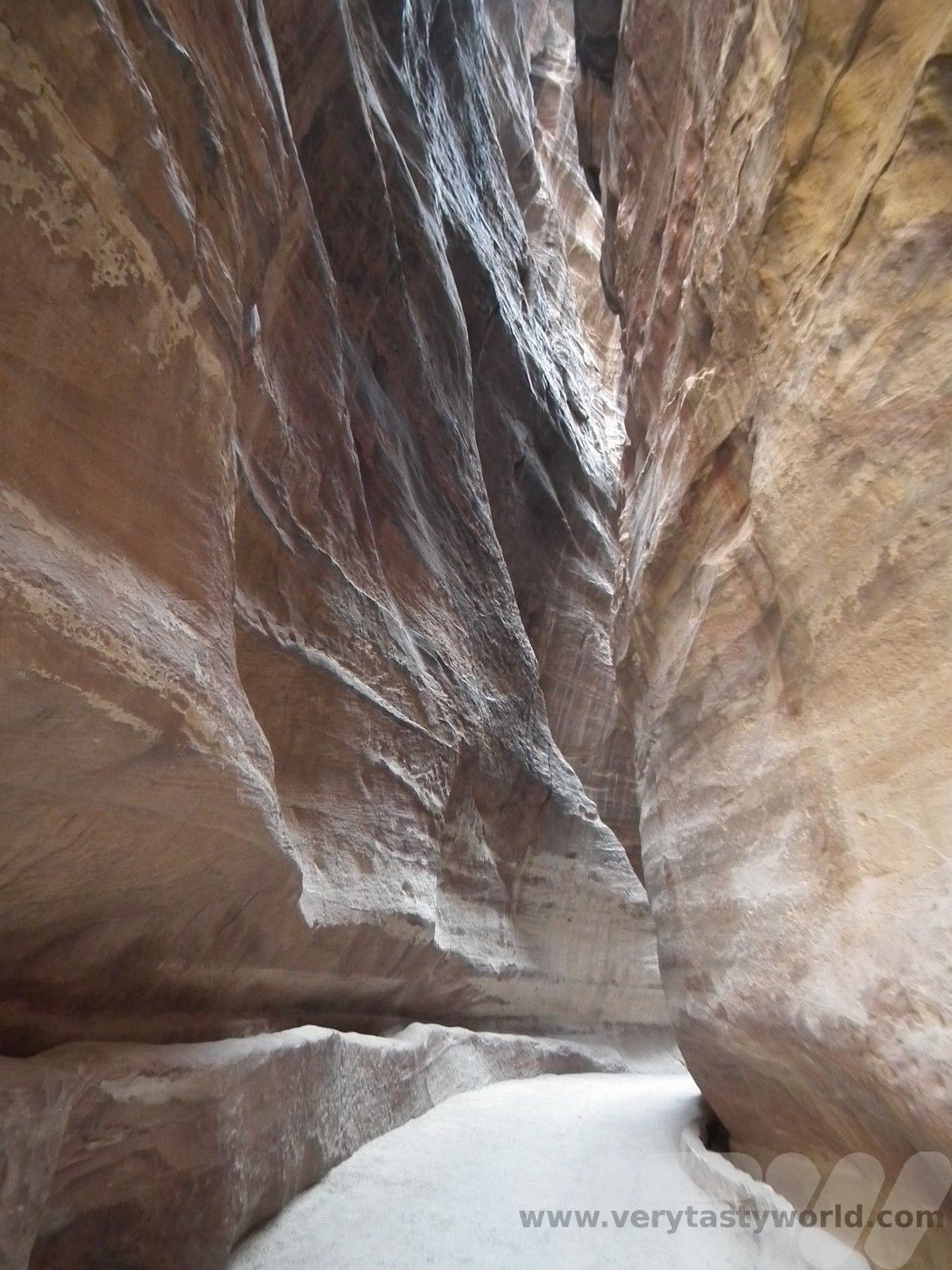
The photo shows drainage channels carved into the rock, inspired by Chinese bamboo irrigation channels, which carried water to Petra.
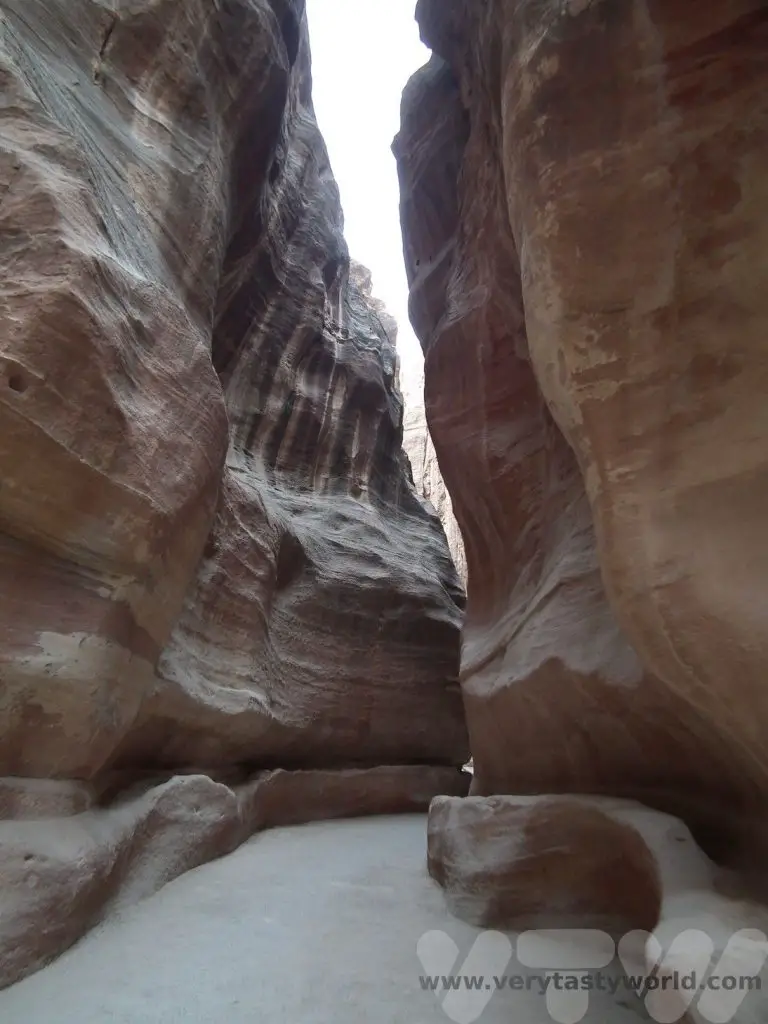
Then, at the end of the walk, you get a tantalising glimpse…
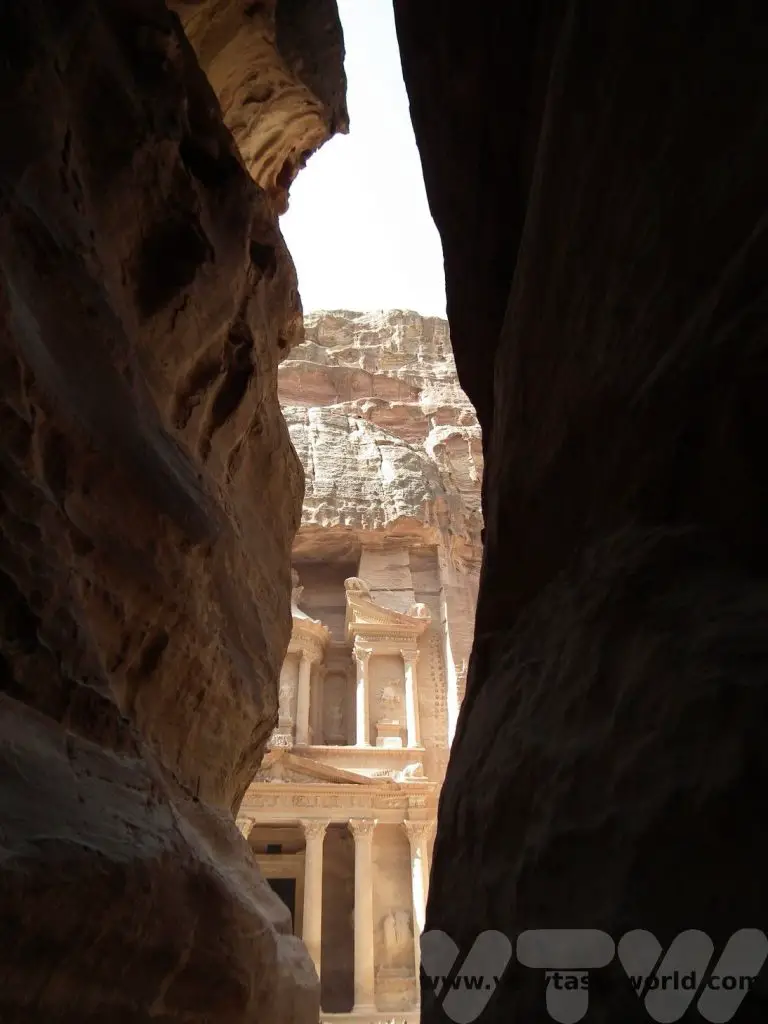
…of the Treasury, Al Khazneh. It’s actually a tomb of a 1st century Nabatean king. It’s about 30m wide and over 40m high. As with all the tombs at Petra, it was carved from the top down. (This process is similar to the amazing underground churches of Lalibela in Ethiopia.) You can see lots of indentations in the sandstone at the side of the structure. No-one is really sure about what they were for, but they could have been used by the craftsmen and masons for climbing to the top.
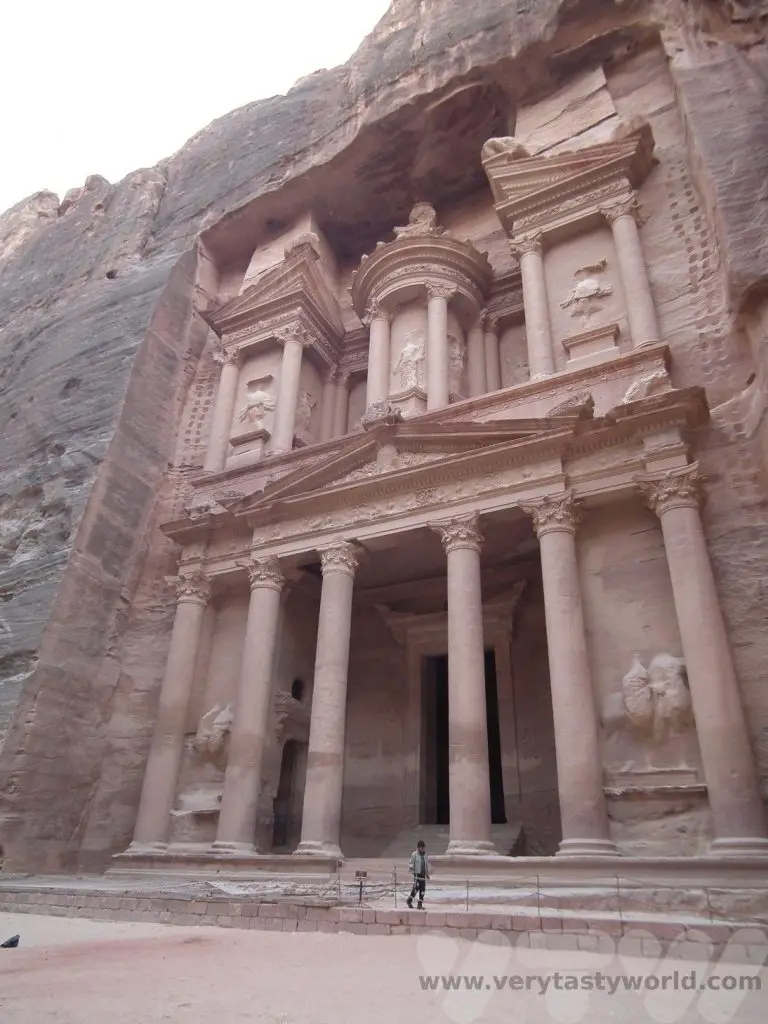
Exploring Petra
The Treasury is just the start of the site. It’s the only place you are not allowed to go inside. Everywhere else is open for exploration. There are no restrictions and no barriers so you need to take care.
From the Treasury you follow the Street of Facades, which has rows of tombs, all intricately carved from the rock.
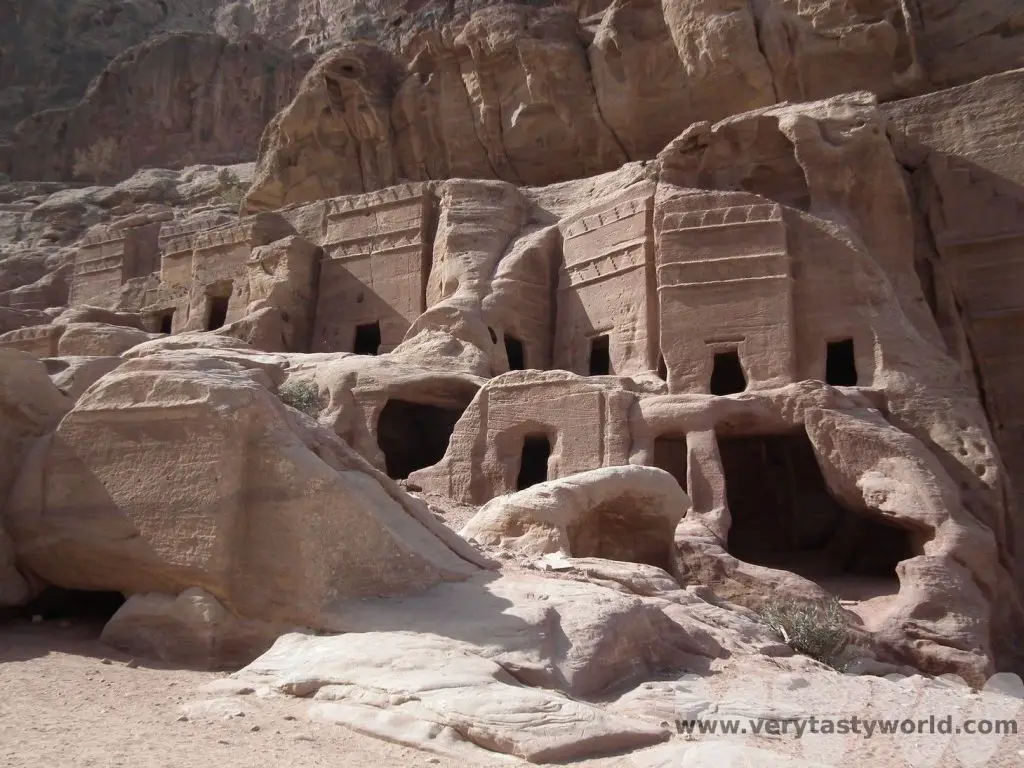
At the end of this street is the amphitheatre, carved into the rock, which appears to have a Roman influence. Its maximum capacity was around 7000 people.
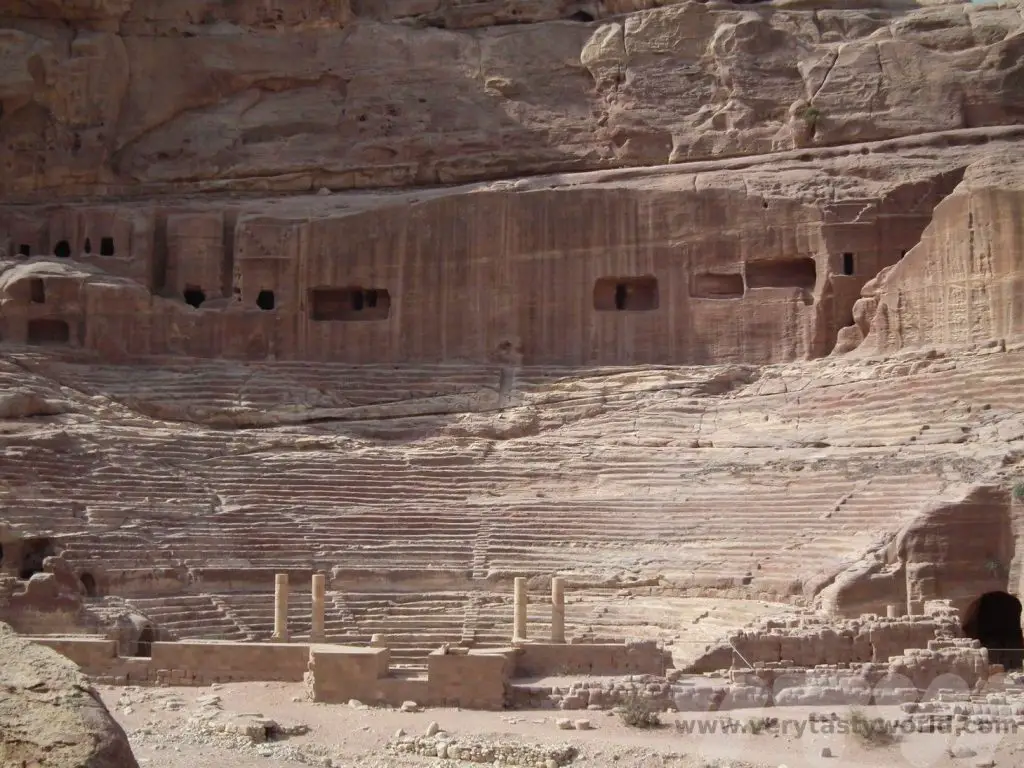
At the end of the street you can see further Nabotean tombs to the right…
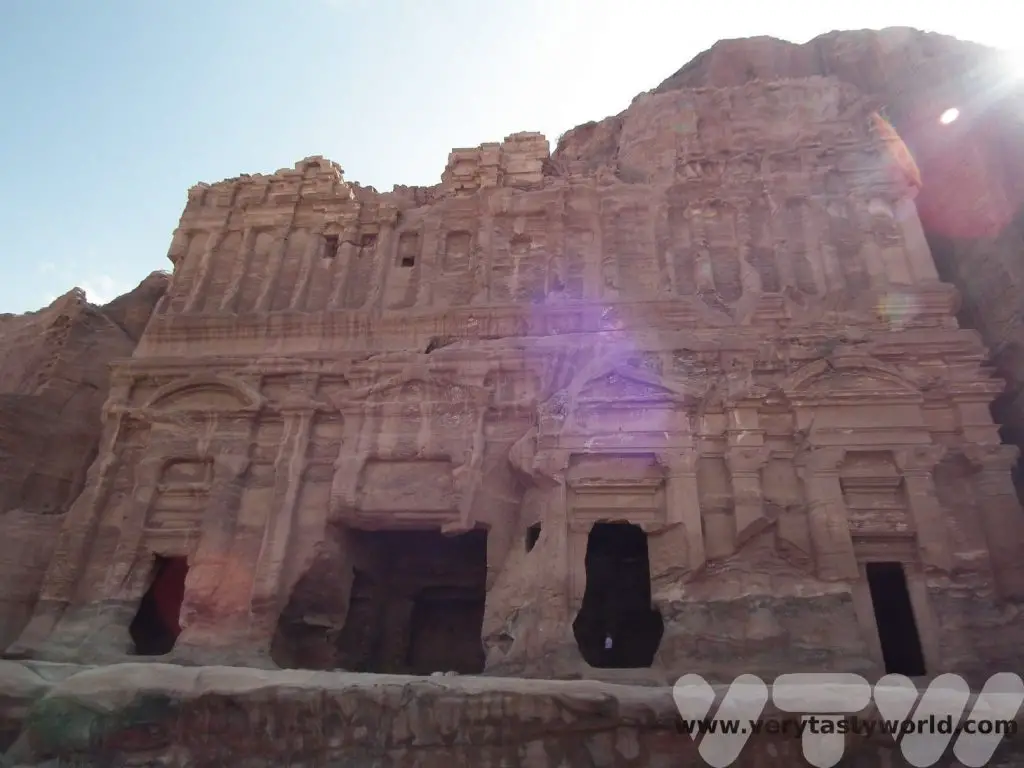
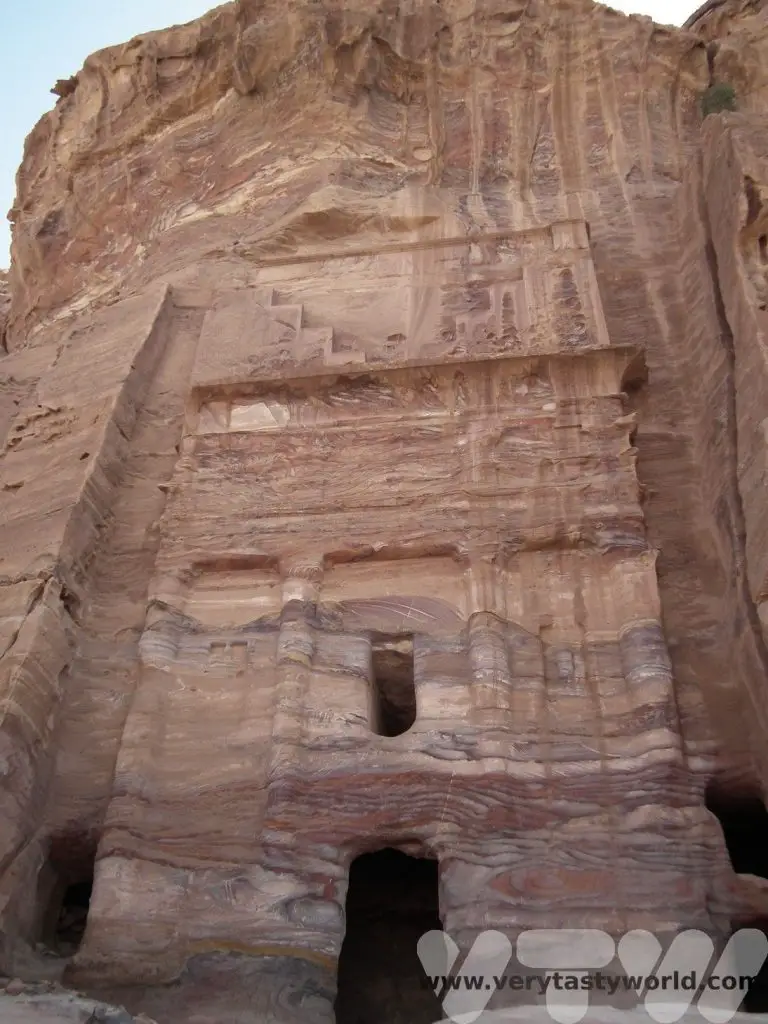
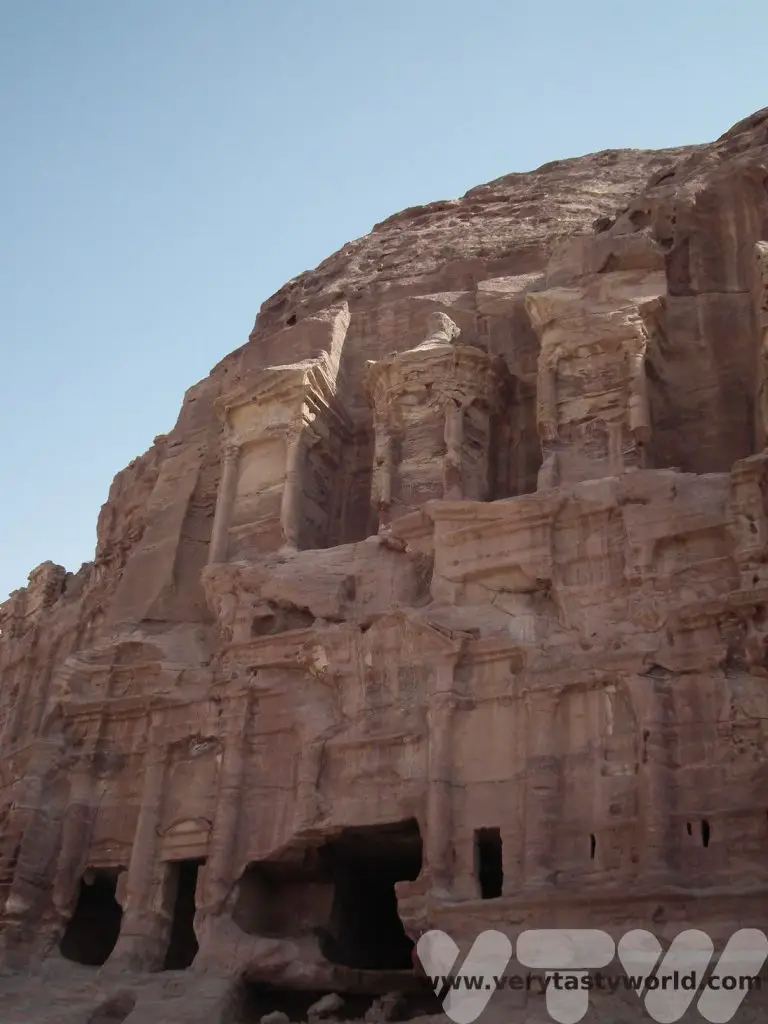
If you make a left turn you will walk along a colonnaded street, with marble pavement much of which is still preserved, which was effectively the city centre. It would have been lined with temples and public buildings.
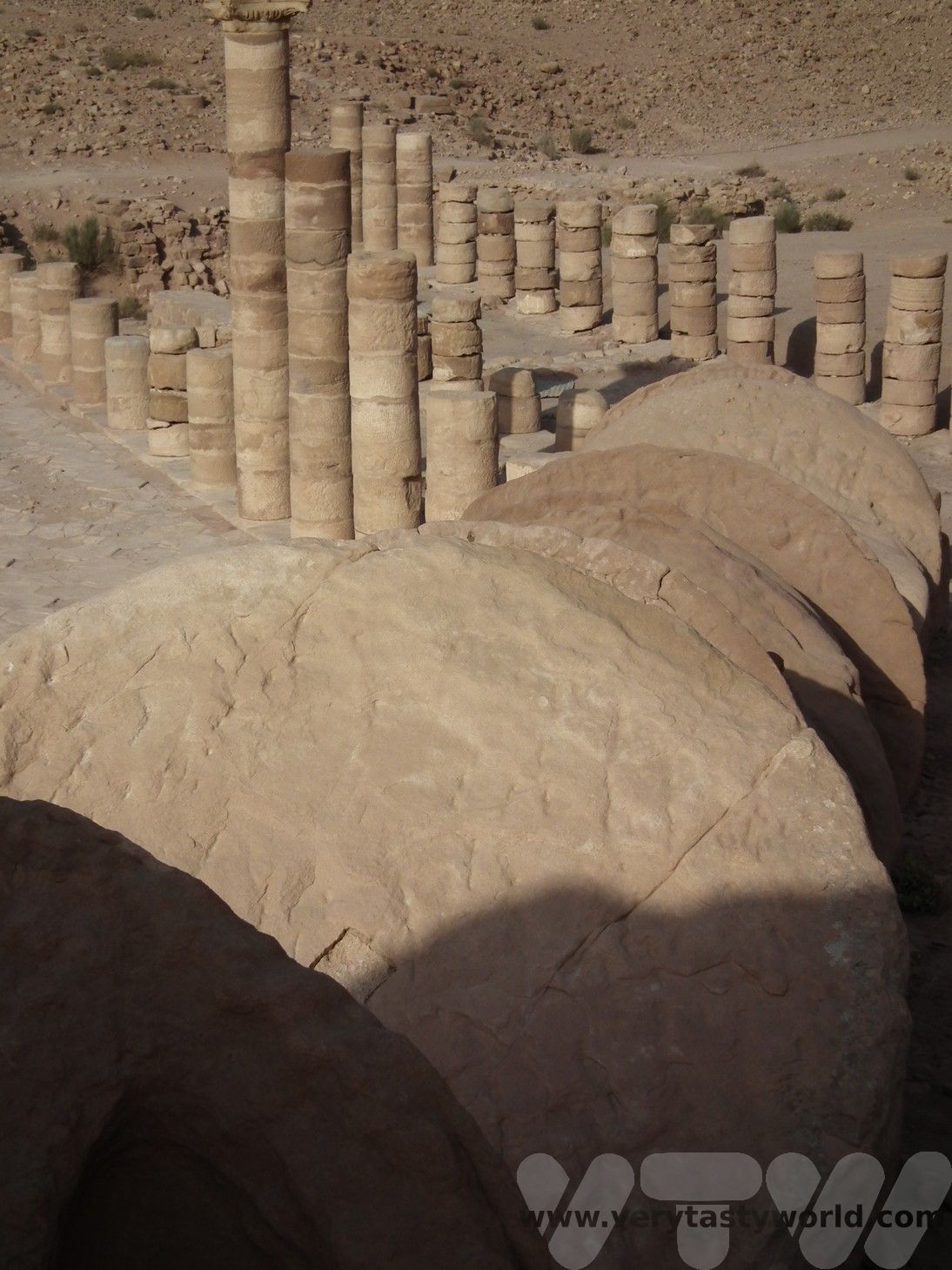
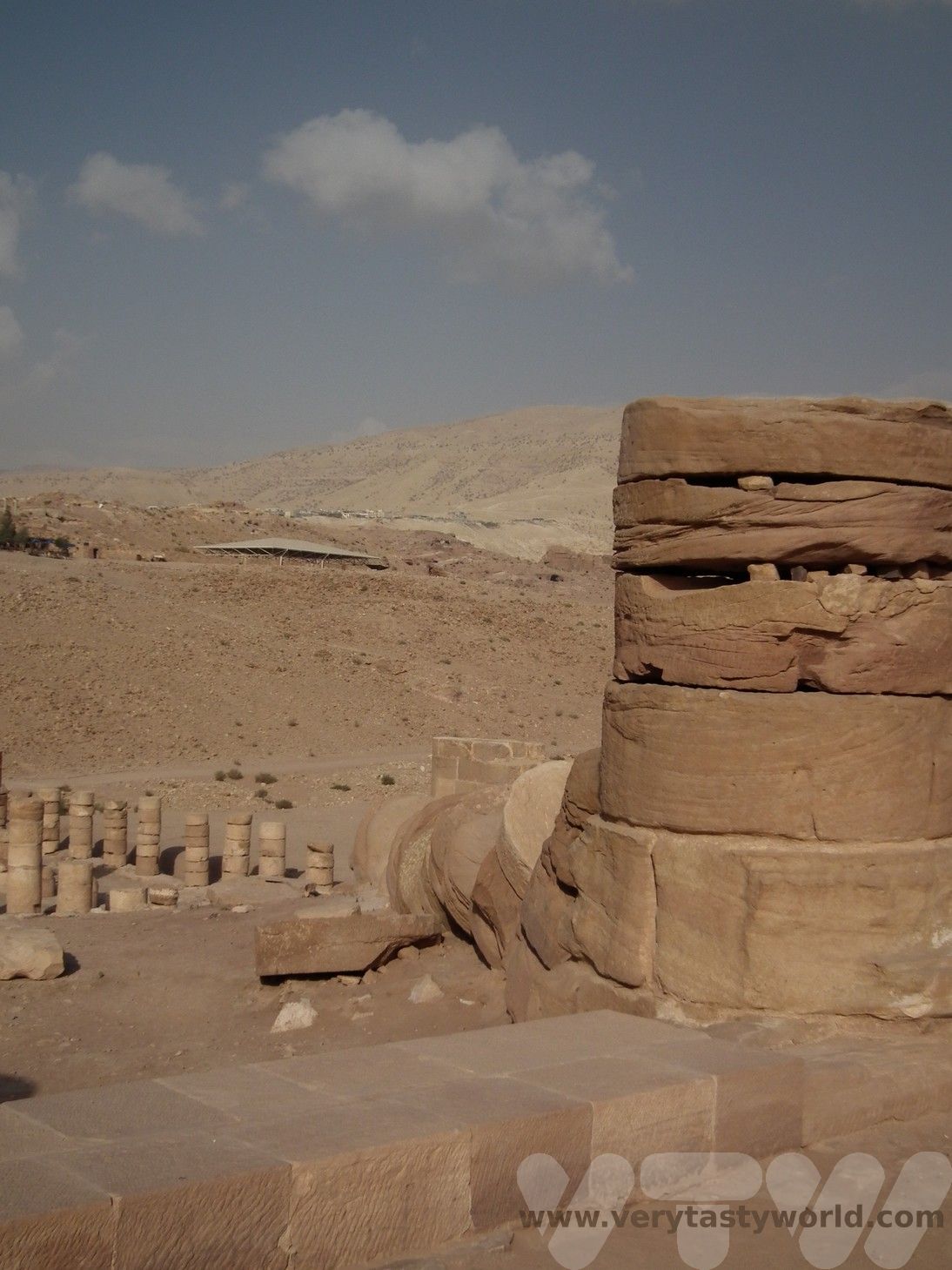
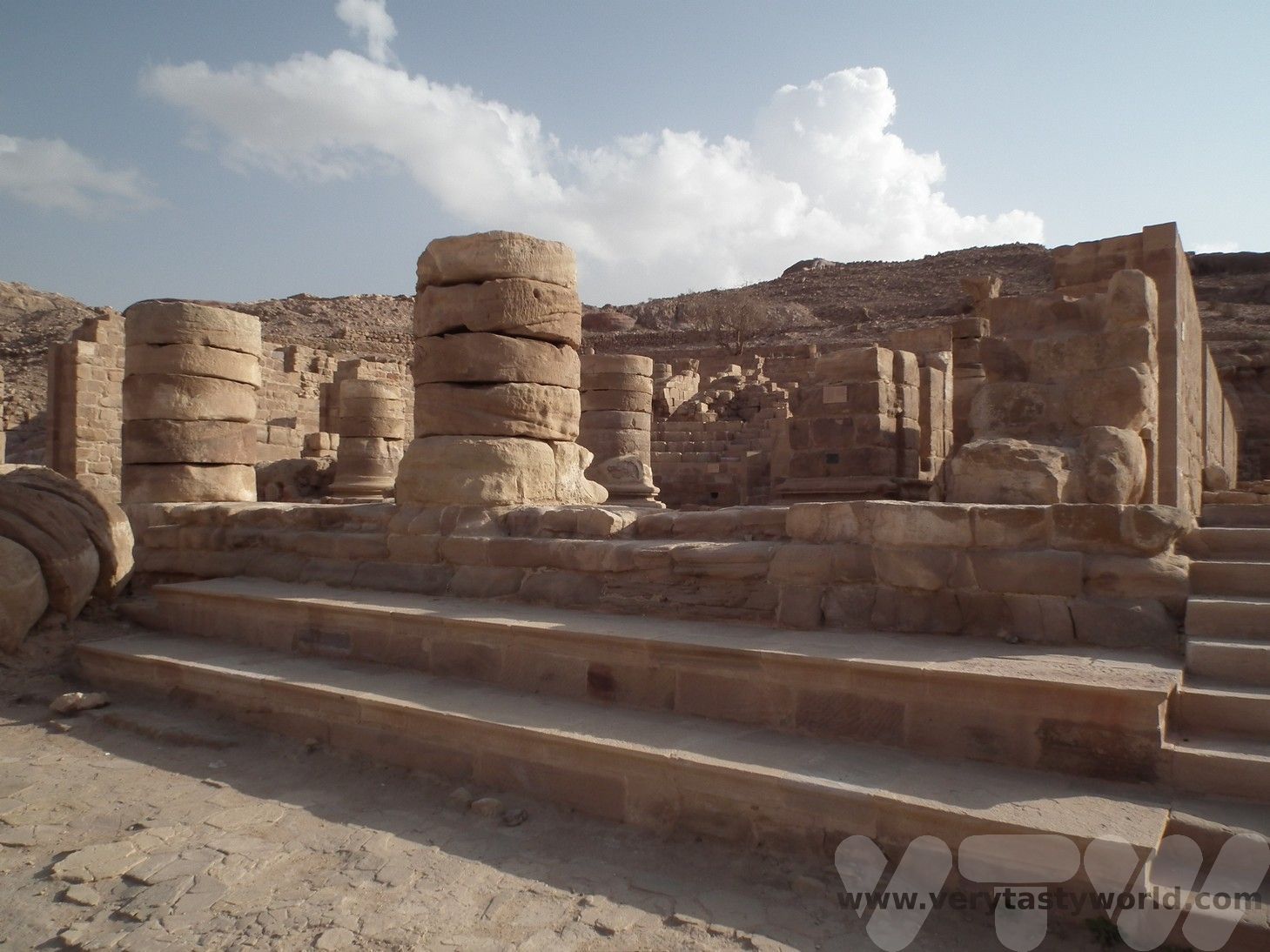
At the end of the street is the route to the Monastery.
The Monastery
We climbed 800 steps to Ad-Deir, The Monastery, which we found to be a moderate walk. It is classed as difficult on the trail guide because some of the steps have worn over the years. We needed to scramble a little on some sections.
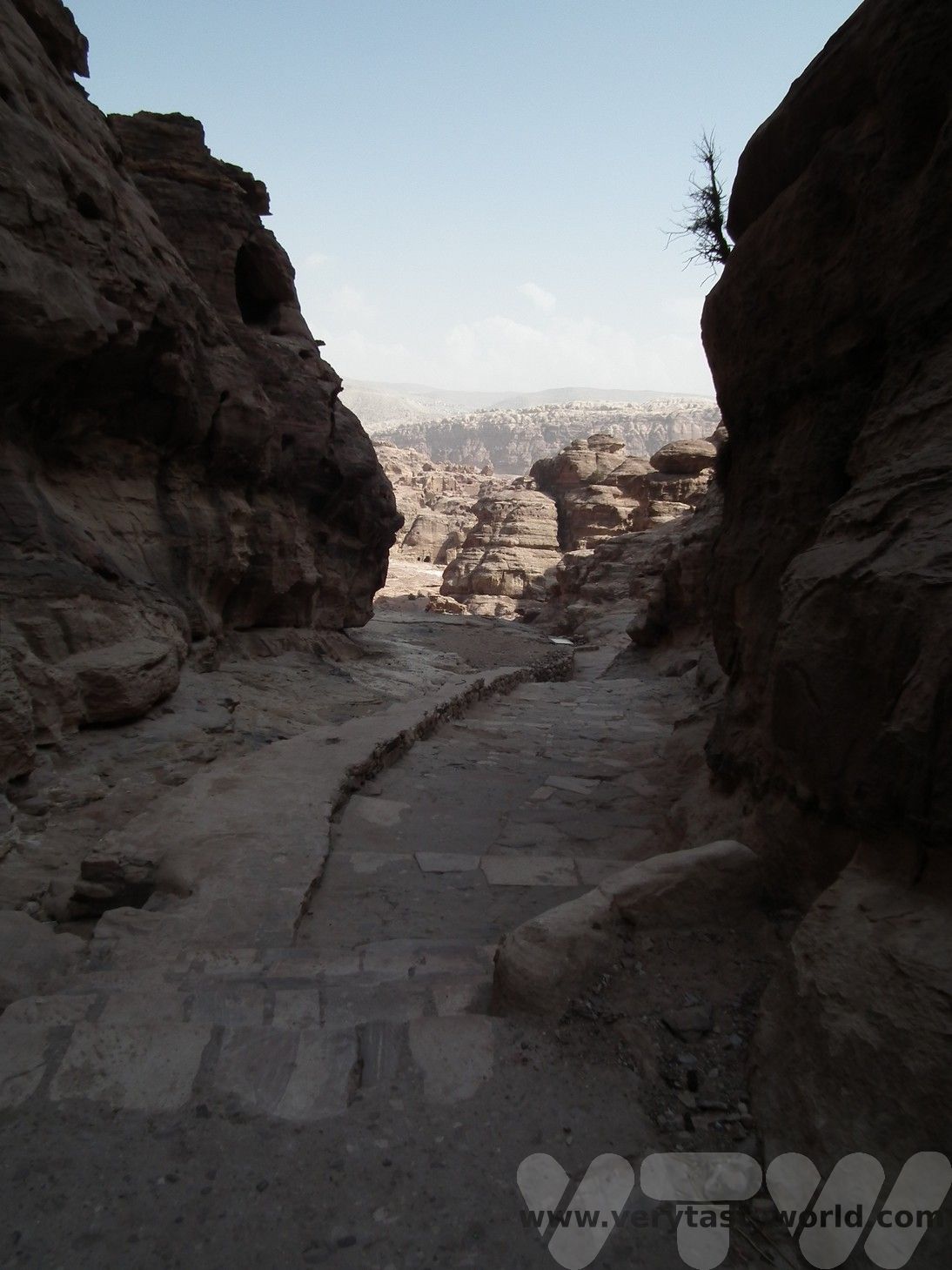
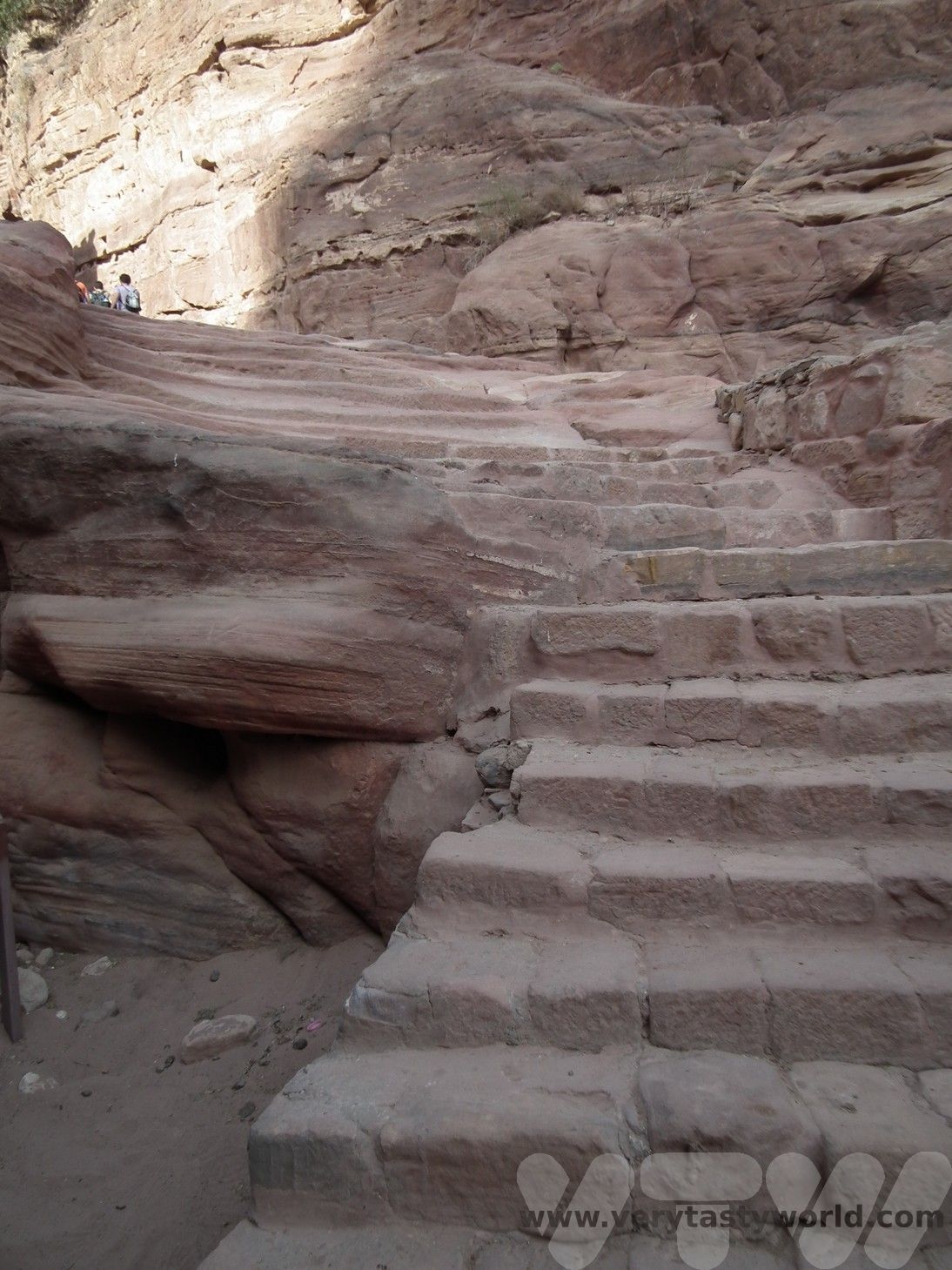
When we arrived we were delighted to discover that the Monastery was as spectacular at the Treasury.
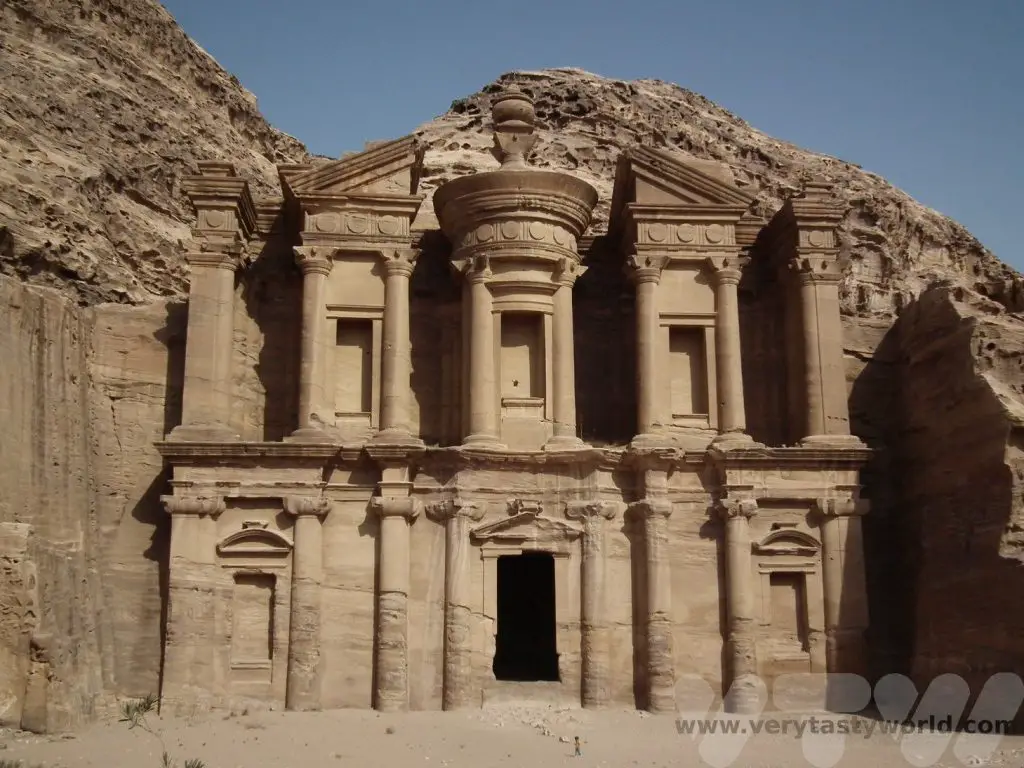
If you look closely at the photo below you can see a man sitting on the building, high up on the central colonnade. We had watched him climb all the way up the adjacent cliff face and then onto the building itself, leaping across the colonnades with absolute confidence – an amazing form of parkour. It was utterly terrifying watching him.
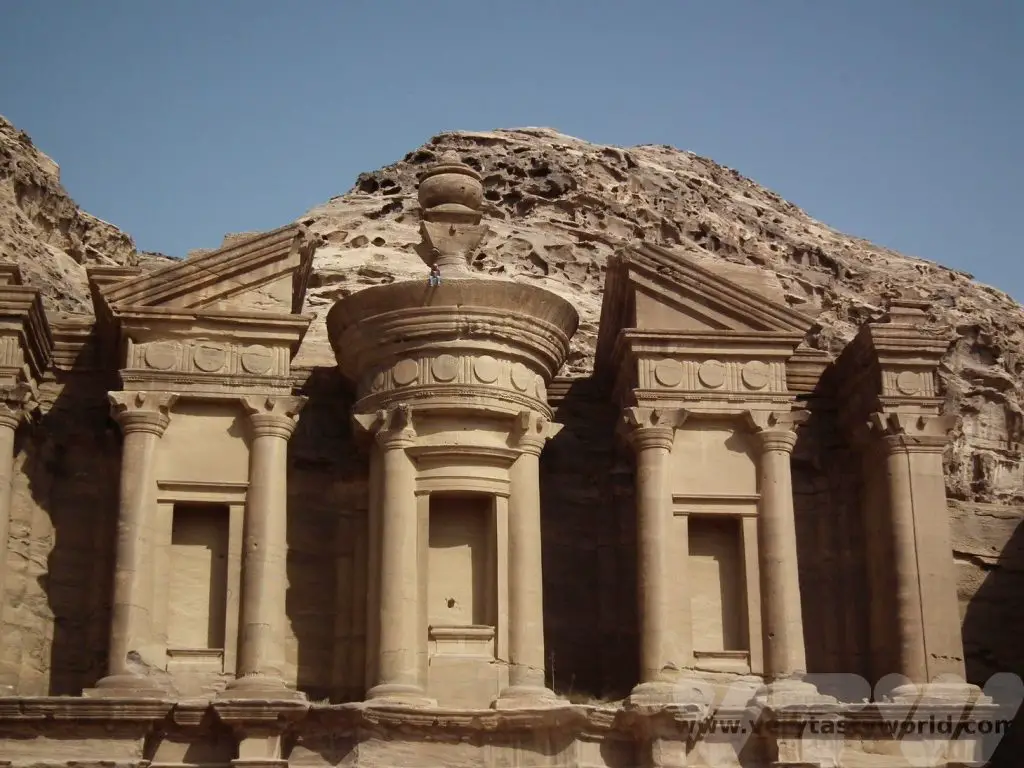
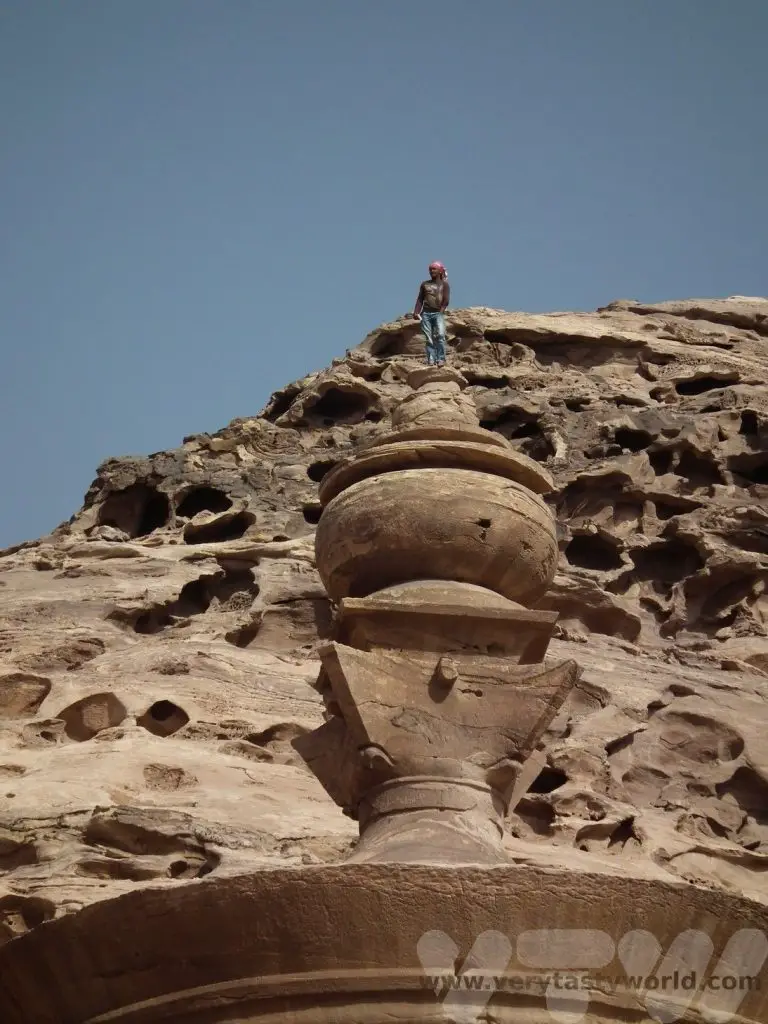
Exploring The Trails At Petra
There are numerous trails you can follow, some of which involve pretty tough climbs where the stairs have been eroded. The guide indicates the options available and the trails are well marked with brown signs.
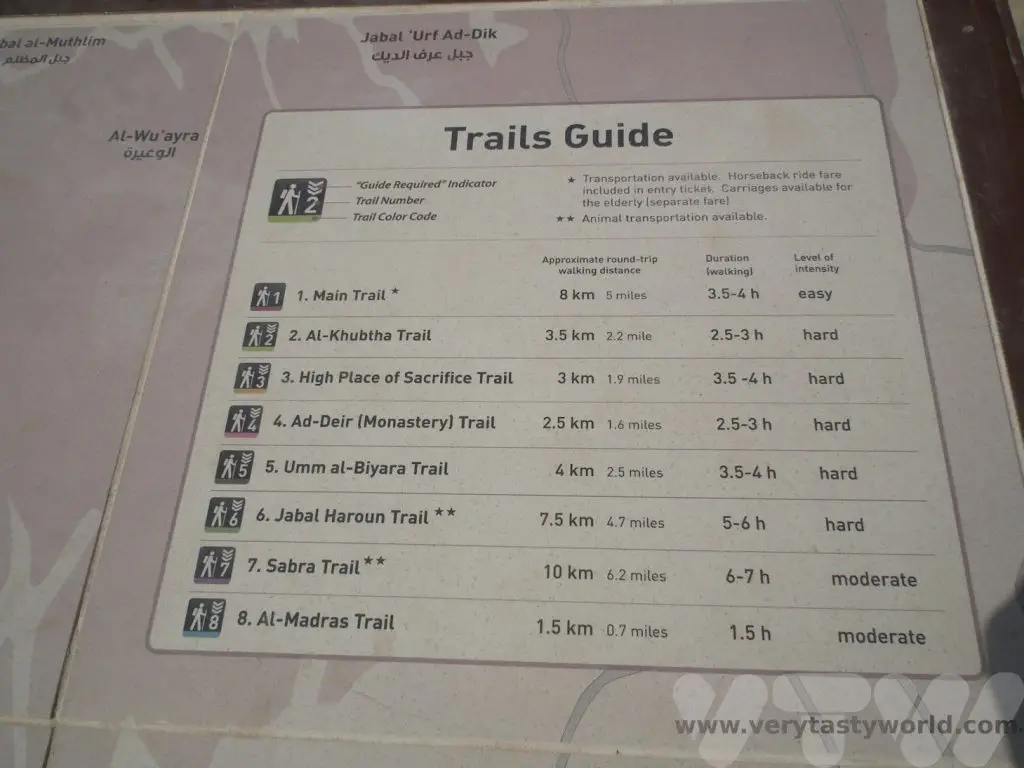
The other walk we did was the Al Khubtha trail, a climb to view The Treasury from above. We met a woman who was on her way down who said she had counted the number of steps, and sadly we can’t quite remember what her count was, but it was several hundred. The view was fantastic when we reached the summit.
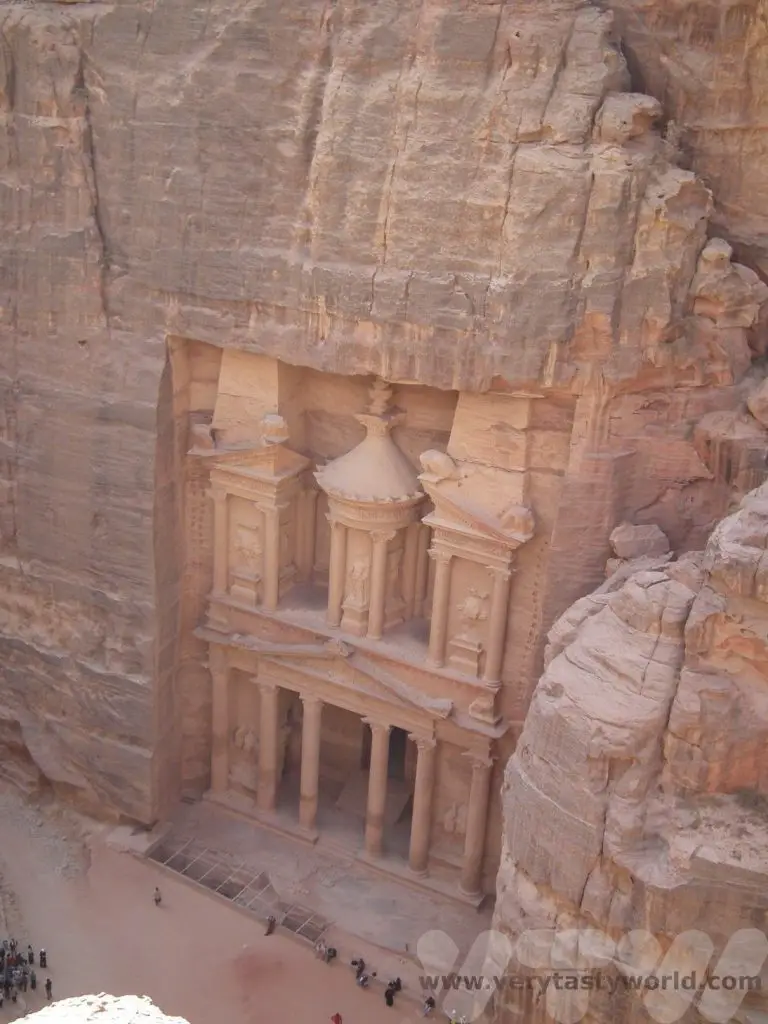
We also really loved the colours of the rock as we explored the various tombs. The white is silica, the red is iron oxide and the yellow, sandstone.
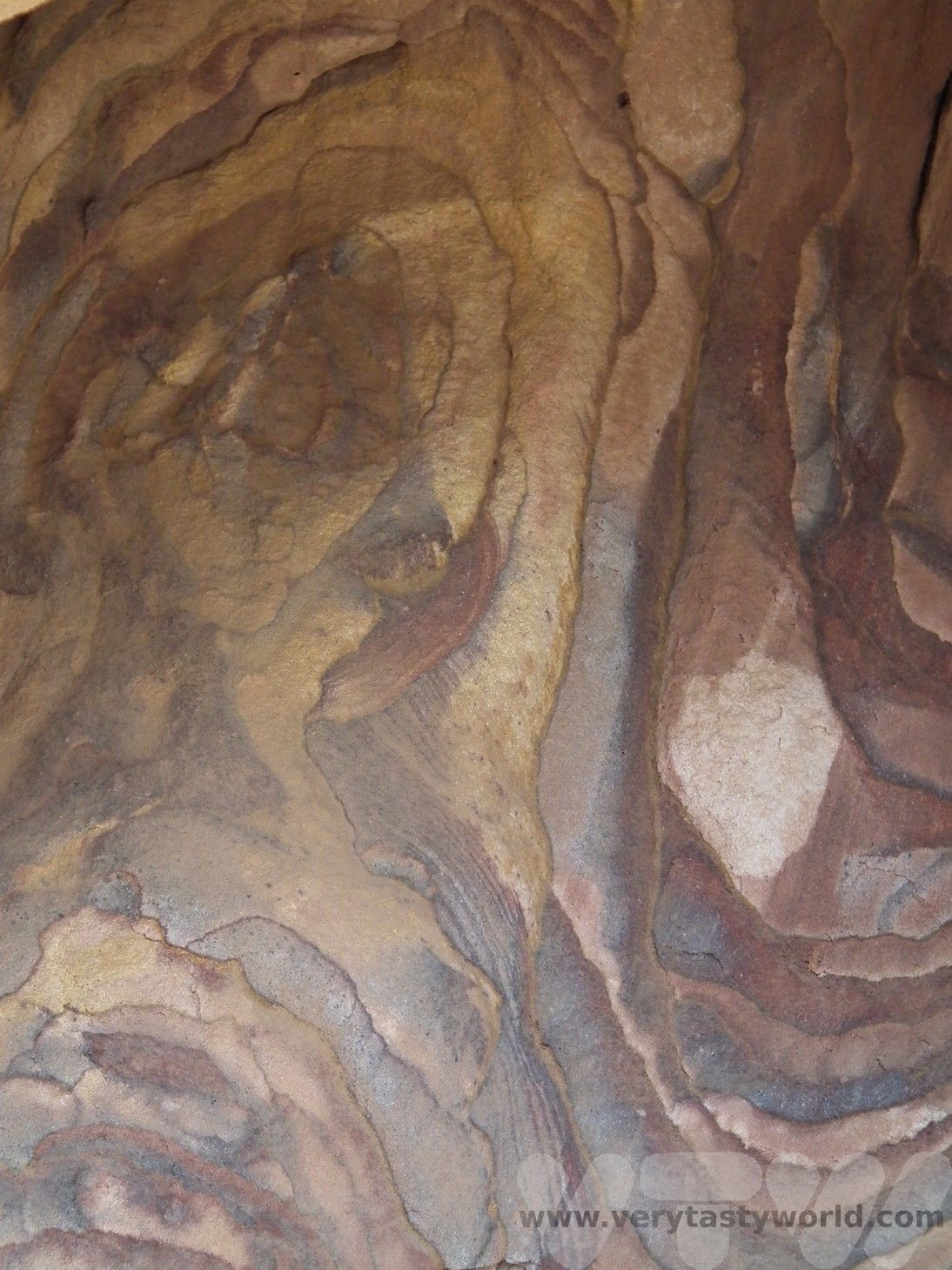
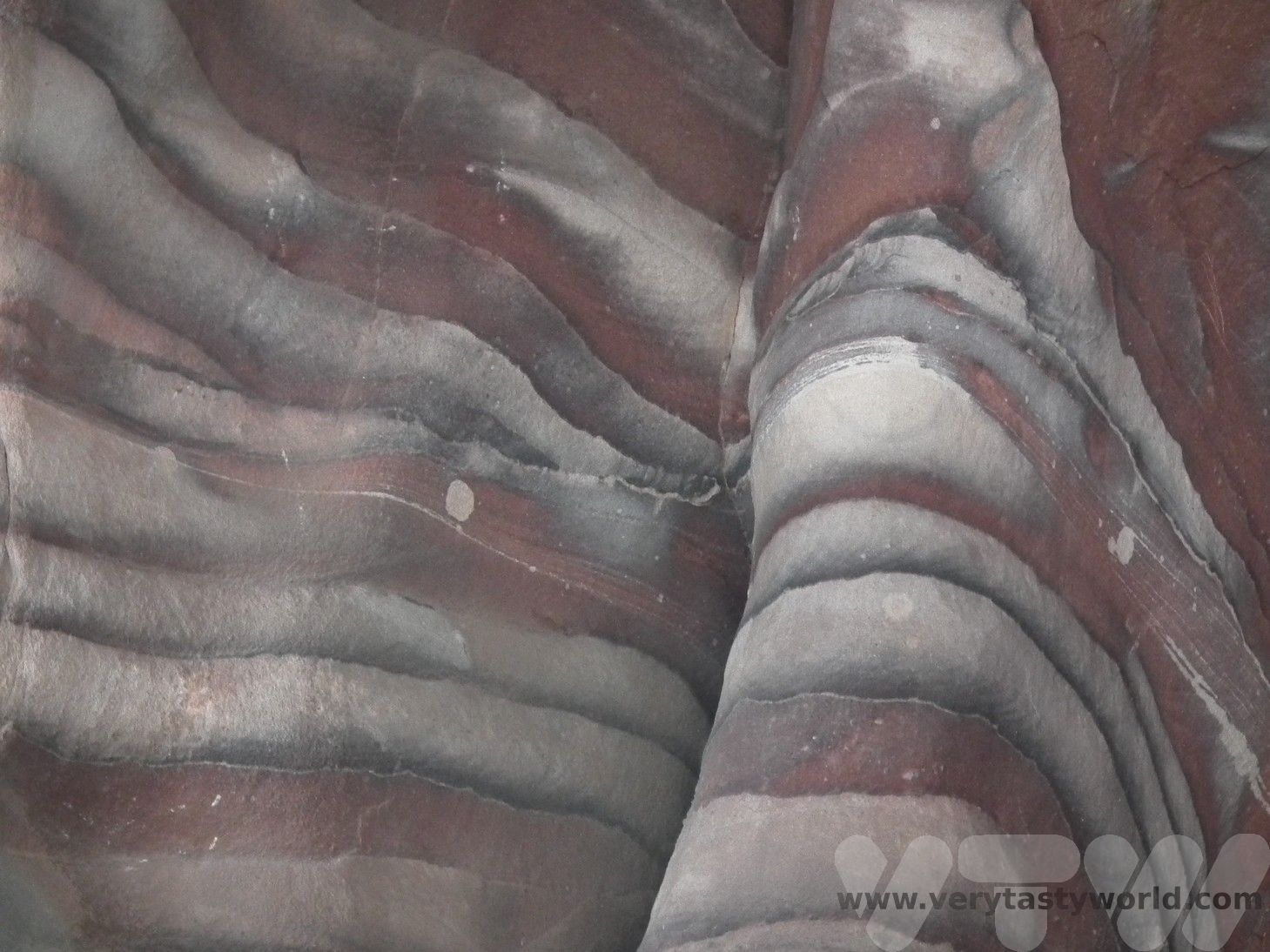
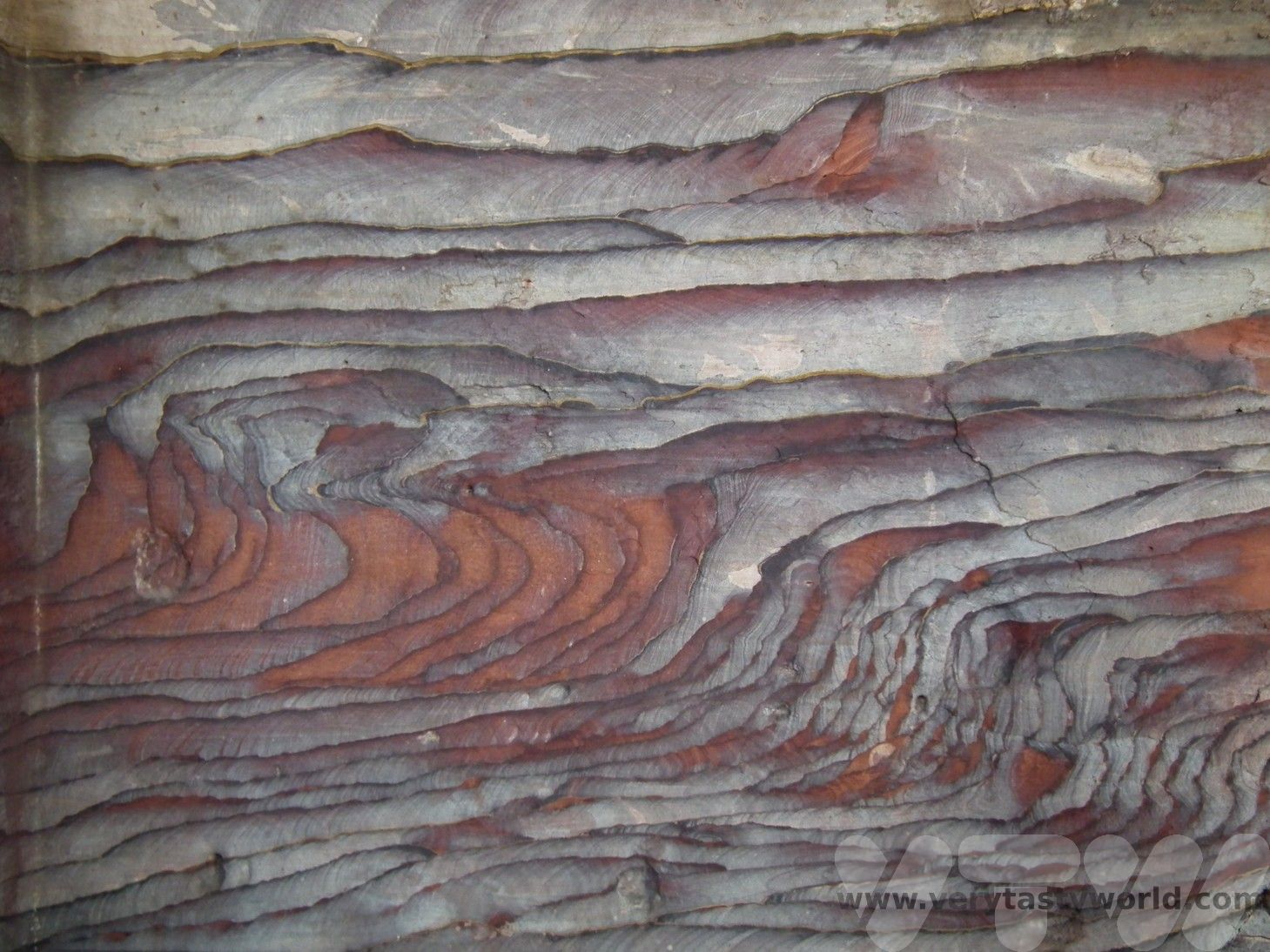
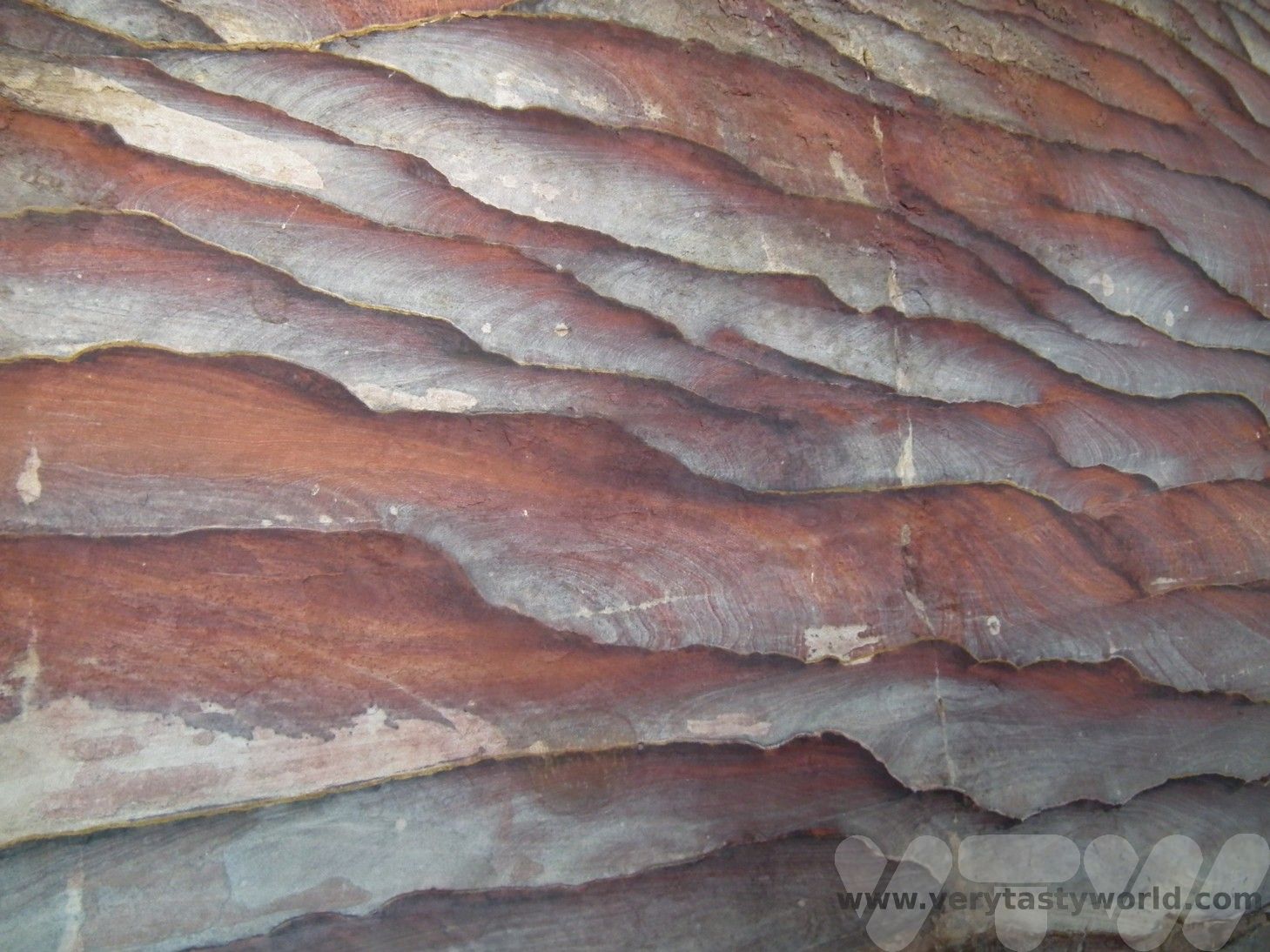
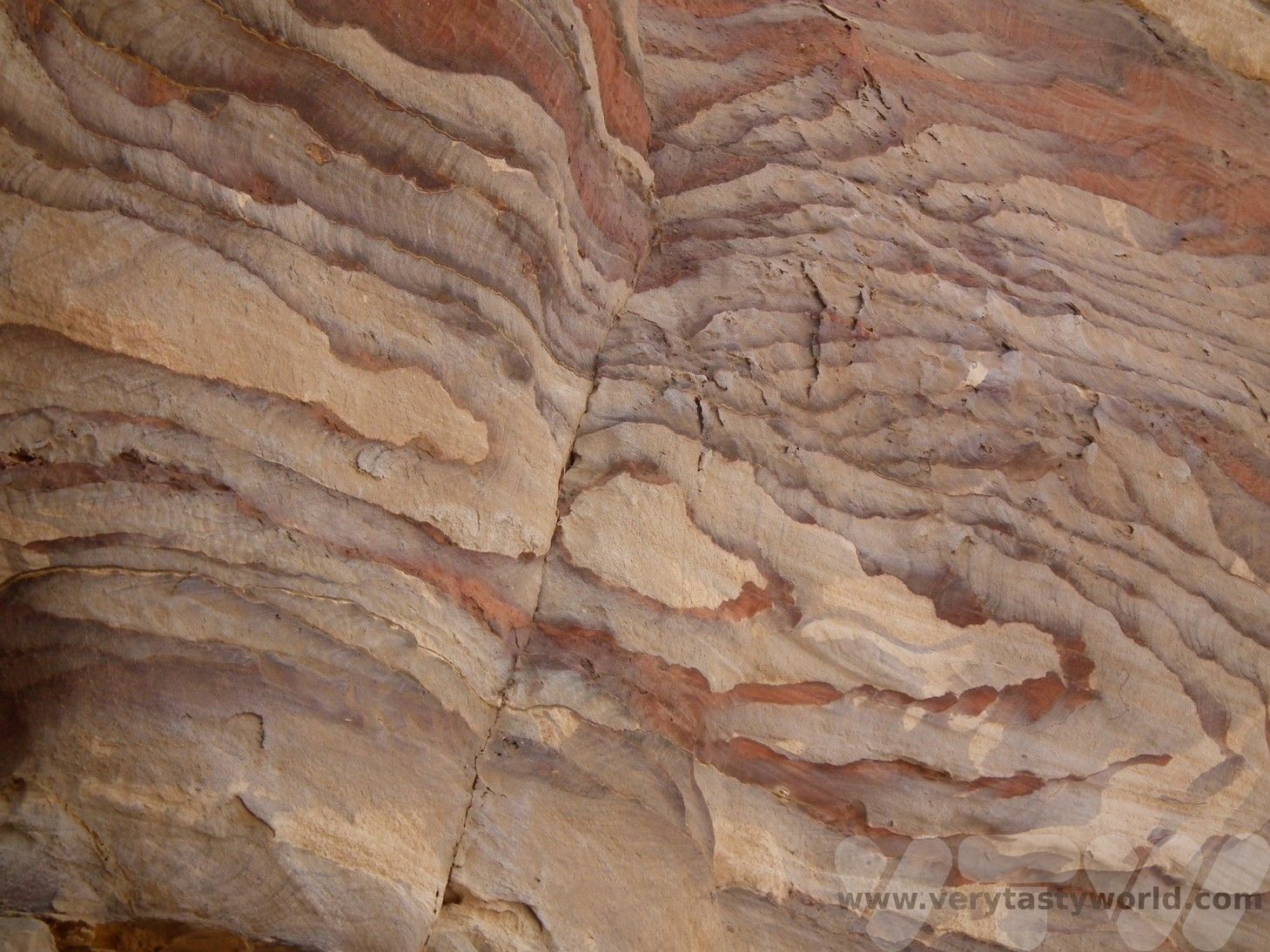
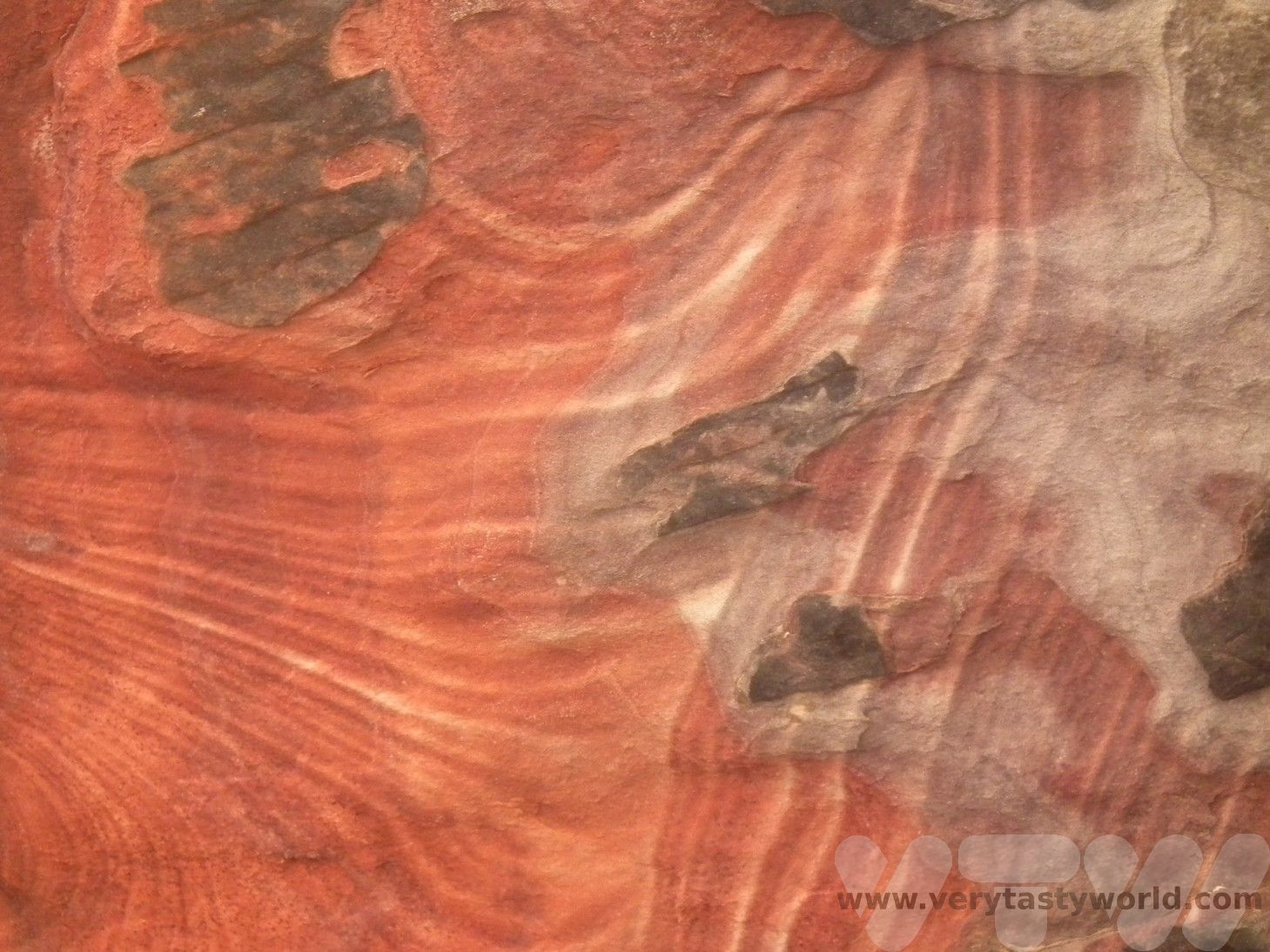
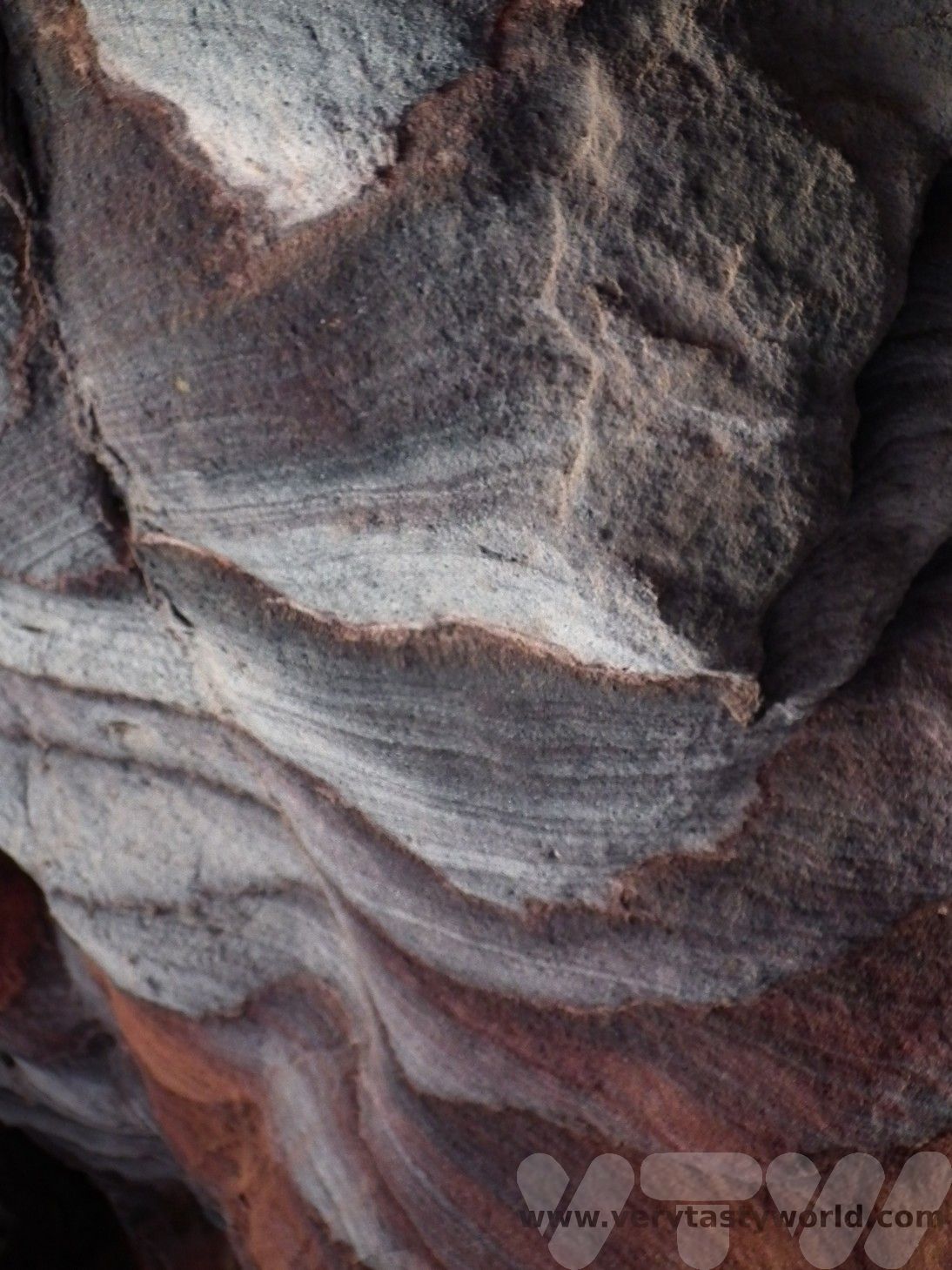
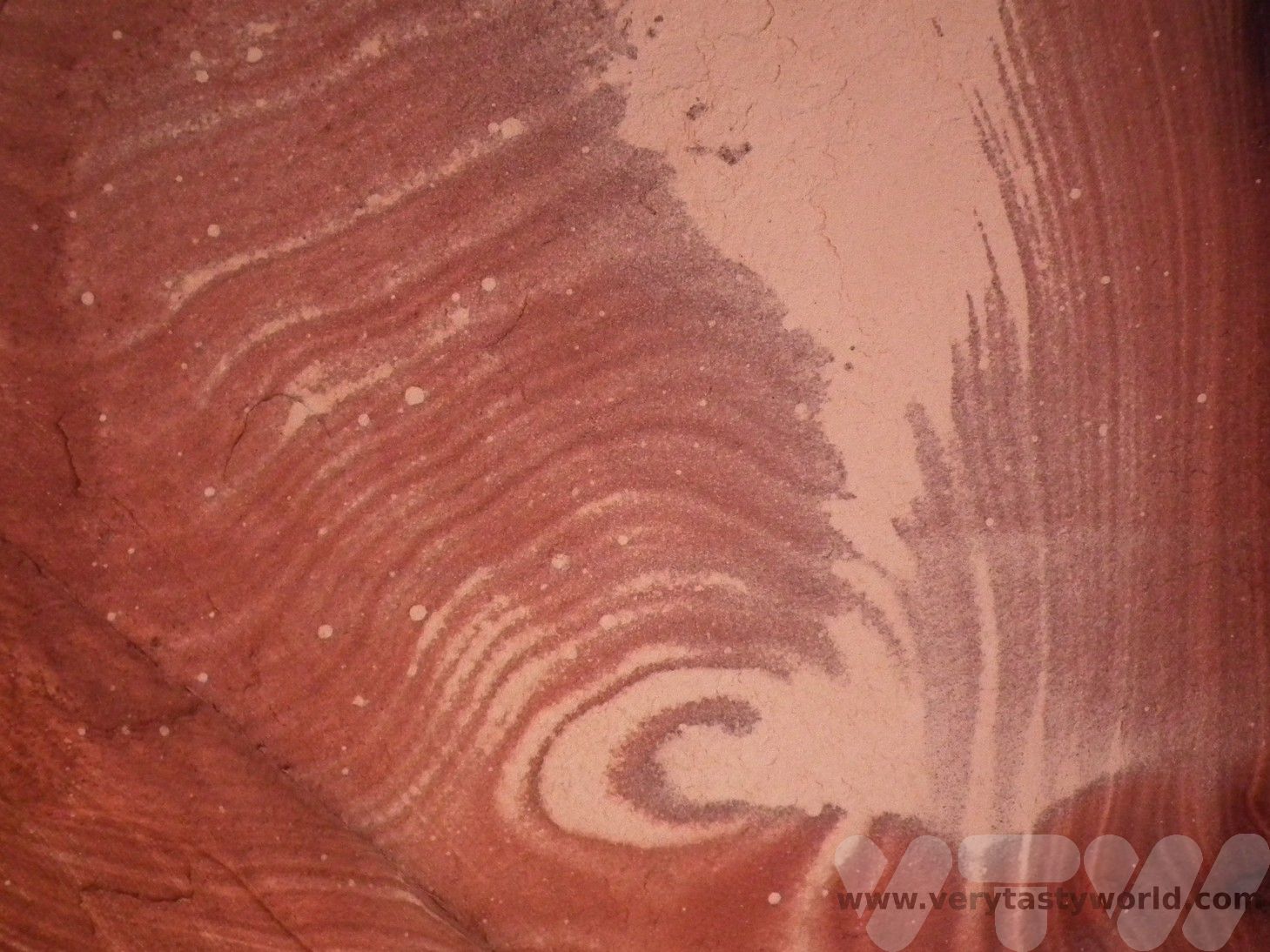
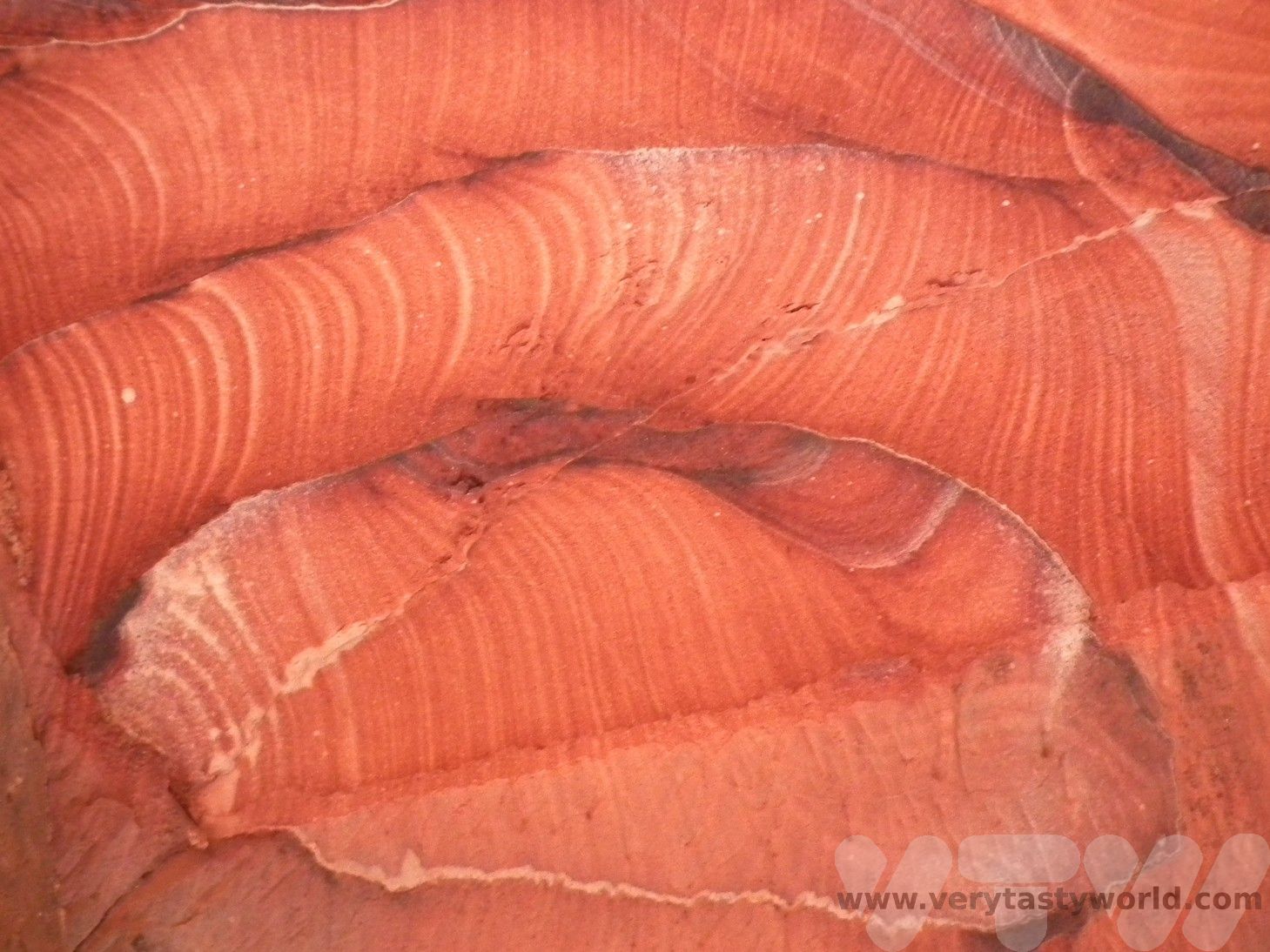
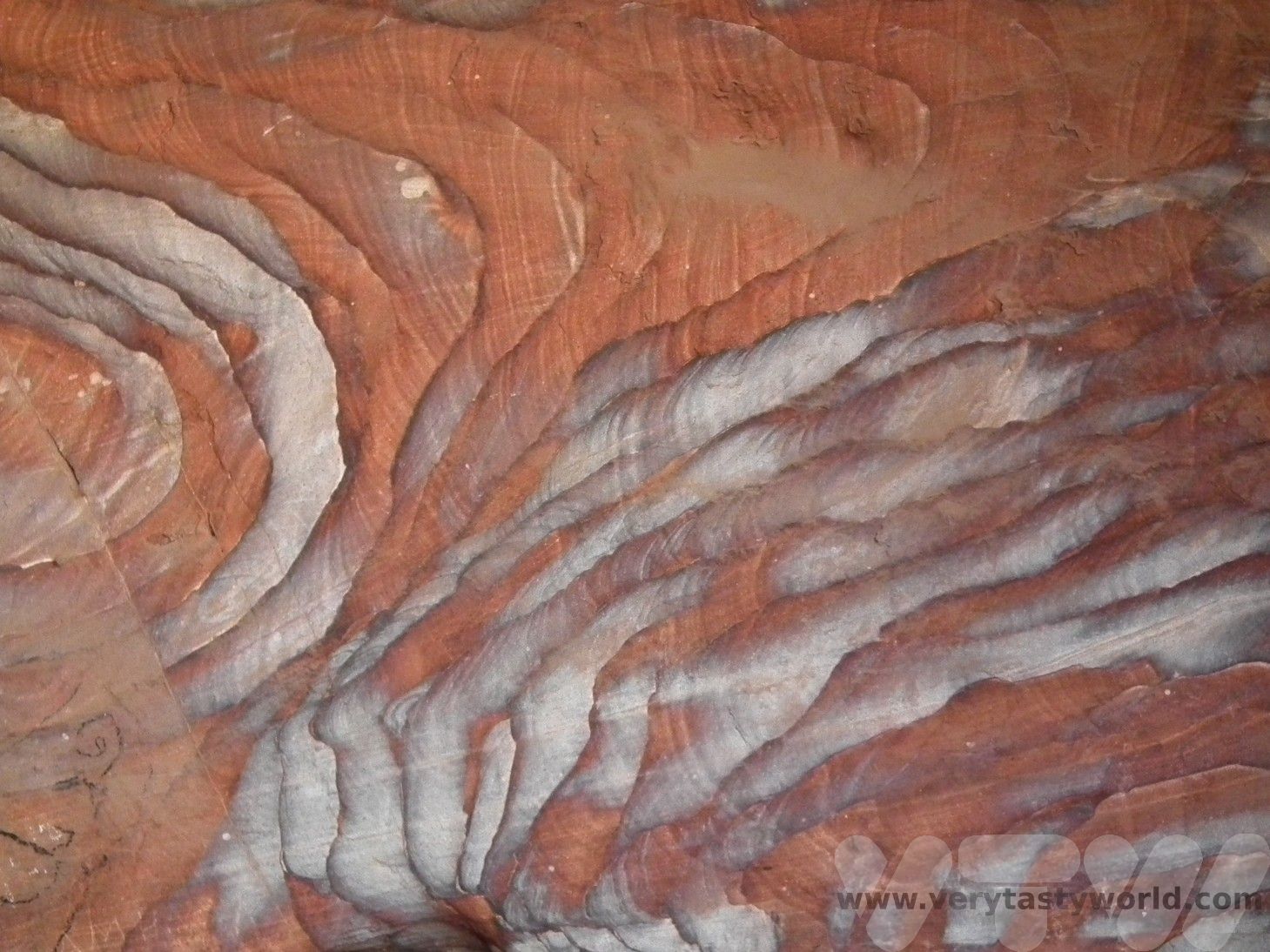
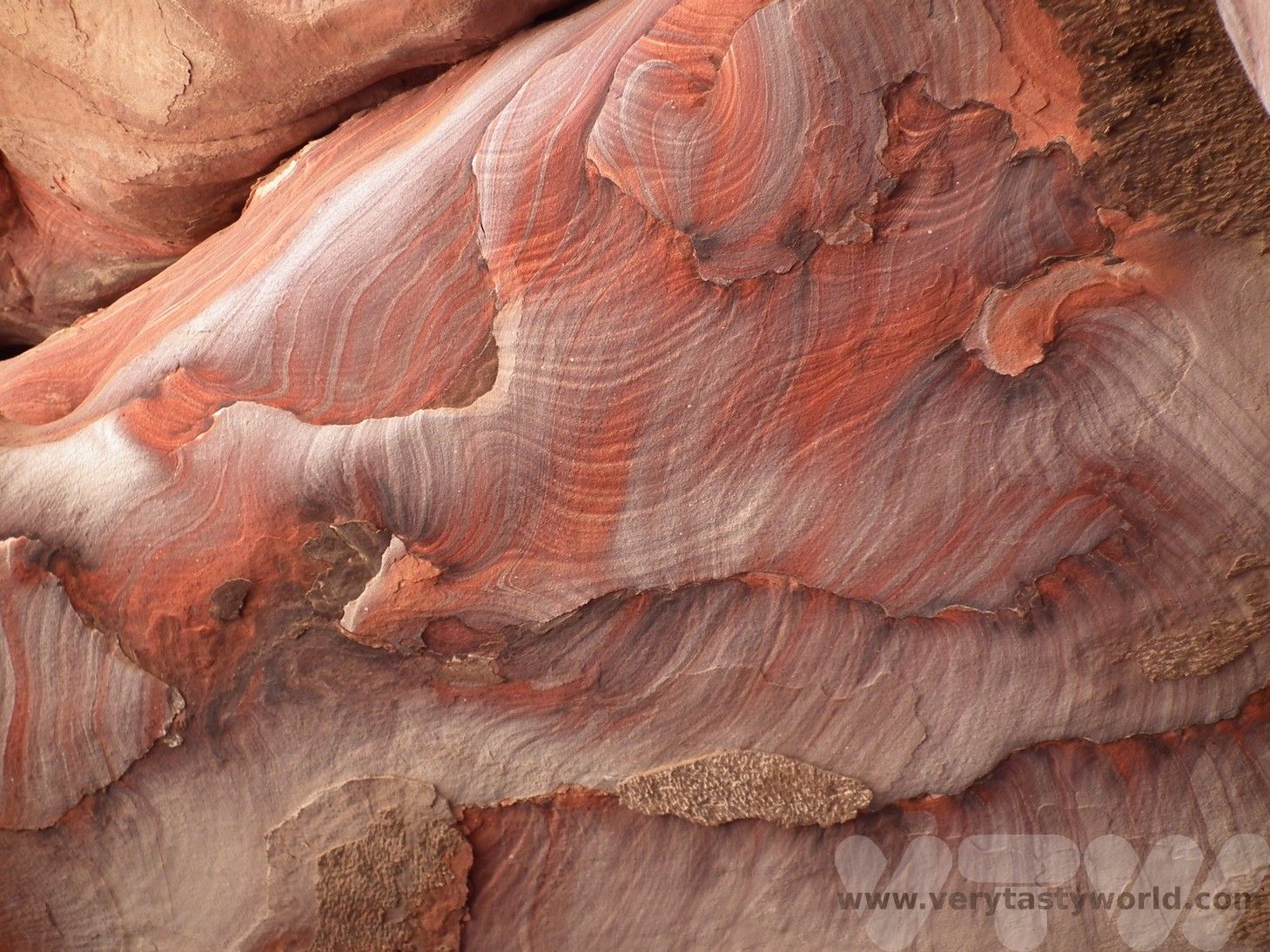
It is possible to see a night-time sound and light show at the Treasury. Walking through the Siq in the dark to see the Treasury lit up by lanterns is an ethereal sight.
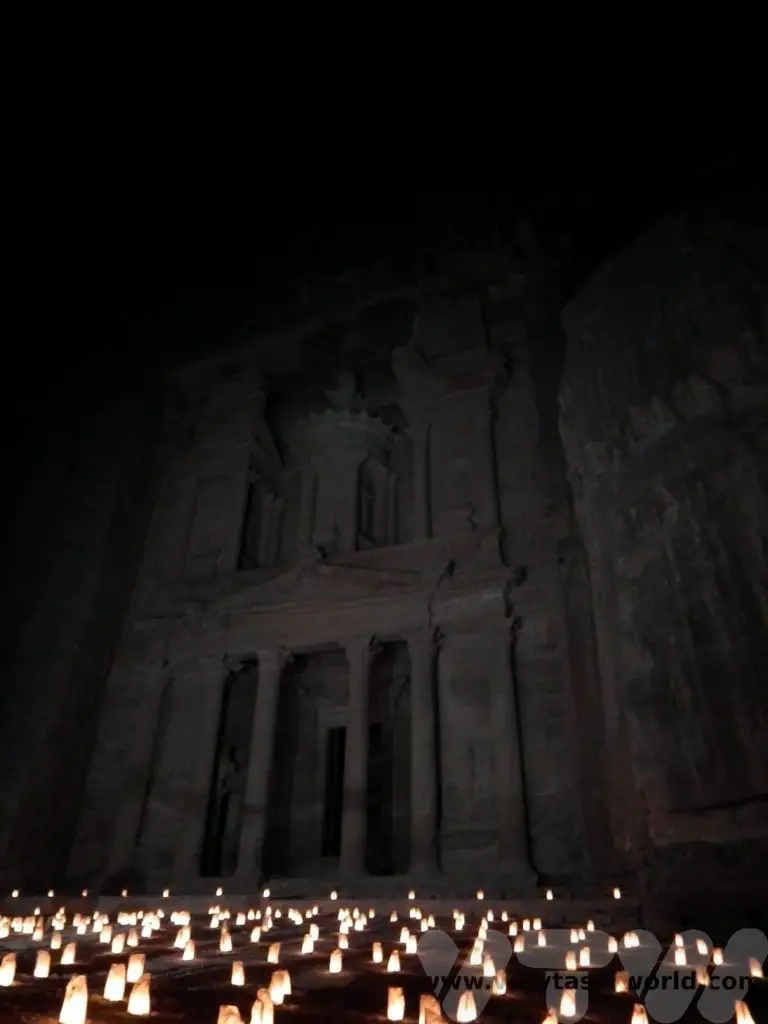
Practicalities To Visiting Petra In Jordan
There are restrooms on site at either end of the colonnaded street and nearby cafes which offer refreshments. We recommend the lemon juice with mint – it’s refreshing and delicious.
It’s advisable to wear a sunhat and use sun protection if you are exploring the walking trails as there is no shelter from the sun. Good walking shoes are advisable. Make sure you carry water with you. Use the bins provided to dispose of rubbish.
Keep on the trails. You may meet local people as you walk – we ended up chatting with some people on the Al Khubtha trail and were invited to enjoy a cup of tea with them. (We weren’t asked for money but we did offer a contribution towards the tea.)
After Your Visit To Petra – A Foodie Evening At The Petra Kitchen
After a full day’s exploring we were pretty tired and there’s not a lot to do at Wadi Musa. But we did manage to join a cookery course at the Petra Kitchen on one of the evenings. One of the chefs was the uncle of the guide who showed us around the site. We learned to make Jordanian food and then eat it – a fine way to spend an evening. We made Shourbat Adas (lentil soup), Baba Ganoush, Fatoush, Tabbouleh, Tahina salad, Galayet Bandora, Araies Iahma (Bedouin pizza – pittas stuffed with minced meat and covered with Galayet Bandora) as a mezza. The main course was Maqluba, an upside-down hotpot, which was scrummy. Sadly, we were too busy cooking – and eating – to take photos! But we do plan to cook the recipes at home and will no doubt blog about them in the future.
Related Posts You May Enjoy

Toasting Tradition in Georgia
Cheese and Toasting
There is a legend that when God was handing out land to the nations of the world, the Georgians were so busy feasting that they lost their place in the queue and there was no land left for them. But when they invited God to join the party, he enjoyed himself so much that he gave them the best bits of land that he had been saving for himself. Enjoying good food and wine is an important element of life in this part of the world and the local people have a wonderful toasting tradition in Georgia.
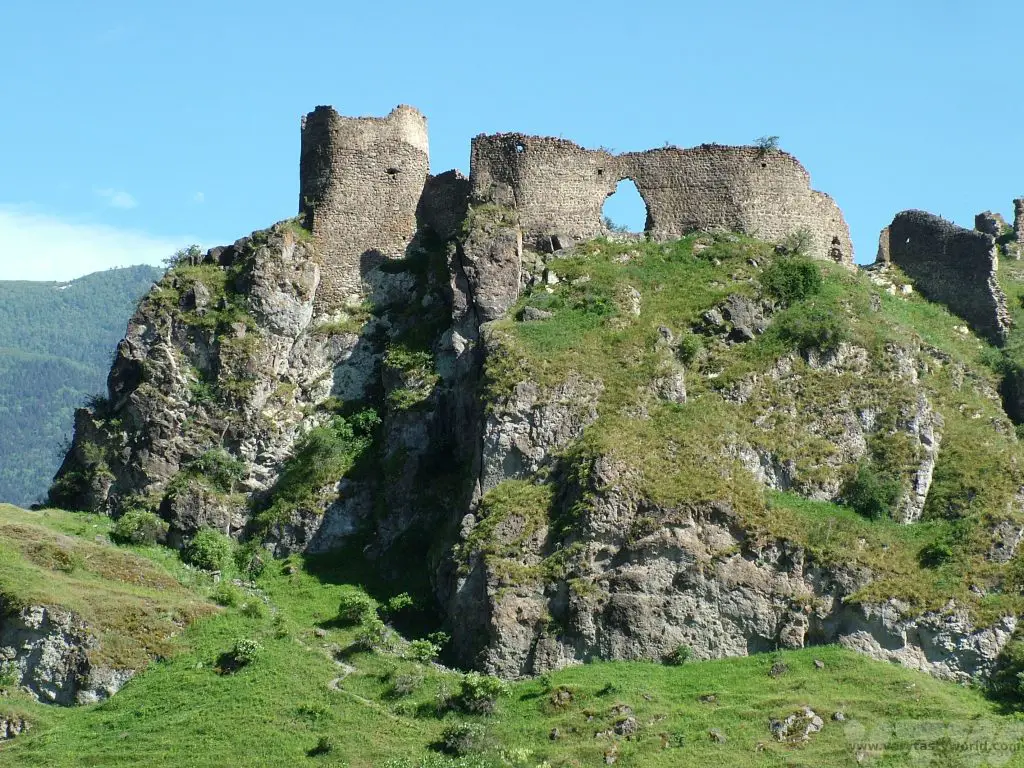
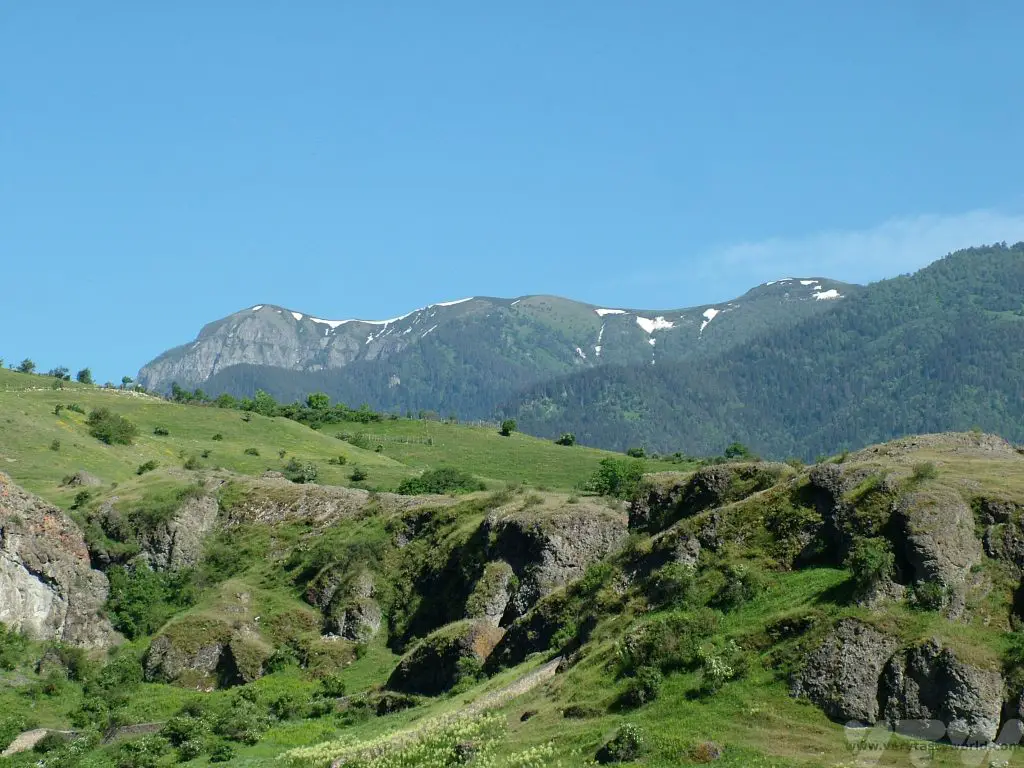
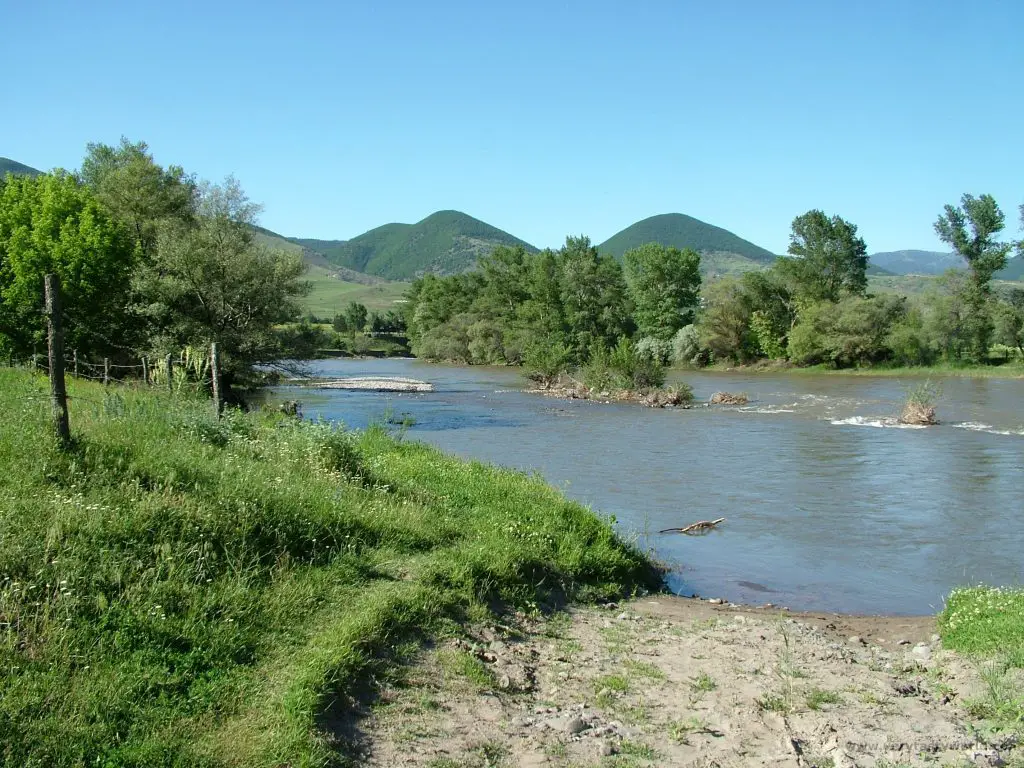
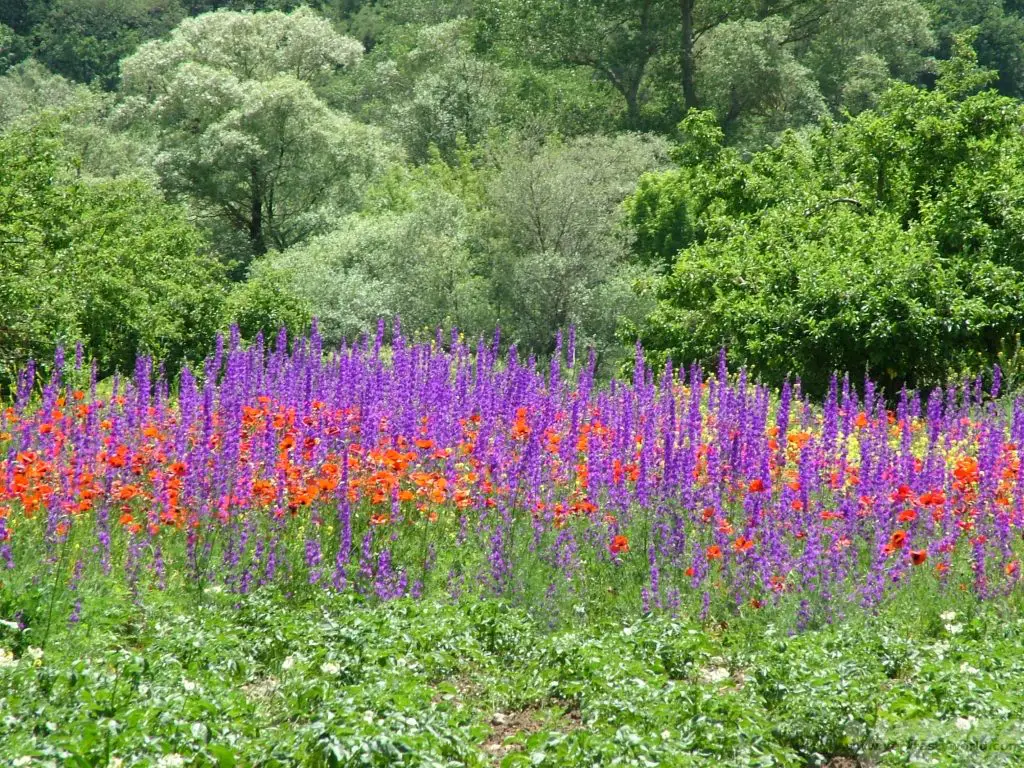
We visited a number of families, ostensibly to see how they produced wine or made cheese, but everywhere we stopped we were greeted by the most amazing hospitality and generosity. Meals would last several hours and involve large quantities of superb fresh food along with overflowing glasses of wine and chacha (grape vodka). Most houses we visited grew their own grapes and made their own wine. Many had a still.
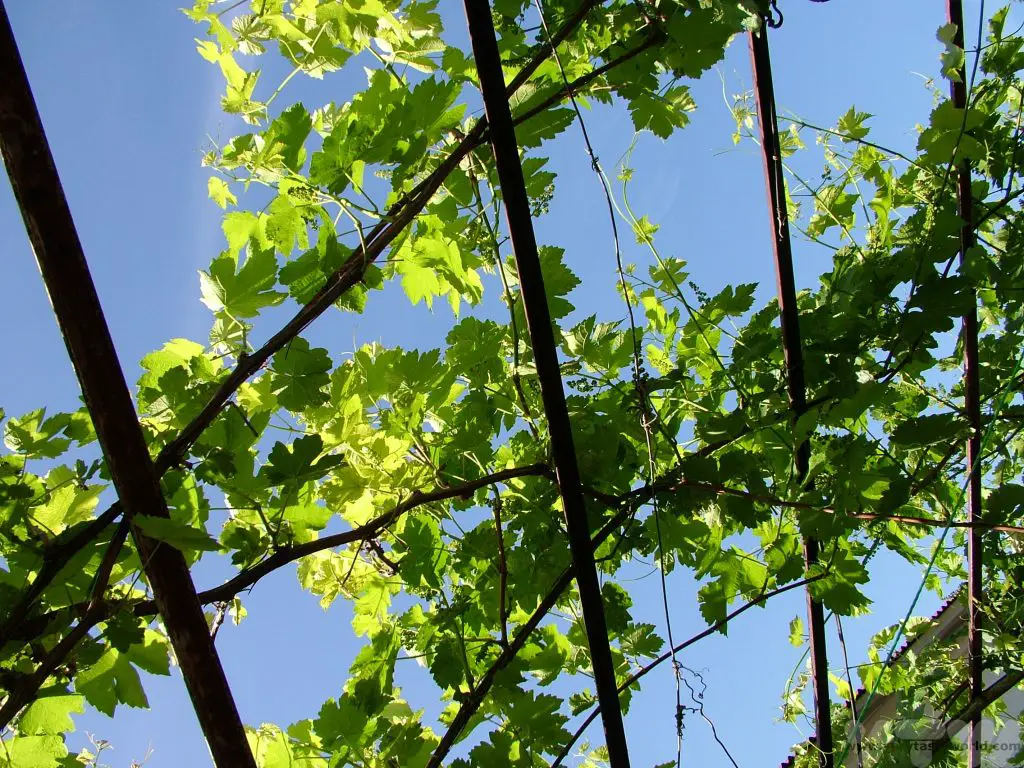
Toasting is a tradition in Georgia. You don’t tend to drink at your own pace, but at the behest of a toastmaster (tamada). A merikipe is on hand to make sure that glasses are always full and the wine never seems to stop flowing. Georgians toast their enemies with beer (we had a hilarious enemy-toasting session with our guide one night) – it is wine and chacha that are appropriate for feasting.
We didn’t go to a formal grand feast (supra), but had many, many meals at guesthouses and family homes and we followed the toasting tradition each time. Meals are designed to last the evening – they comprise several scrummy dishes laid out on the table. Everyone just helps themselves and offers food to their dining companions. And, of course, every meal included a ubiquitous, delicious and calorie-loaded cheese pie (khachapuri).
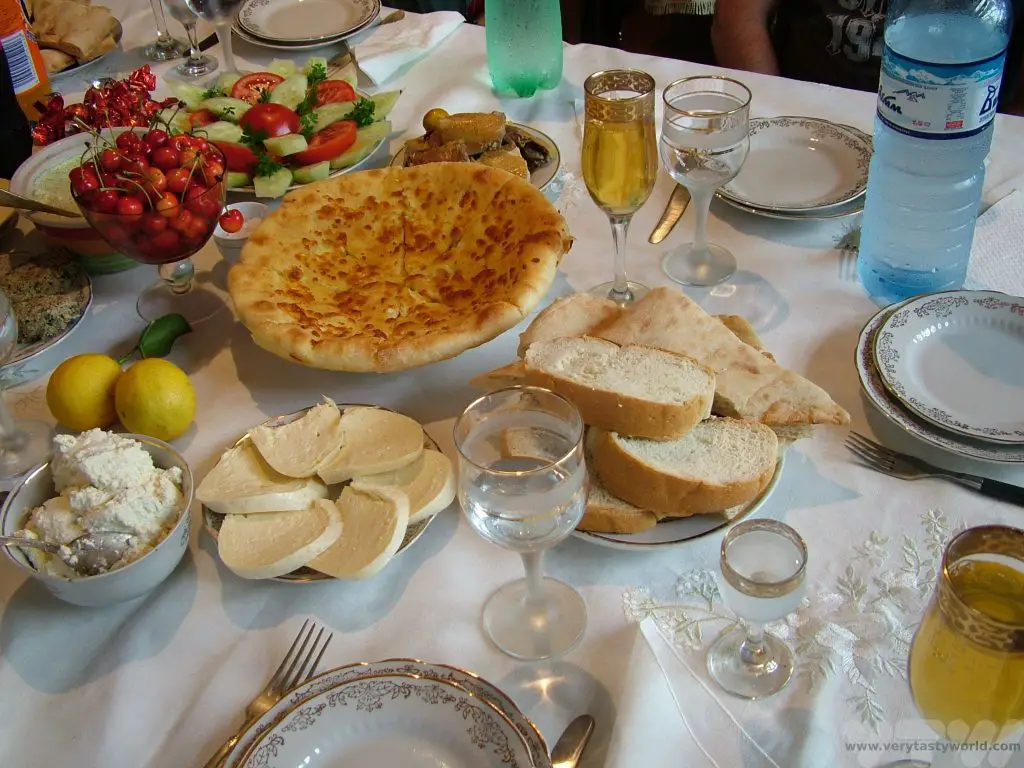
Toasting Tradition in Georgia – Etiquette
At regular intervals throughout the evening the tamada proposes a toast. Everyone adds their wishes and much wine/chacha is consumed. If you are toasted, it’s appropriate to thank everyone for their good wishes and later ask the tamada if it is okay to reciprocate with a toast of your own. One guesthouse supplied us with a very large jug of strong homemade red wine, made from the local Sapaveri grape, which was utterly splendid and eminently drinkable, to accompany the enormous evening meal they had provided.
We ate with the family. Our driver was both tamada and merikipe and led the toasting throughout the evening. (At the end of the day, naturally, when no further driving was required.) On finishing the jug our excellent merikipe asked if we wanted more wine. We said we’d join him in a tipple but only if he was partaking, not realising that he would return with another enormous jug. Gulp.
You can toast anything and everything. We were toasted several times as ‘easy guests’ (people who were thoroughly enjoying the trip, didn’t make a fuss, and were always on time) as well as ‘guests that didn’t go to bed at 9pm but were happy to stay up late feasting and enjoying the hospitality of our hosts.’ We reciprocated by toasting our hosts, Georgia, Georgian hospitality, wine, food, cheese pies, family, friends, finding Mr Right (for our guide), young people, old people, men, women, happiness, health, friendship between our countries, anything. We easily knocked back the second jug. Amazingly we weren’t hungover the following morning. Just as well as we were due to visit three different vineyards for wine tasting – hair of the dog and all that. We did rather stagger round the Kakheti region that day.
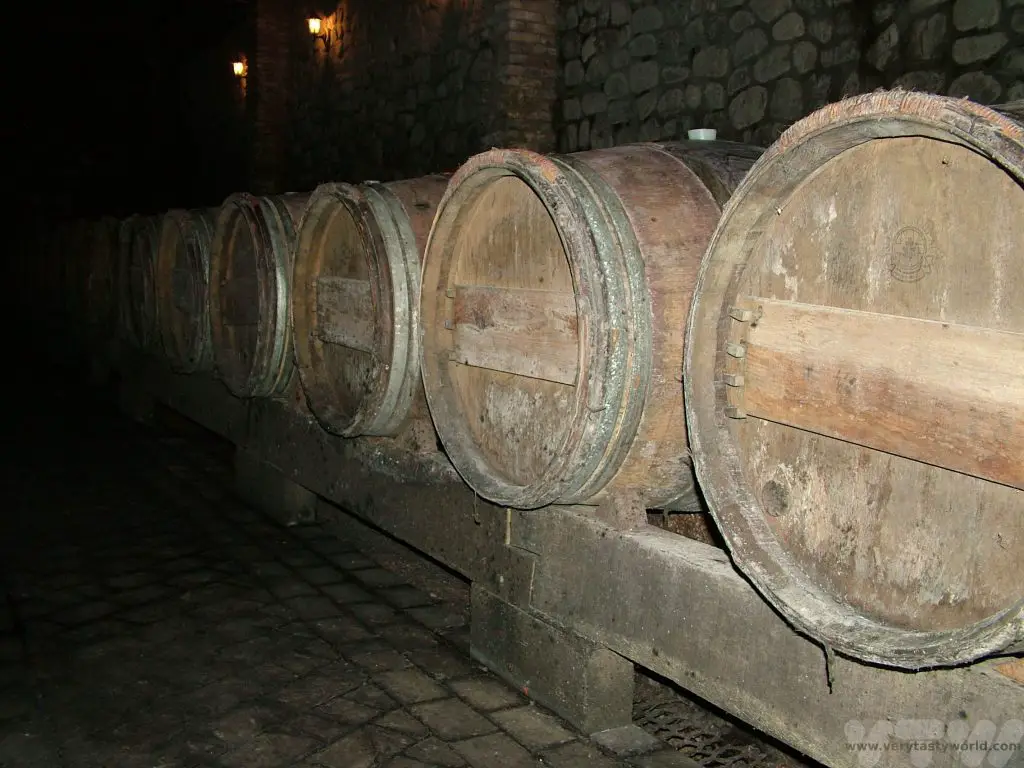
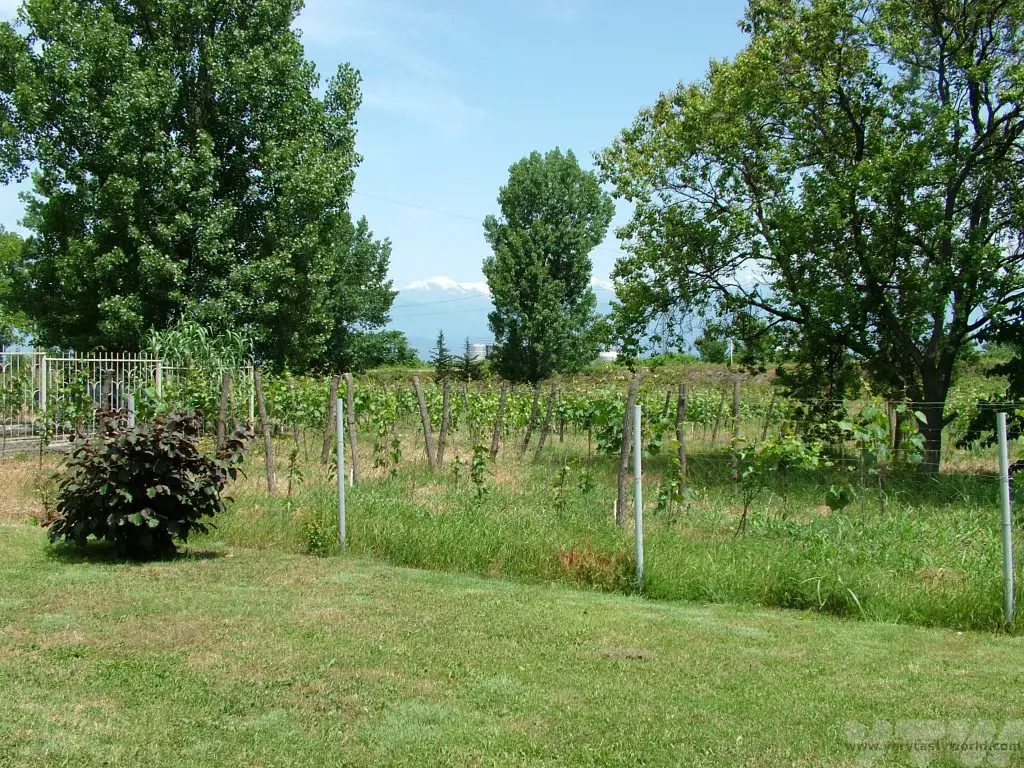
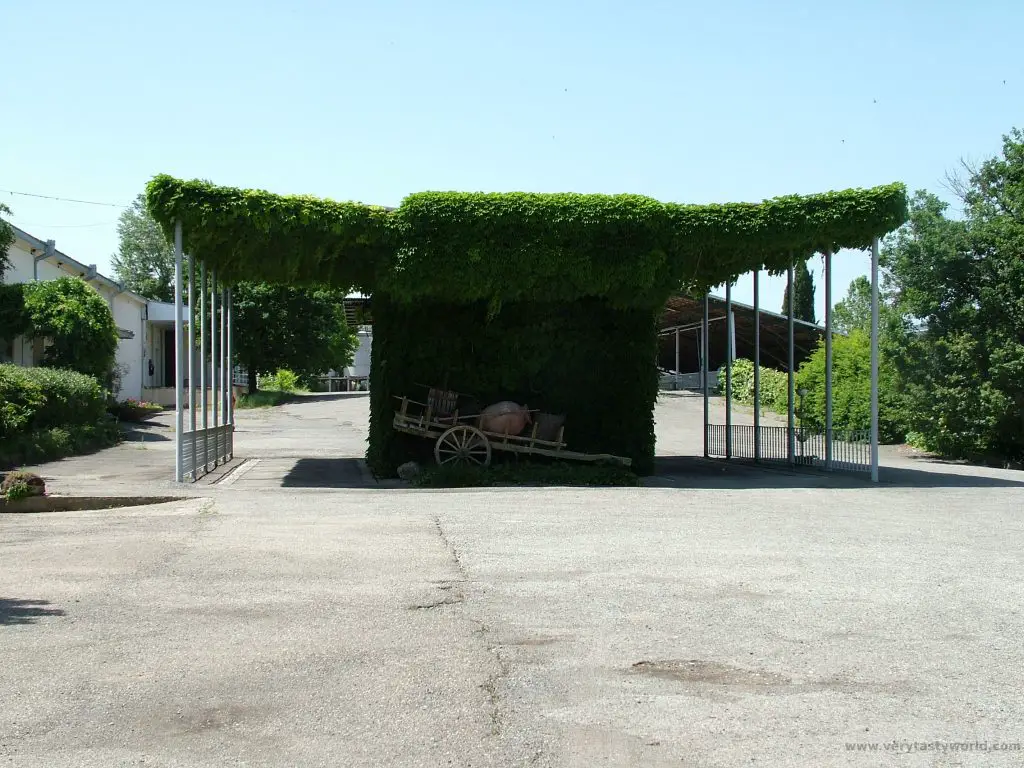
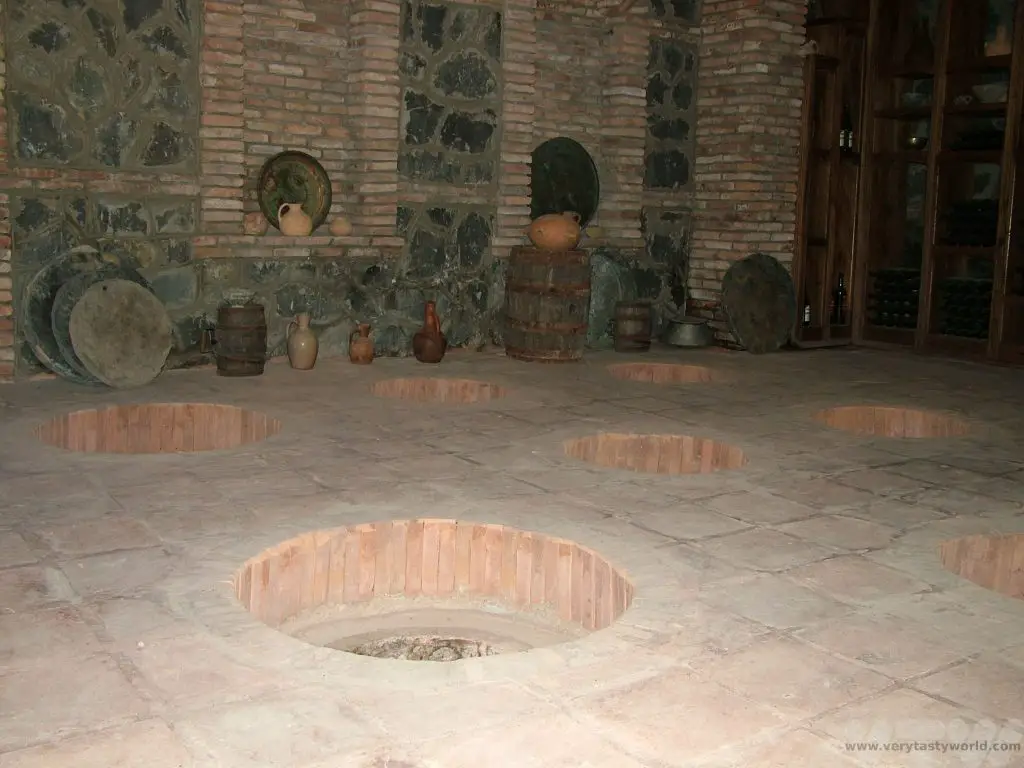
What we didn’t realise until the last day was that we had been doing the toasting all wrong. We’d been having a sip/swig from the glass per toast which seemed to us to be the best way to regulate the drinking (we’d copied our hosts, who had the same idea). Apparently the correct toasting tradition in Georgia meant that were supposed to drain the wine/chacha glass each time. Oops!
Related Posts You May Enjoy

Visiting The Dead Sea In Jordan
Taken with A Pinch of Salt
The Dead Sea is one of the strangest places on the planet. It is a salt lake located in a depression at the lowest place on earth, over 400m below sea level, which is bordered by Israel and the West Bank to the west and Jordan to the East. Visiting the Dead Sea in Jordan was an essential part of our itinerary on our journey through this fascinating country.
The area has an odd microclimate – it’s 10⁰C warmer at the coast than in the rest of the country. And the Dead Sea really is dead. At around 35% salinity it can’t support any life. Any unfortunate fish that happens to swim in there from the river Jordan lasts but moments. There is no activity on the water either – you don’t see any boats or water sports. The water is so saline it basically destroys machinery. The only thing you can really do there is bathe. And bathing in the Dead Sea is undoubtedly an experience.
The north end of the sea is mainly comprised of resort hotels of varying degrees of poshness, which have private beaches where you can do all sorts of spa type stuff, and the rest is rather beautiful coastline. We travelled along the shore on the Jordanian side on our way to the rose red city of Petra.
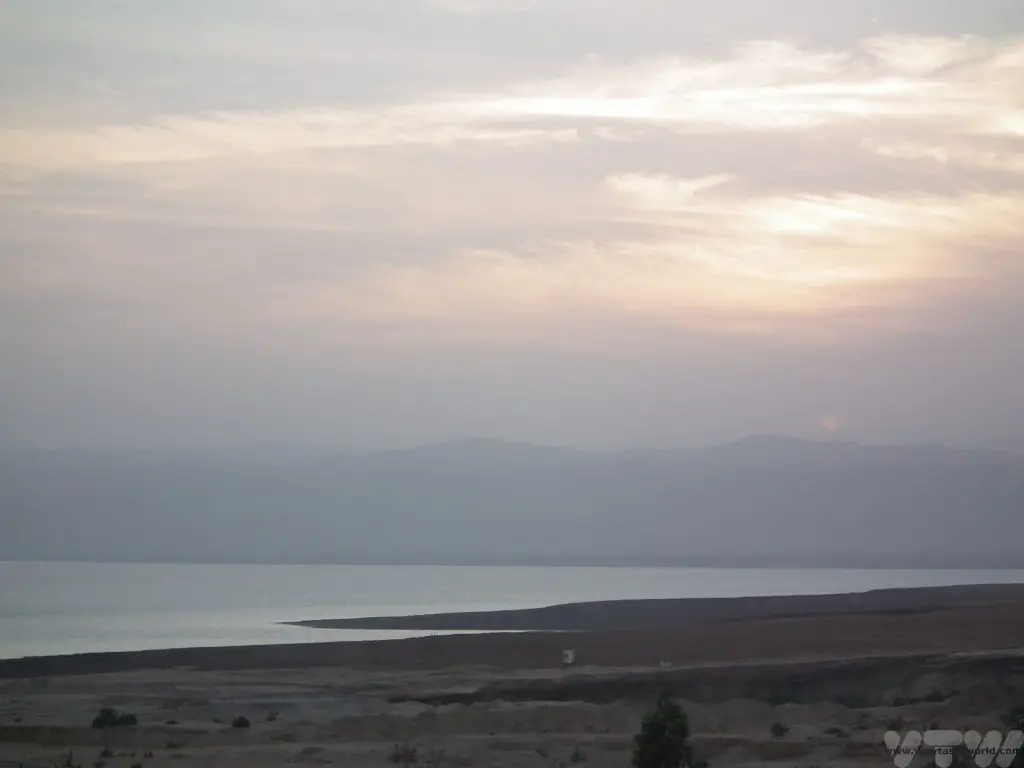
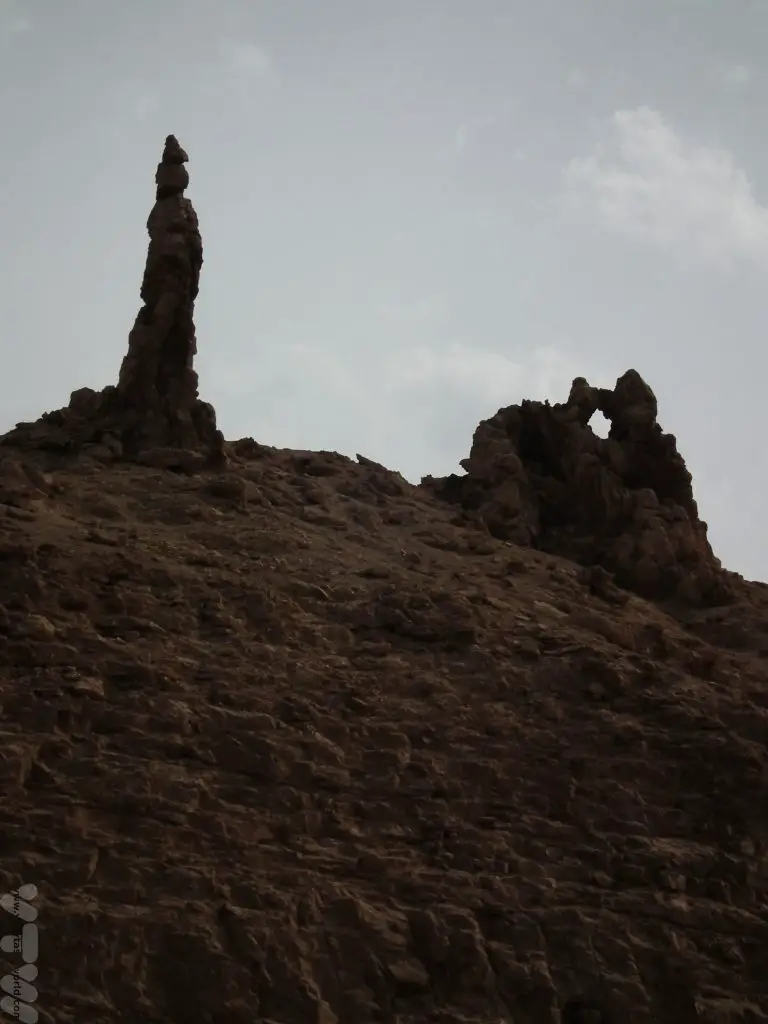
There is a pillar of salt, considered by locals to be Lot’s wife from the biblical story.
We decided to stay at a resort for just one night. The hotels on the north coast in Jordan are fairly self-contained and you are pretty much tied to the activities and restaurants there. For example, it was difficult for us to find somewhere to eat at establishments outside the resort and outside restaurants are more likely to cater to tourists. Our hotel had its own beach located about a two minute drive via a free shuttle bus (if you were lazy) or a ten minute walk from the swimming pools. Initially we wondered why there were pools when the purpose of our visit was to swim in the sea but it became clear later when we bathed.
Eternal Youth and Beauty?
Dead Sea mud apparently contains all sorts of minerals that are supposed to do wonders for your skin. And, like the Blue Lagoon in Iceland, you can buy a plethora of products containing miraculous mud at hugely inflated prices that are guaranteed to help you achieve eternal beauty. Or something. We headed down to the beach and caked ourselves in free mud from a bucket by the water’s edge before heading into the sea.
Bizarre Bathing
When visiting the Dead Sea in Jordan we absolutely had to bathe. It is impossible to sink in the Dead Sea. You walk in and keep walking. And then, when the water is about at chest height, you take another step and realise that you should be able to touch the sandy floor, but you can’t, yet the water is still at chest height.
It is also impossible to swim in the Dead Sea. When trying to do a simple breast-stroke you are so buoyant that your bottom kind of flips up, pushing your face into the water, which is a really bad idea because if you get any water in your eyes it stings like crazy. You know that feeling when you’ve been chopping chillies and forget to wash your hands and then brush your eye? That burning agony? Well, it’s ten times worse if you splash Dead Sea water in your eye. The water feels oily and hurts like hell.
The easiest way to bathe is simply to float in a sitting position. It’s very comfortable. If you want to move around, sculling gently seemed to produce the required propulsion. We didn’t take pictures of ourselves reading books or anything but it really would be perfectly possible.
When you emerge from the sea you really need to shower off quickly and get all the salt off your skin and bathing suits. Any fabric splashed with water becomes stiff as a board and encrusted with salt. Fresh water showers are located on the beaches, not far from the shore, so that you can clean up quickly.
We’re not convinced that the mud did endow us with eternal beauty but bathing was an most definitely an interesting experience.
Natural Beauty of the Dead Sea
What was truly beautiful was the salt-encrusted shoreline.
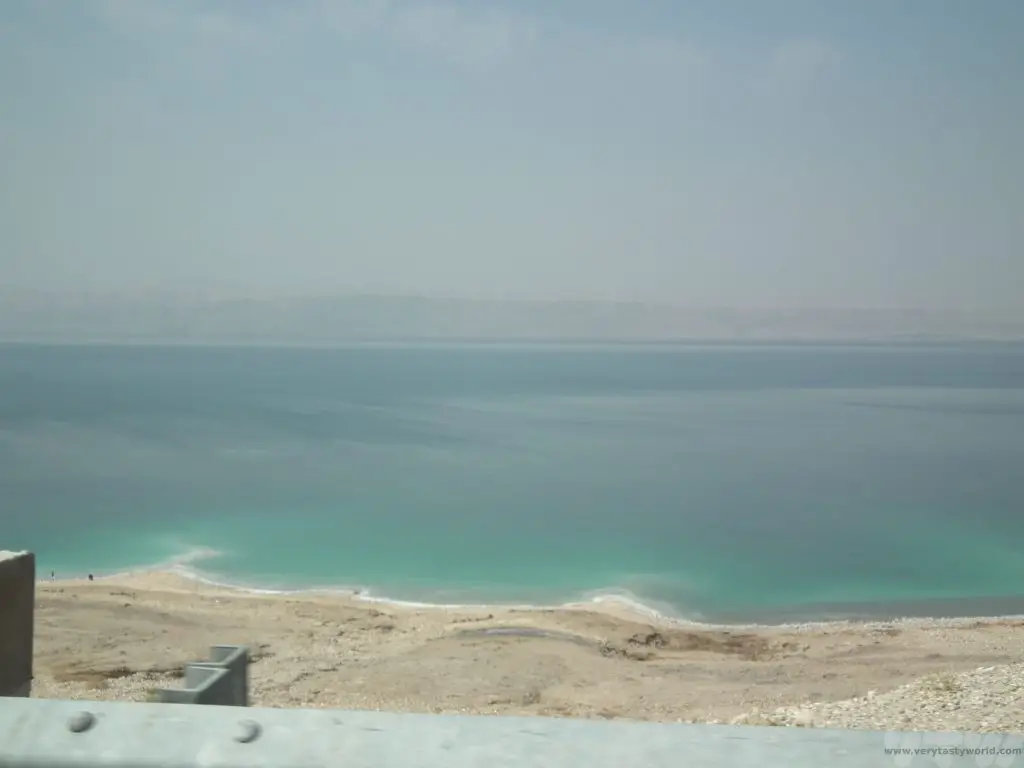
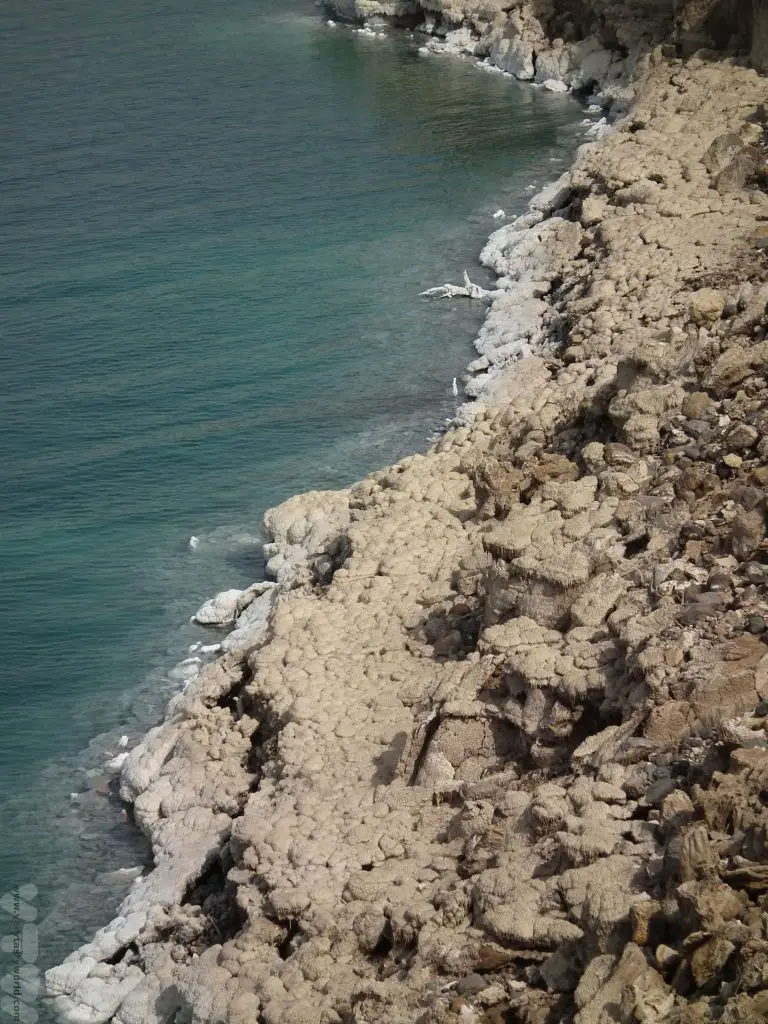
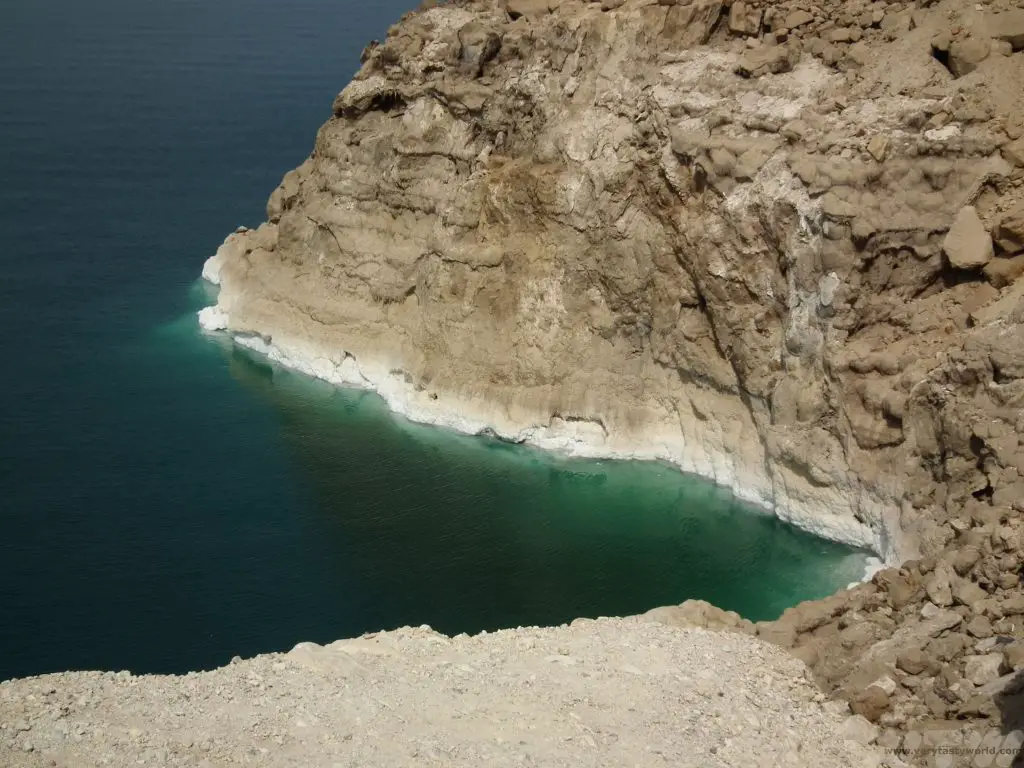
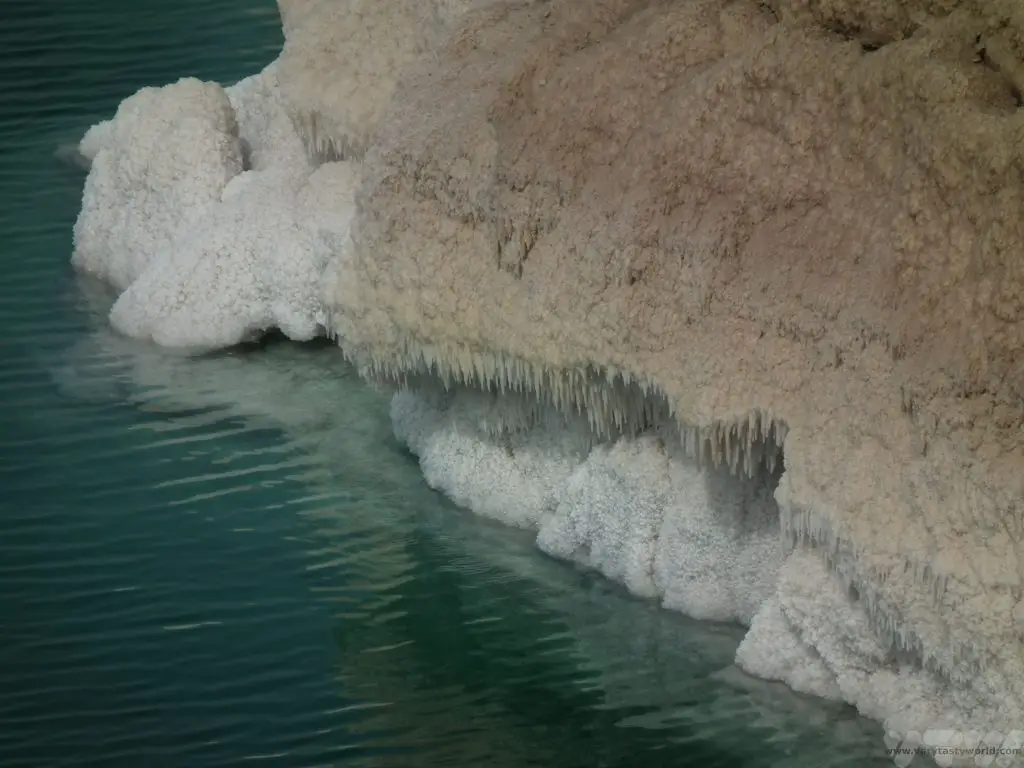
We did wonder whether Dead Sea salt was edible as most sea salt can be used for seasoning and preserving. However, the merest (accidental) taste of Dead Sea salty water will confirm beyond any doubt that in its basic form it tastes revolting. The mineral composition is very different to standard sea salt, and tastes extremely bitter, so processing is needed to remove these in order to ensure safe – and tastier – use for human consumption.
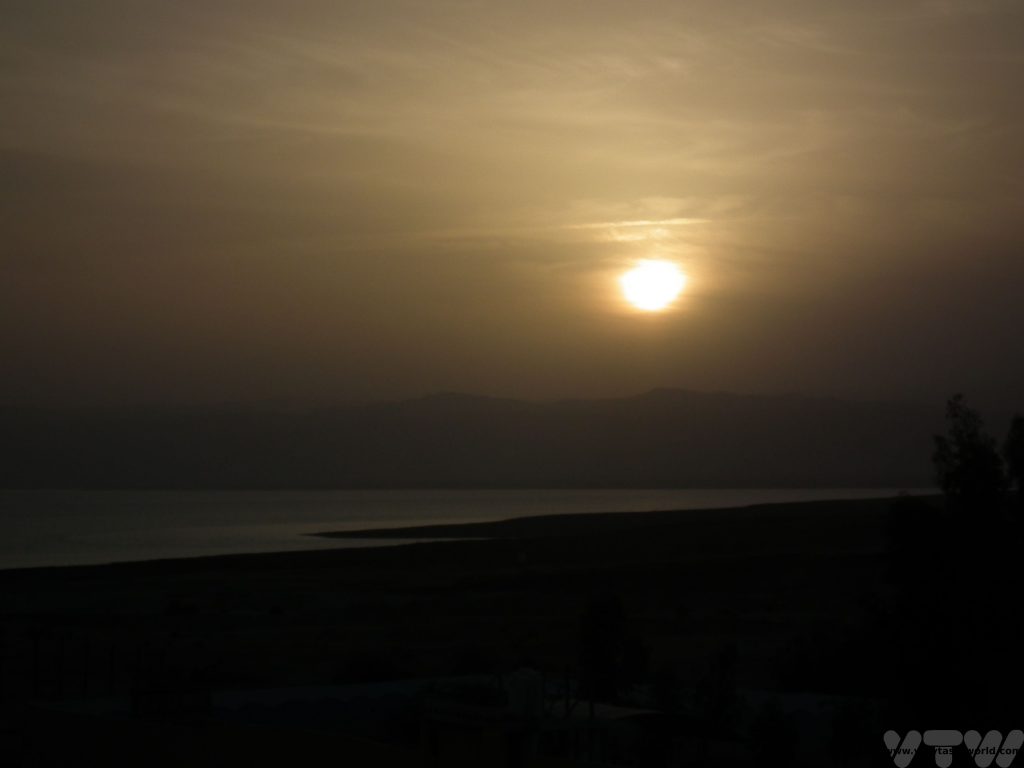

The Roman Ruins in Jerash, Jordan
Roman Streets and Sweet Treats
The Roman ruins at Jerash Jordan are some of the best preserved in the world. Jerash is within an easy 50-ish km drive of the capital Amman. The site makes for a fascinating day trip; covering a very large area it is possible to wander all over the city. It is definitely worth finding a guide who can point out all the features and explain the history and the architecture, especially as there aren’t many signs or information points, although beware as they may encourage you to buy stuff you don’t really want to buy from various vendors who can be found waiting for tourists.
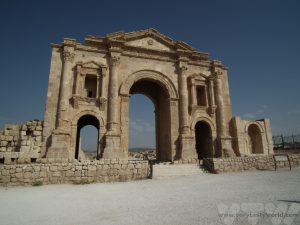
The arch of Hadrian (who had already started construction of the wall in the north of England) was erected around 129-130 AD , when the Emperor visited Jerash.
The hippodrome was an enormous arena which was used for chariot races and gladiator fights. Sometimes chariot races are re-enacted in the space. Sadly, not when we visited.
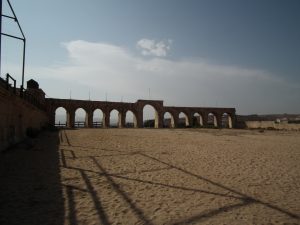
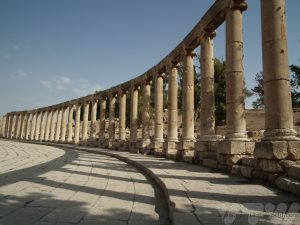
The colonnaded forum, an area designed as a marketplace but used for social gatherings, including important political meetings, is stunning. Its oval shape is very unusual.
The nymphanium, a monument to the nymphs, was fed by an aqueduct.
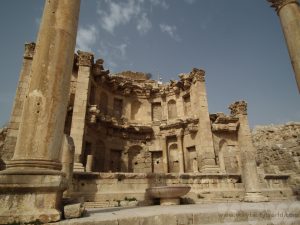
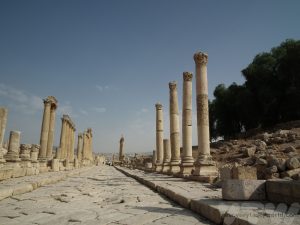
It’s possible to walk down the roman street, also known as a cardo and as straight as Roman roads are reputed to be, again lined with columns. The road’s surface is original.
There’s an amphitheatre where you can stand on the stage and let your inner thespian out. Even if you don’t feel up to a full performance of your favourite speech, it’s worth standing on the stage and just speaking – the acoustic design of the theatre ensures that your voice can be heard with remarkable clarity, even normal speech levels.
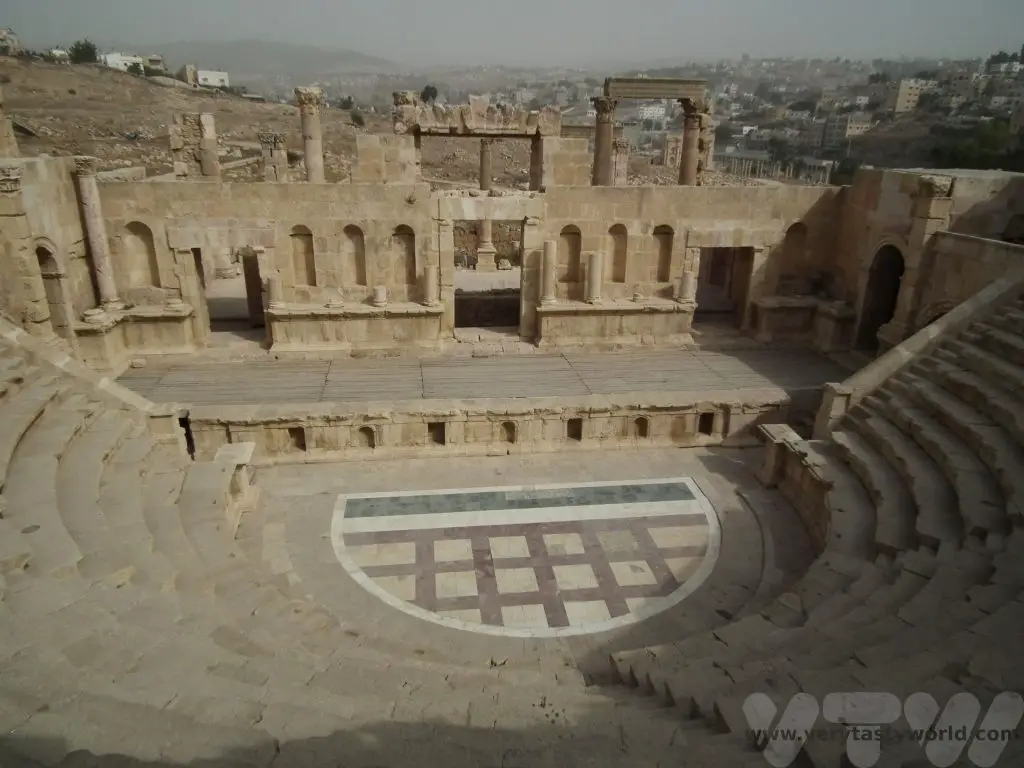
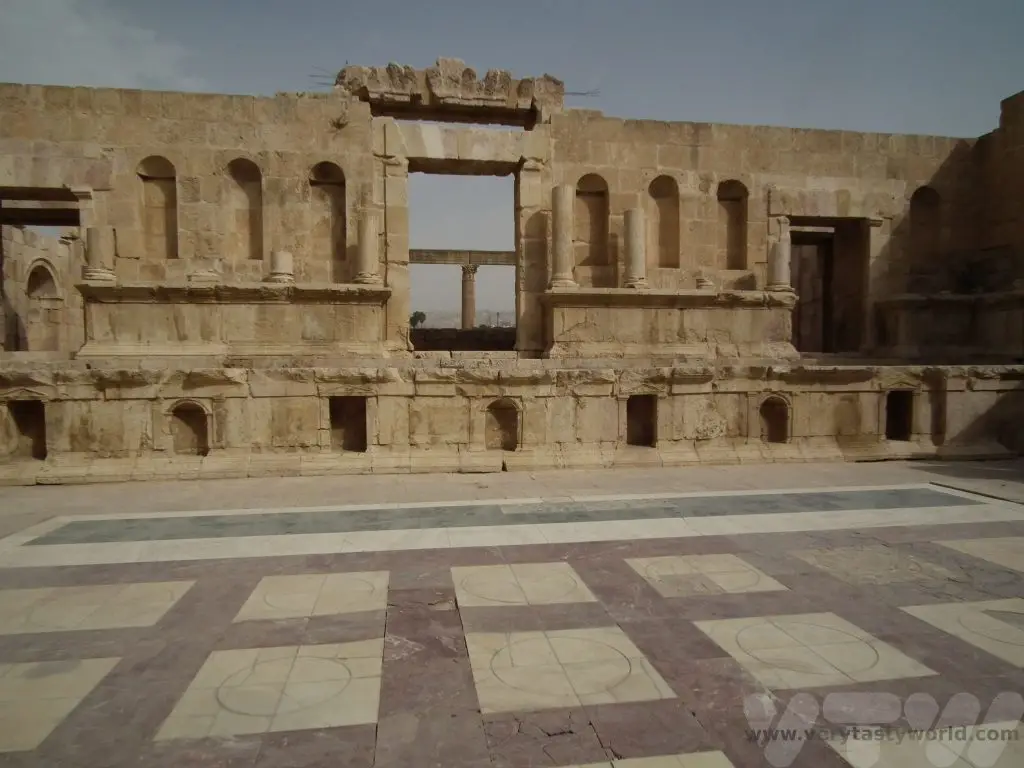
And at the end of a day’s exploration of the Roman ruins in Jerash, you are likely to be peckish. We were. Amman has some really excellent restaurants so on our return to the capital we went to Habibah to eat kanafeh.
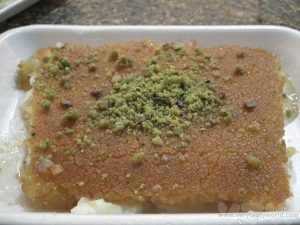
Other Posts You May Like
Who Ate All the Pies (Including the Georgian Cheese Boat)?
Er, we did. Georgia (the one that’s always on my-my-my-my-my-my-my-mind, not the one where the midnight train goes) is famous for feasting. It is thought that wine was possibly invented in Georgia. And we all know that the thing that goes best with wine is cheese*. And the country is famous for its cheese pies including the Georgian cheese boat.
We ate cheese every day on our trip. It felt like our arteries had the consistency of Primula by the time we arrived home but it didn’t matter – all the cheese was utterly delicious. We tried many varieties including Meskh cheese which was like cheese strings, but not made of nasty chemicals, Imeruli cheese, a mild, tasty and very holey number from the Imereti region which can then be made into Sulguni which is most popular in the Samegrelo Region. We visited a family who demonstrated how to make Sulguni and then offered us lots of it with an unexpected feast for lunch. Georgian hospitality is simply unsurpassed.
Much of the cheese we consumed involved tasting the regional variations of the national dish – cheese pie or khachapuri – which was served at pretty much every meal we ate. Each pie contains about 150,000 calories but don’t worry, it’s worth it. The pie itself is bread based rather than pastry based and filled with varying amounts of cheese, from the relatively modest Imeruli pie which merely contains cheese inside the pie, to the more decadent Megruli which melts a few pounds of cheese on top, just in case the cheese inside doesn’t quite satisfy your cheesy cravings.
Imeruli is the most common type of cheese pie.
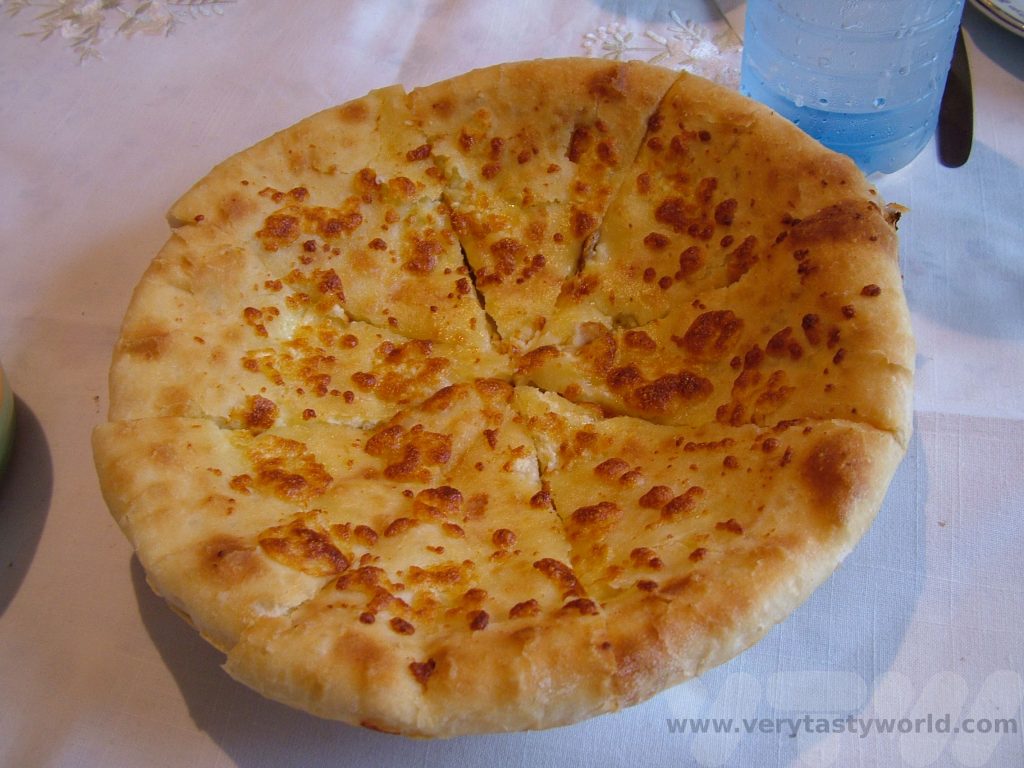
We ate this with most meals in central and eastern Georgia – the capital Tblisi and its surrounding regions.
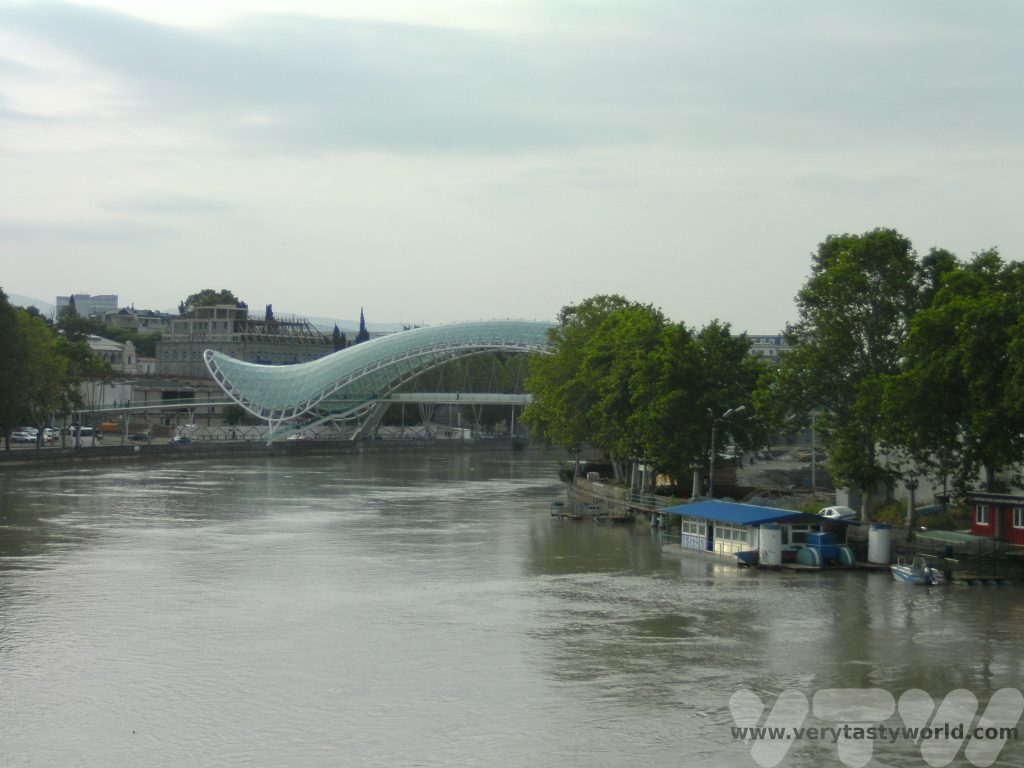
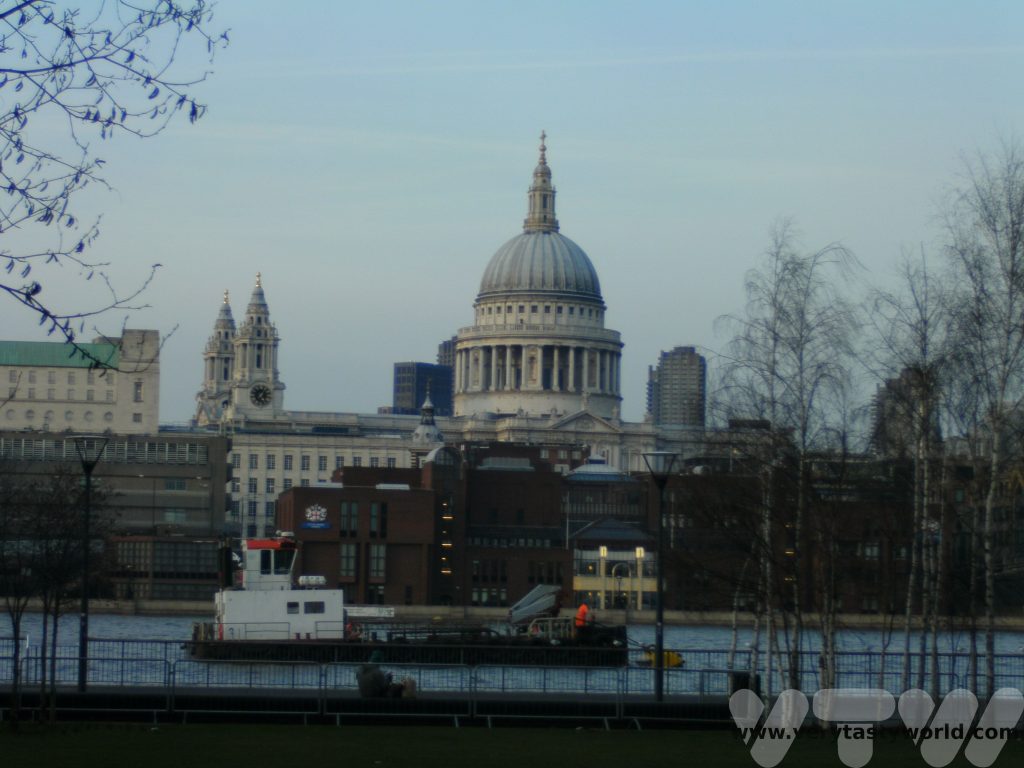
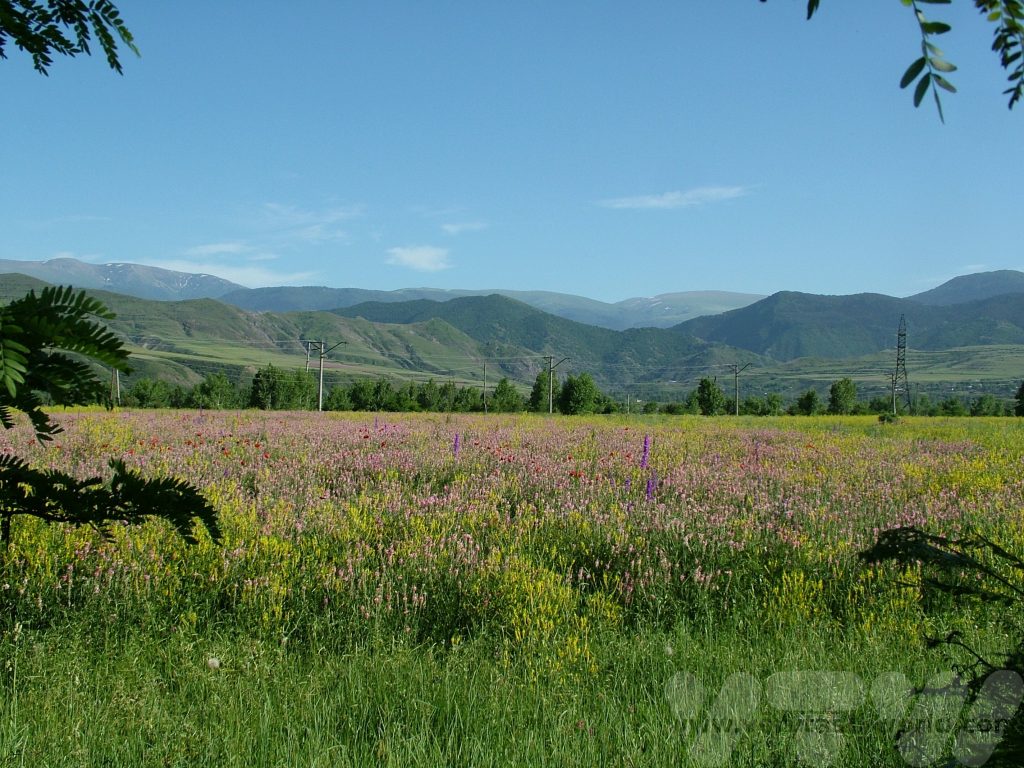
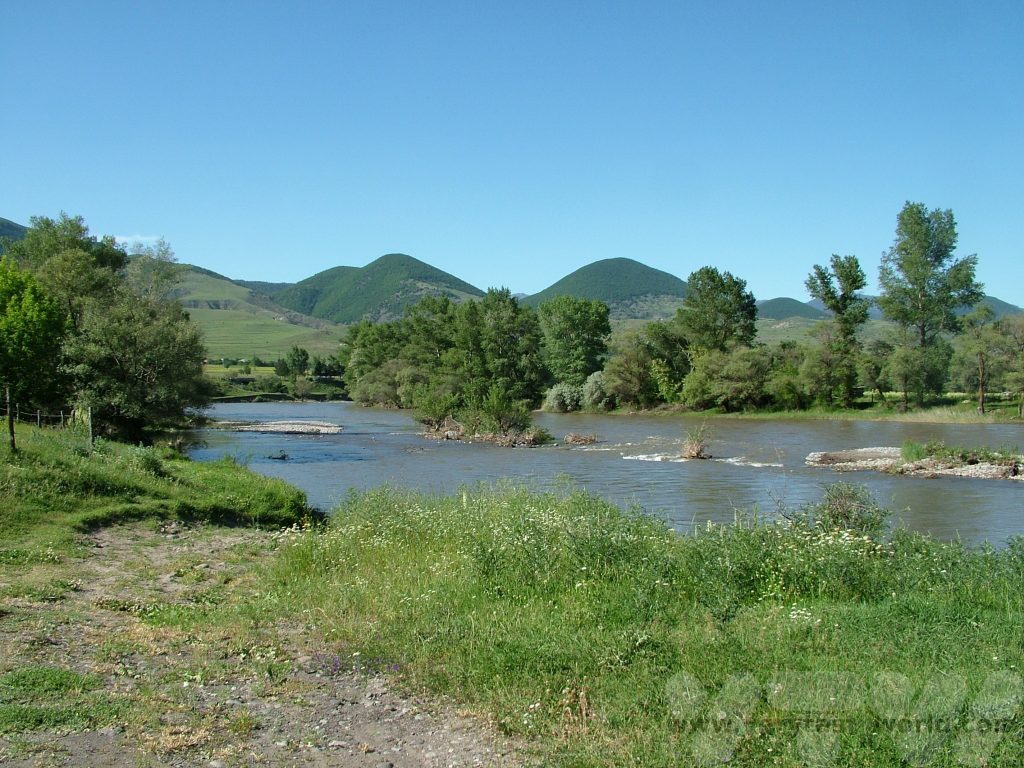
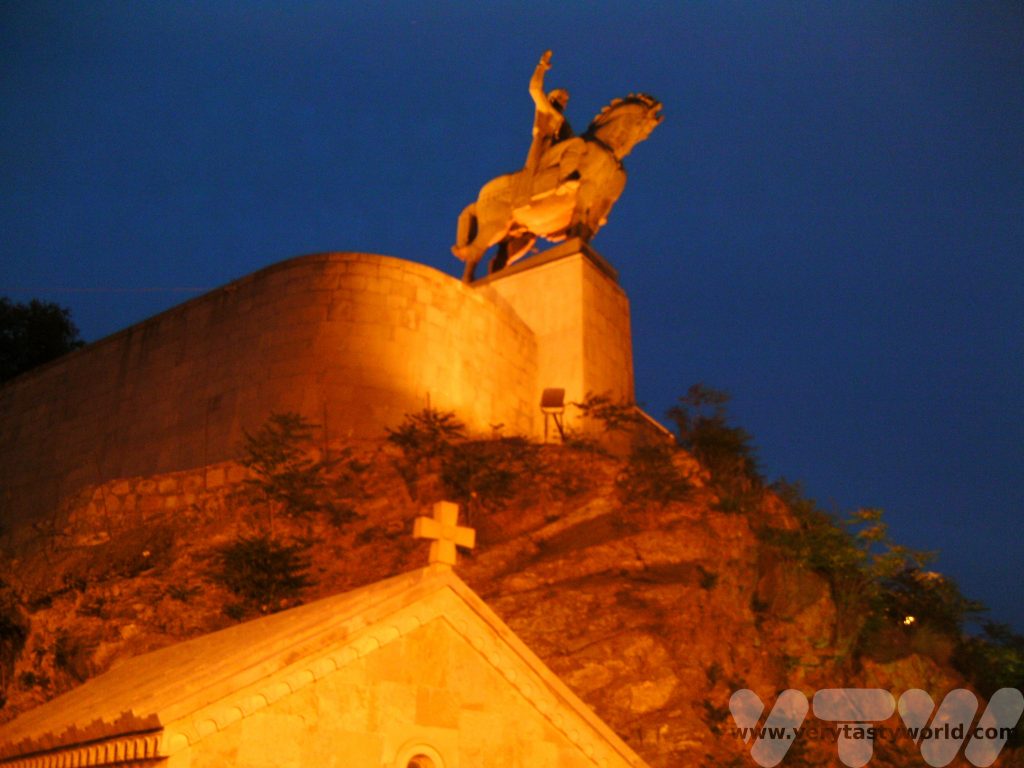
The western part of Georgia lies on the Black Sea cost. Batumi is a resort and is clearly a party town.
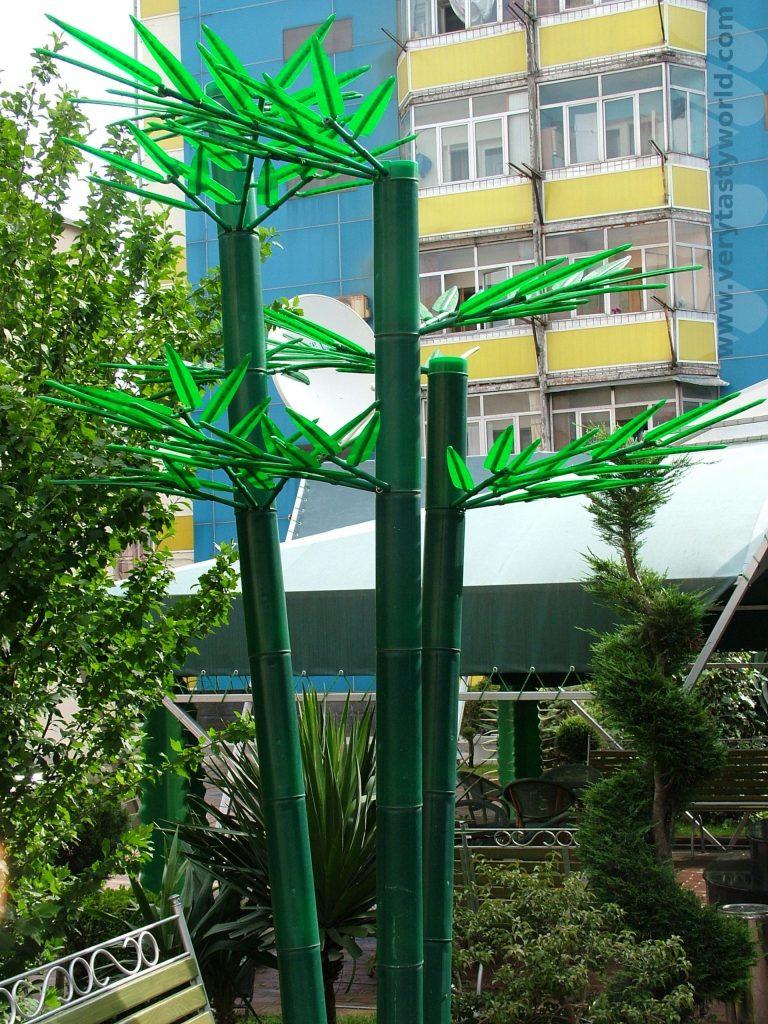
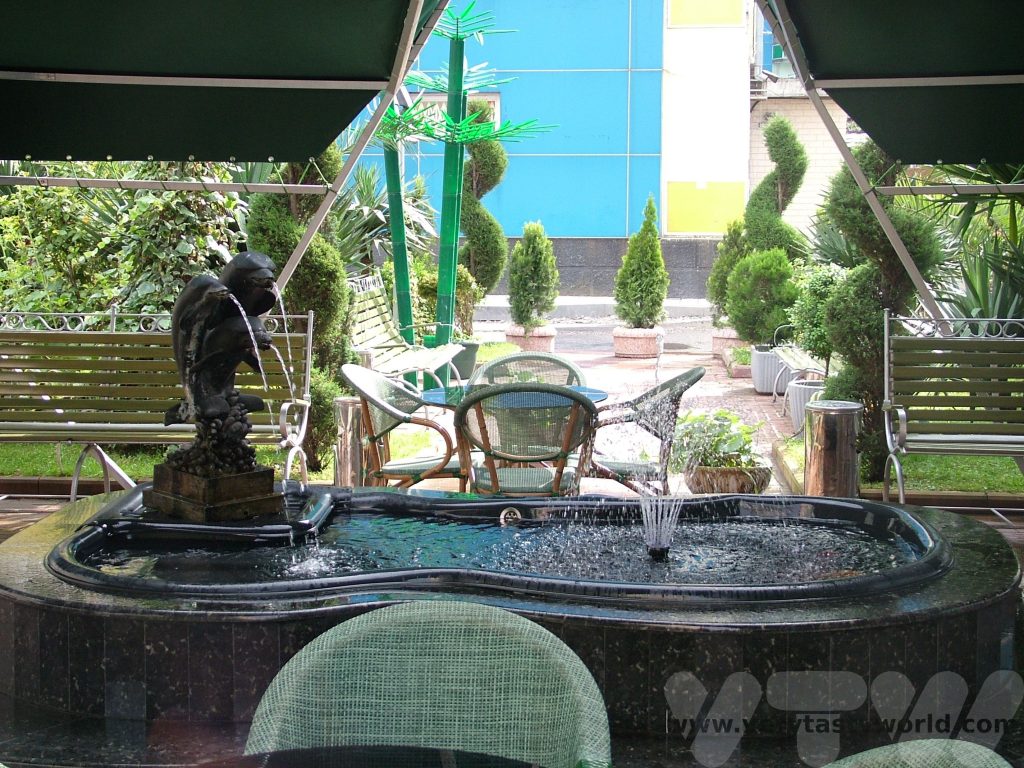
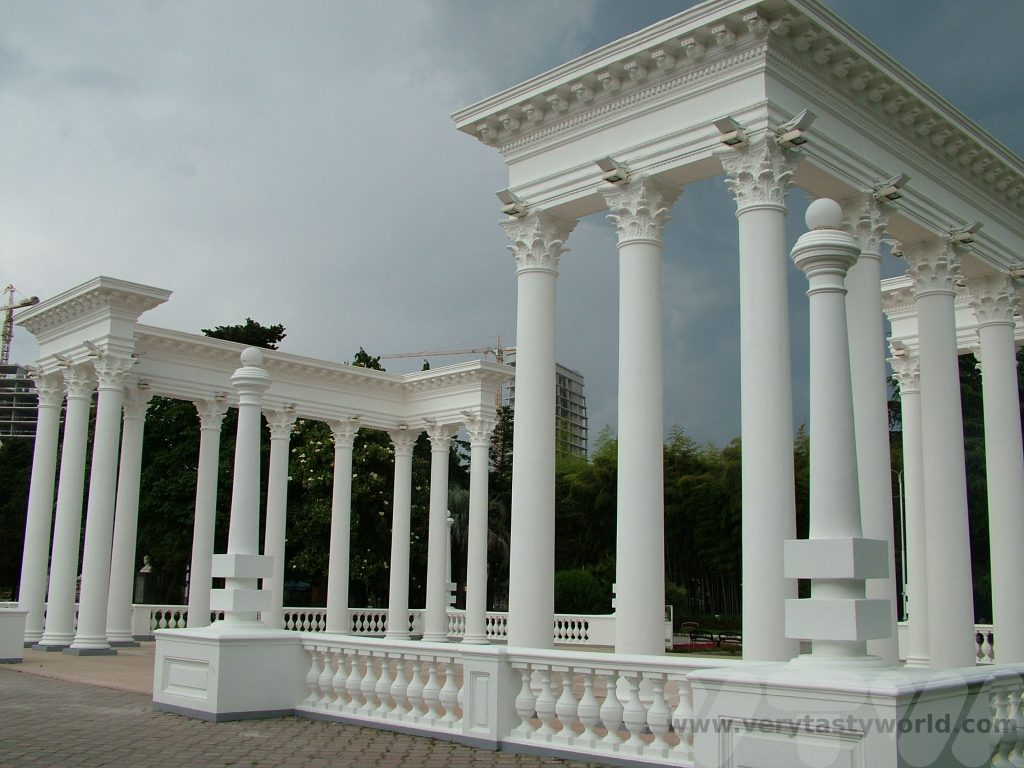
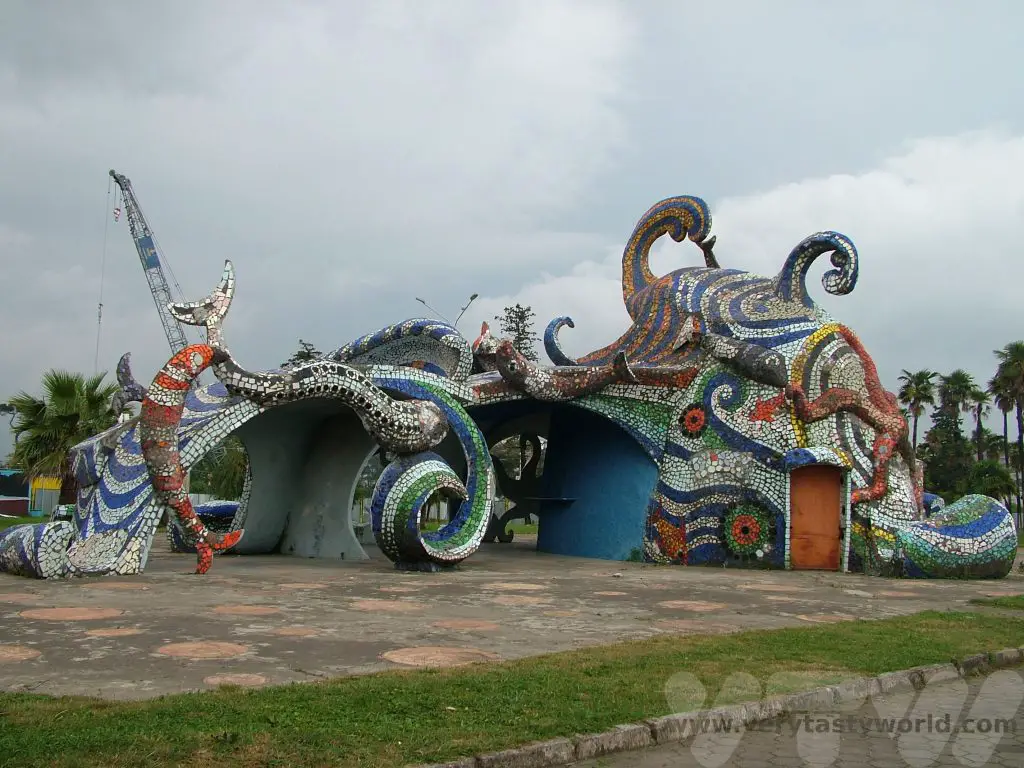
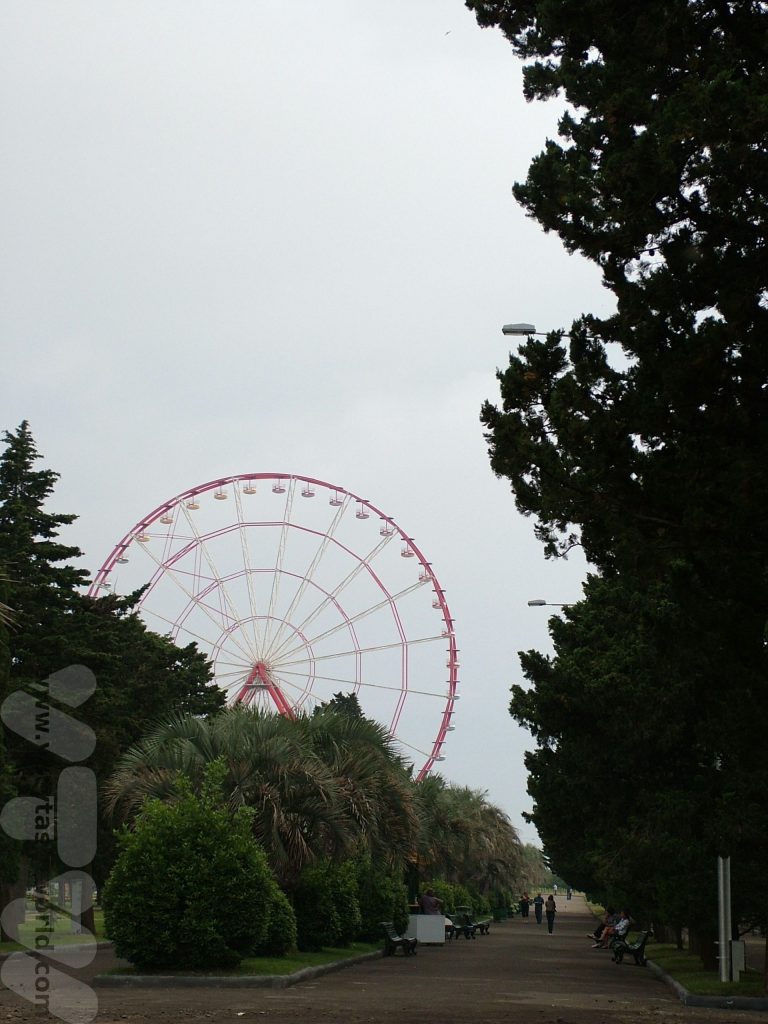
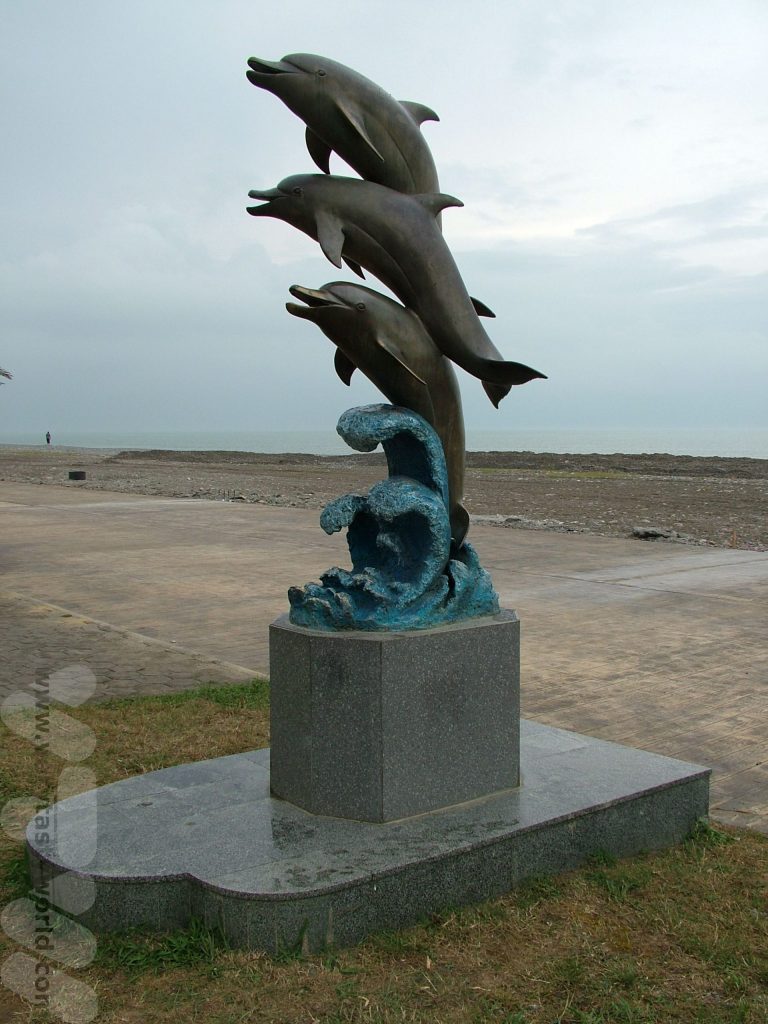
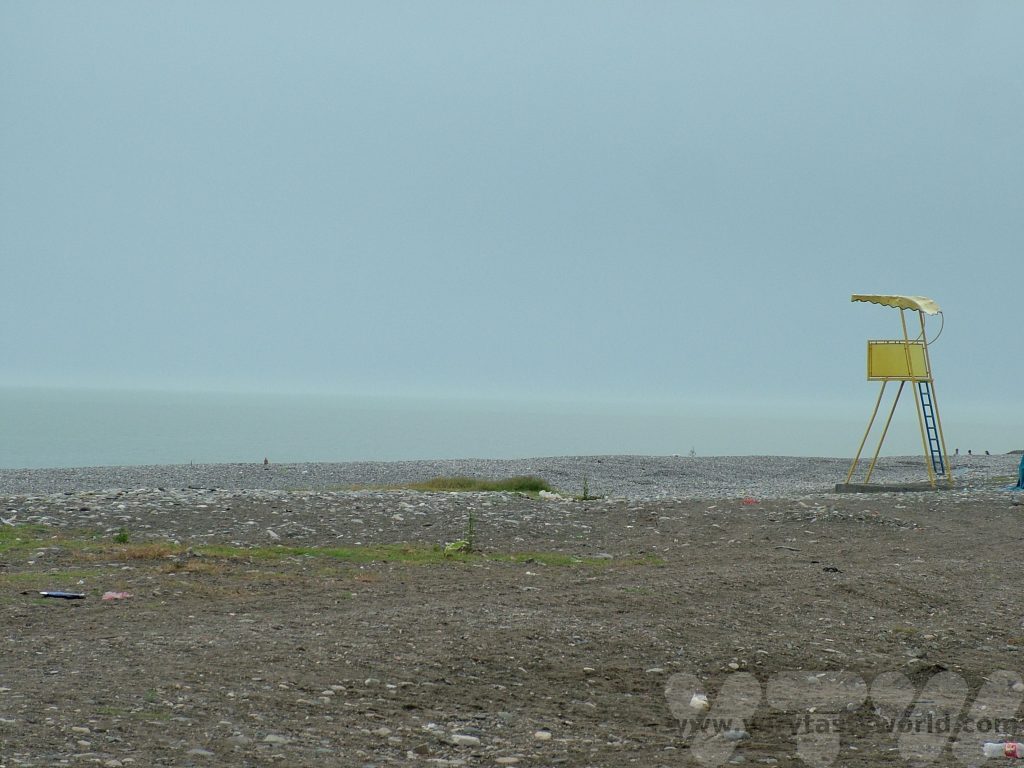
The Legendary Georgian Cheese Boat
It was in Batumi that we discovered the Georgian cheese boat, Acharuli Khachapuri, a monster from the Adjaran region. In keeping with Batumi’s flamboyant style, this is the daddy of cheese pies. It comprises a bread dough crust in the shape of a boat, filled with local cheese plus an egg and is topped off with an enormous knob of butter. You have to mix everything up (the egg cooks very slightly and the butter melts away so that you can pretend that it wasn’t there in the first place) so you end up with very buttery cheesy scrambled egg in a massive boat shaped piece of bread. It was suggested at the restaurant that we order a boat each. We insisted that we share one. One was more than enough but, oh, so delicious.
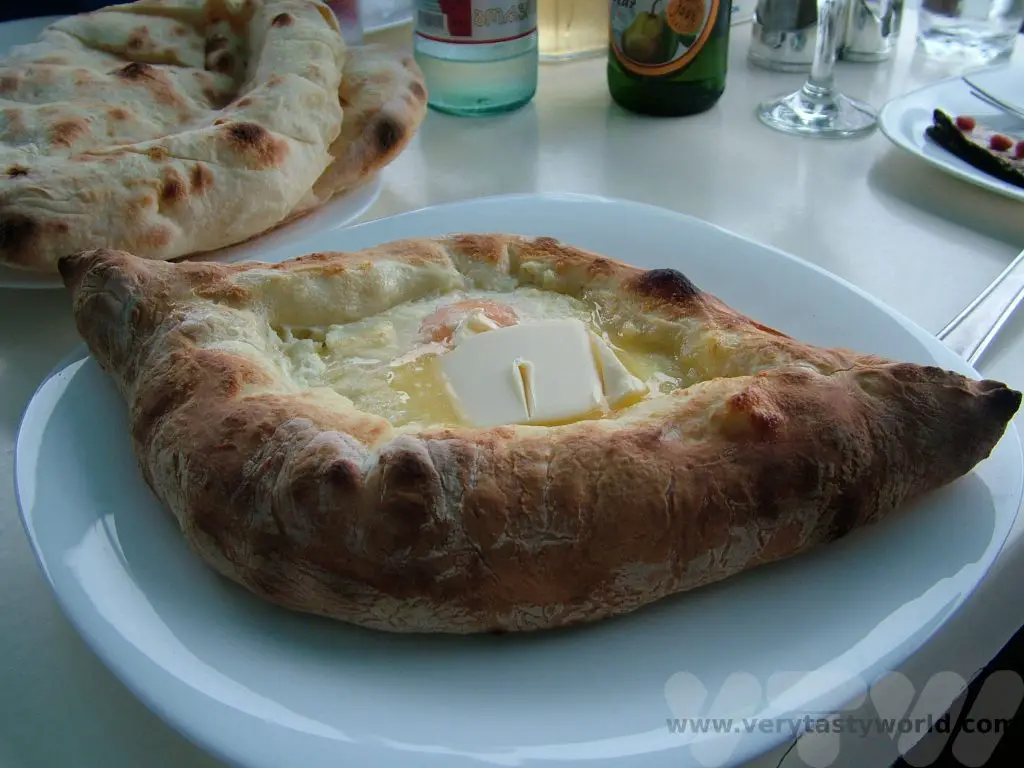
*Actually, it isn’t. Cheese tends to dull the palette, so if you’re serious about tasting wine you’re better off not eating anything at all and keeping your tastebuds in tip-top condition. But, of course, if you’re just out to have a good time, wine and cheese together is a delightful combination and entirely wonderful.
Related Posts You May Enjoy
Jordanian Dessert – Kanafeh at Habibah
Middle eastern desserts are not only delicious they are also quite addictive. One of the defining elements of a Jordanian dessert we tried when visiting the country was the sweet, sweet syrup that soaks into and pervades the pastry or dough that forms the base. The sweetness is probably a good thing as it does limit your ability to scoff vast quantities of these scrumptious sweets.
The magic ingredient in Kanafeh is cheese. Kanafeh comprises pastry or dough, saturated in syrup and layered with a very slightly salty cheese, traditionally nabulsi or akkawi, which adds a comforting and savoury contrast to counterbalance the sweetness. Kanafeh can take a variety of forms – some use vermicelli type noodles as the base, others a pastry type dough. The syrup can be flavoured with rose or orange water to give a light fragrance to the dessert.
Habibah in Amman have been in business for several decades. It’s easy to see why. They specialise in Jordanian dessert and their kanafeh is superb.
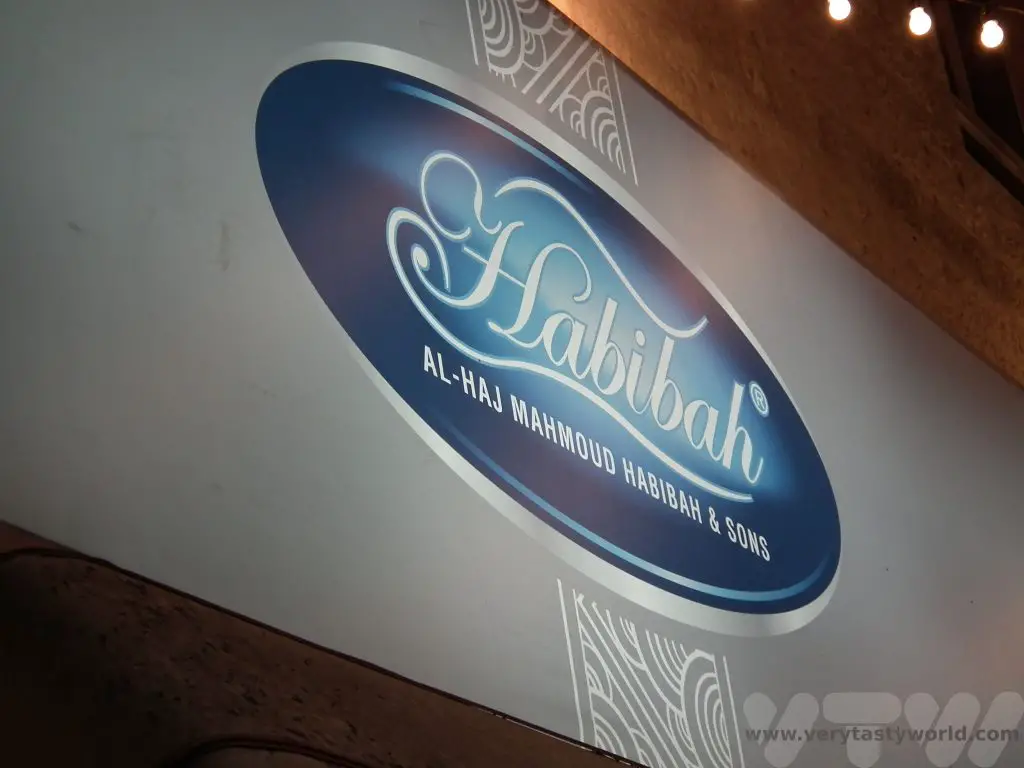
The kanafeh we tried was based on a pastry dough with layers of cheese. Topped off with pistachios for crunch and a nice green colour, and served warm, it is an absolutely delicious way to round off any meal. Or you could just order a really large portion and eat that instead of a meal – it’s worth it.
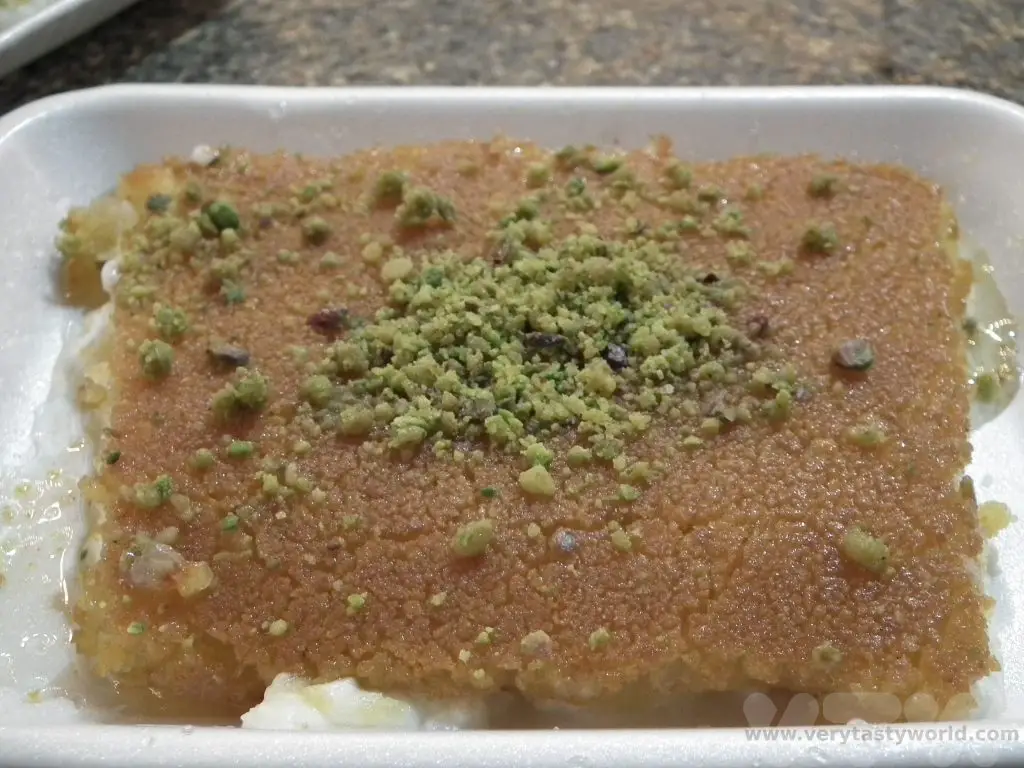
Related Posts You May Enjoy

Making Friends in a Conflict Zone
The Nagorno Karabakh region of Armenia is an area where there is territorial dispute with neighbouring Azerbaijan. Although it had been a war zone since the late 1980s a cease-fire had been established in 1994 and, when we travelled to Armenia a few years later, the local guide felt that it was safe to visit. Along with a group of other visitors we were invited to travel to the region to see the Noravank Monastery and the hotel we had been staying at, in Armenia’s capital Yerevan, threw in a picnic lunch.
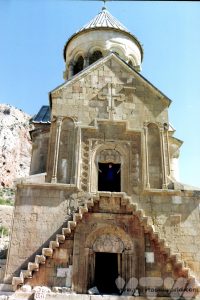
Noravank is a beautiful monastery, built in typical Armenian style. It contains a number of buildings, the dominant structure of which is Surb Astvatsatsin (Holy Mother of God). As with many Armenian monasteries there are a number of khachkars – carved stone slabs which each bear a cross – which can also been seen around the complex.
When we arrived at the site we discovered that we weren’t the only visitors. A local family were gathered together around a makeshift table and were clearly having a celebration. A fleece lay draped across the branches of a nearby tree, a sheep having been slaughtered at the site and was now roasting over a fire.
We know how we would feel if a coach-load of tourists turned up to a family celebration, that is, a bit miffed. But Armenia is still a relatively unusual destination and, when we visited, tourists were rare. We were welcomed with open arms.
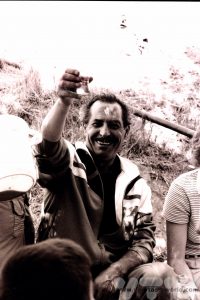
We had no idea what event the family were celebrating. We could speak about seven words of Armenian and they could speak no English. The family beckoned to us to join them. Of around twelve visitors in the tourist group, only we and one other joined the party. Such a shame – the other nine missed out on a fantastic celebration, totally their loss. (You can see the grumps in the background of the photo below, sitting on a hill, waiting for their hotel picnic and watching us having a good time.)
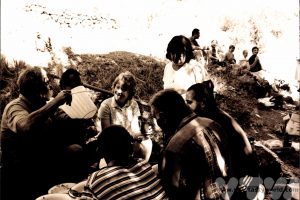
The family had clearly prepared – they had brought 40 buckets of home-made wine with them and they generously plied us with drink. We were offered barbequed lamb so fresh it had been bleating just hours earlier, flat breads, pickled walnuts, the freshest salads and fruit. All delicious. Food always tastes better with friends, even if you have only known them for minutes.
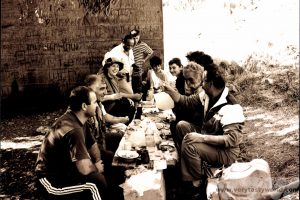
This happened over 20 years ago. We still have precious memories of that afternoon; of a most delicious meal, of gorging on wine, toasting a group of people who had been kind enough to invite some foreign visitors to their party, of being made to feel unbelievably welcome. We could not properly speak their language (although we were able to thank them in Armenian), they could not speak ours. We had no idea what the correct etiquette was, but we learned that day that communication does not have to be verbal. What we could express was our gratitude – with a huge smile, a raised glass and a farewell hug. We may have been picnicking in a region where there was a territorial dispute between two countries, but our experience quite simply reflected the very best of humanity.
